Index
This topic area covers statistics and information relating to cancer in Hull including local strategic need and service provision. Further information relating to the national screening programmes to detect breast, cervical and colorectal cancer are given within Screening and the NHS Health Check under Prevention within Adults.
This page contains information from the Office for Health Improvement & Disparities’ Fingertips. Information is taken ‘live’ from the site so uses the latest available data from Fingertips and displays it on this page. As a result, some comments on this page may relate to an earlier period of time until this page is next updated (see review dates at the end of this page).
In July 2022, Clinical Commissioning Groups (CCGs) ceased to exist and were replaced by the Integrated Care System. The sub Integrated Care Board areas which include Hull are within the Humber and North Yorkshire Integrated Care Board. In Fingertips, the sub-ICB area referenced by 03F relates to Hull (see Integrated Care Board for the codes relating to the other local sub-ICB areas). For some indicators on Fingertips and other data given elsewhere, data is still being presented at CCG level (and for Humber, Coast and Vale) and has not yet been updated for sub-ICBs. However, for Hull the geographical area for the CCG and the sub-ICB area (03F) are the same so the information can still be examined and compared to understand the health needs within Hull.
As at the beginning of May 2025, the latest available data for incidence and deaths by cancer site at sub-Integrated Care Board level is for 2018-20. However, this information is due to be updated “in the next couple of months” so it is anticipated that some of the existing data on this page can be updated soon. However, in October 2025, the data is still not available. Information was presented at ward level from Fingertips (for 2015-19 for incidence and for 2016-20 for mortality) but it appears that this data will not be updated, and has been replaced with data at a different geographical level (middle layer super output areas).
Headlines
- One in two people will develop some form of cancer during their lifetime.
- The high current and historical prevalence of smoking, and increased levels of poor diet, physical inactivity and obesity result in higher levels of cancer in Hull.
- People in Hull are more likely to present with their cancer in an emergency setting rather than through their GP or through an elective procedure, and a slightly higher percentage of cancers in Hull are diagnosed at a later stage at diagnosis compared to people throughout the rest of England which impacts on survival and mortality rates. Urgent referrals for cancer (two week wait) are lower in Hull compared to England particularly when considered in relation to the incidence rate of some cancers for Hull.
- In Hull, during the three year period 2018-20, there were 2,261 new cases of cancer which were diagnosed among men and 2,133 new cases of cancer diagnosed among women. Among men, prostate cancer accounted for the most new cancers diagnosed (501) followed by lung cancer (411) and colorectal cancer (254). Among women, new cases of breast cancer was the highest (549) followed by lung cancer (372) and colorectal cancer (221). The incidence rate of new cases of cancer in Hull is significantly higher than England particularly so for cancers of the lung (70% higher than England), stomach (60% higher than England) and kidney (34% higher than England). Overall, the cancer incidence in Hull was 15% higher than England for 2018-20.
- North Carr, West Carr, Orchard Park, Ings, Longhill & Bilton Grange, Sutton, Marfleet, St Andrew’s & Docklands, Pickering and Central all have statistically significantly higher incidence rates compared to England, and 16 out of Hull’s 21 wards have statistically significantly higher incidence rates for lung cancer with North Carr, Orchard Park, Marfleet, St Andrew’s & Docklands and Central having more than twice the rate of new lung cancer cases compared to England. Only Holderness has a statistically significantly higher rate of new colorectal cancers, and only Marfleet has a statistically significantly higher rate of new prostate cancer cases compared to England.
- In Hull, over the last 18 years between 2001-03 and 2018-20, the rate of new cancers diagnosed has decreased by 1% among men and increased by 15% among women. Over the same period, new cases of lung cancer reduced by 16% for men but increased by 21% for women, and new cases of colorectal cancer have reduced by 21% for men but increased by 24% for women. The rate of new cases of breast cancer has increased slightly among women in Hull by 5%, and the number of new cases of prostate cancer diagnosed has increased by 5% among men over the 18 year period.
- During 2022, just over half (53.1%) of cancers were diagnosed at an early stage compared to 56.8% for England.
- For deaths registered during the three year period 2022-24, the premature (under 75 years) mortality rates were around one-third higher in Hull compared to England for both men and women with a total of 1,037 premature cancer deaths over the three year period (574 men and 463 women).
- Premature mortality rates for cancer have been gradually reducing in Hull in the last 20 years or so with a relatively consistent downward trend (albeit with a slight ‘blip’ during the COVID-19 pandemic).
- For deaths registered during 2020 to 2023, mortality rates were statistically significantly higher than England in the majority of Hull’s 21 wards for both mortality at all ages and under 75 years. There was a very strong association with deprivation with under 75 year cancer mortality 1.7 times higher among people living in the most deprived areas compared to the least deprived areas of Hull (and two times higher for cancer deaths considered to be preventable).
- Whilst there is an inequalities gap in relation to premature cancer mortality between Hull and England, the inequalities gap for premature cancer mortality from causes considered to be preventable is greater. Premature cancer mortality rates are 34% higher in Hull for 2022-24, but are 51% higher for premature cancer mortality from causes considered to be preventable.
- In Hull for 2018-20, the highest proportion of cancer deaths were due to lung cancer for both men (28%) and women (27%) followed by breast cancer deaths for women (15%), prostate cancer deaths for men (13%) and colorectal cancer deaths for men (10%) and women (9%).
- Compared to England for 2018-20, mortality in Hull was particularly high for cancers of the lung (72% higher), stomach (66% higher), breast (29% higher) and oesophagus (22% higher).
- With high historical and current levels of smoking among Hull residents, the mortality rate for lung cancer is particularly high being highest for men and fourth highest among women across England’s 151 upper-tier local authorities for 2021-23.
- Whilst the mortality rate from both lung cancer and colorectal cancer has reduced among Hull men over the last two decades, reductions have been smaller for Hull women. The under 75 mortality rate for breast cancer among women had reduced in Hull over time. The mortality rate for prostate cancer among Hull men was generally lower than England prior to 2015-17, but has increased in Hull and is currently statistically significantly higher than England for 2021-23.
- One year cancer survival is available for cancers diagnosed between 2004-19 with one year follow-up to the end of 2020. Survival rates have increased over the period from 64.4% to 74.6%. It is difficult to directly compare to survival rates for England as the incidence and survival rates differ by cancer site and the percentage of different cancers by site differs between Hull and England. Nevertheless for the specific cancers of lung cancer survival rates have improved in Hull increasing by 49% from 30.4% for cancers diagnosed in 2004 to 45.2% for cancers diagnosed in 2019, although survival is higher in England for cancers diagnosed in 2019 (47.2%) and the increase in survival over the entire period has been higher in England (increased by 70%). One year survival from colorectal cancer has also improved from 70.8% in 2004 to 77.3% in 2019, but has been consistently lower than England over the period with a 3.6 percentage point difference for 2019 (England 80.9%), although the improvement in Hull over the entire period has been higher than the increase for England (increases of 9% and 7% respectively). One year survival from breast cancer diagnosed in 2019 is high at 94.1% having increased by 0.6% from 93.5% since 2004. However, the rate of increase for England has been much higher having increased by 3.2% from 94.3% to 97.3%. Thus the inequalities gap in one year survival between Hull and England has increased in relation to lung and breast cancers as well as the index measure which includes most cancers.
The Population Affected – Why Is It Important?
All Cancers
Cancer is a condition where cells in a specific part of the body grow and reproduce uncontrollably destroying healthy tissue including organs and can spread to other parts of the body (metastasis). There are over 200 different types of cancer, each with its own methods of diagnosis and treatment. One in two people will develop some form of cancer during their lifetime. In the UK, the four most common types of cancer are: lung cancer; breast cancer; prostate cancer; and bowel cancer. Treatment is often simpler and more likely to be effective when cancer is diagnosed at an early stage, so finding cancer early can make a real difference. There are two major components of early detection of cancer: education to promote early diagnosis and screening. With the ageing population, it is likely that the incidence and prevalence of cancer will increase.
Healthy eating, taking regular exercise, maintaining a healthy weight, and not smoking helps lower the risk of developing cancer. Changing lifestyle behaviours can have a dramatic effect.
Cancer Research UK have an infographic which illustrates the risk of cancer.
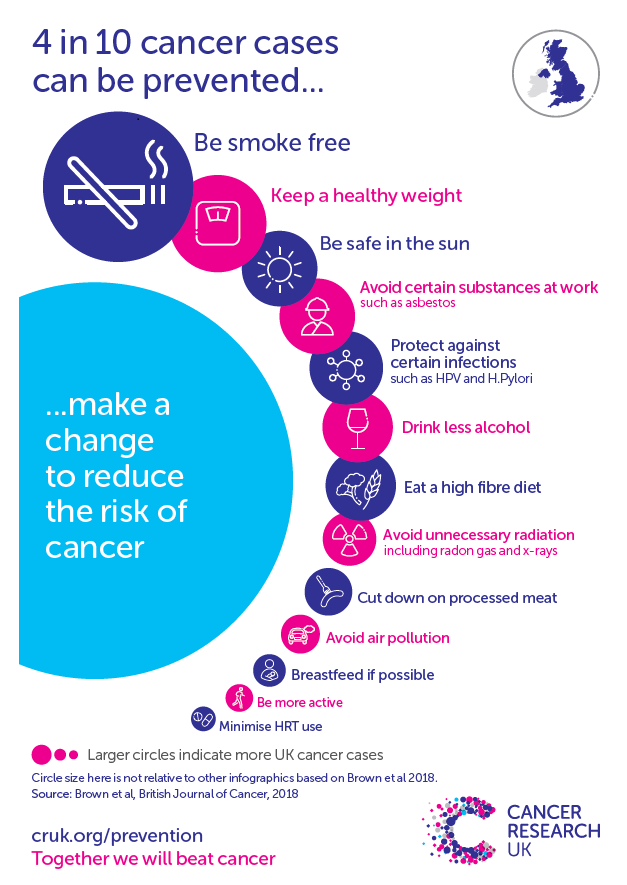
Screening programmes are in place for cancers of the breast, cervical and bowel (colorectal). Uptake rates for screening can be found in Screening and the NHS Health Check under Prevention within Adults.
Lung Cancer
The majority of lung cancer cases are preventable as it is estimated that 81% of all cases of lung cancer are directly attributable to smoking, and risk of developing lung cancer reduces over time once a smoker quits smoking.
Nationally, lung cancer has the fifth highest disability adjusted life years and thus has a substantial impact on the quality of people’s lives.
Prostate Cancer
The causes of prostate cancer are largely unknown. Prostate cancer can be slow to develop. So there are many men die with prostate cancer, not because of it. Despite this, there are still considerable numbers that do die from prostate cancer, and it is the most frequent cancer among men.
Breast Cancer
Whilst the causes of breast cancer are not fully understood, it is not possible to know if it can be prevented altogether. However, although not definitive, there are benefits for women who maintain a healthy weight, exercise regularly and who have a low intake of saturated fat and alcohol. Being overweight or obese, particularly after the menopause, causes more oestrogen to be produced which can increase the risk of breast cancer. Family history is also an important risk factor for breast cancer. Screening for breast cancer is the single biggest factor that allows for early diagnosis. Among women, breast cancer is the most frequently occurring cancer.
Colorectal Cancer
There is an increased risk of bowel cancer among those aged 60+ years, who eat a diet high in red or processed meats and low in fibre, who are overweight or obese, physical inactive or smokers, have a high alcohol intake, have a family history of bowel cancer, or have another medical conditions such as severe ulcerative colitis or Crohn’s disease.
The Hull Picture
Screening
Further information relating to the national screening programmes to detect breast, cervical and colorectal cancer are given within Screening and the NHS Health Check within Prevention under Adults.
Incidence
By Cancer Site
From the National Cancer Registration and Analysis Service, the table below gives the total number of new cancers diagnosed over the three year period 2018-20 for Hull Clinical Commissioning Group (CCG) by cancer site for men and women separately. The International Classification of Disease version 10 codes has been included for each cancer site for reference. Not all cancer sites are included (most have too smaller numbers to present including male cases of breast cancer) so the figures for each individual cancer site do not sum to the total.
Over the three year period 2018-20, there were 4,349 new cases of cancer excluding non-melanoma skin cancer (NMSC) that were diagnosed giving an average of 1,450 new diagnoses each year.
Lung, breast, prostate and colorectal cancers were the most commonly occurring cancers in Hull over the three year period.
| Cancer site | ICD 10 code | Males | Females | Persons |
| Oesophagus | C15 | 63 | 39 | 102 |
| Stomach | C16 | 66 | 32 | 98 |
| Colorectal | C18-C20 | 254 | 221 | 475 |
| Liver and intrahepatic bile ducts | C22 | 42 | 26 | 68 |
| Pancreas | C25 | 62 | 52 | 114 |
| Trachea, bronchus and lung | C33-C34 | 411 | 372 | 783 |
| Breast | C50 | 549 | ||
| Cervical | C53 | 39 | 39 | |
| Uterus | C54-C55 | 111 | 111 | |
| Ovary | C56-C57 | 76 | 76 | |
| Prostate | C61 | 501 | 501 | |
| Kidney, except renal pelvis | C64 | 93 | 64 | 157 |
| Bladder | C67 | 81 | 37 | 118 |
| Non-Hodgkin lymphoma | C82-C86 | 91 | 66 | 157 |
| Multiple myeloma and plasma cell neoplasms | C90 | 35 | 26 | 61 |
| Leukaemia | C91-C95 | 57 | 34 | 91 |
| All cancers excluding NMSC | C00-C97 excl C44 | 2,261 | 2,133 | 4,349 |
The table below gives the standardised incidence rate so compares the number of new cases in Hull with England after adjusting for the age structure of Hull’s population. The incidence rates are given as the number of new cancers diagnosed within the three year period 2018-20 per 100,000 person-years. For most cancers, the numbers are relatively small so it is not possible to examine incidence for males and females separately.
The rates are substantially higher in Hull for lung cancer, being 71% higher than England for men and 69% higher for women. Rates are also substantially higher for stomach cancer (60% higher than England) and kidney cancer (34% higher than England). Incidence rates are also higher in Hull compared to England for cancers of the oesophagus, colon and rectum, liver and intrahepatic bile ducts, pancreas, cervical, uterus and bladder as well as non-Hodgkin’s lymphoma.
Compared to England, the age-standardised incidence rate was lower in Hull for cancers of the skin, breast, ovary and prostate as well as multiple myeloma and malignant plasma cell neoplasms, and leukaemia.
Overall, the incidence of all cancers in Hull compared to England is 15% higher for men and women combined (13% higher for men and 17% higher for women).
| Cancer site | ICD 10 code | Gender | Hull | England |
| Oesophagus | C15 | Persons | 16.2 | 14.3 |
| Stomach | C16 | Persons | 15.7 | 9.8 |
| Colorectal | C18-C20 | Males | 85.5 | 81.6 |
| Colorectal | C18-C20 | Females | 65.6 | 55.5 |
| Colorectal | C18-C20 | Persons | 75.0 | 67.5 |
| Liver and intrahepatic bile ducts | C22 | Persons | 10.6 | 10.3 |
| Pancreas | C25 | Persons | 18.0 | 17.3 |
| Trachea, bronchus and lung | C33-C34 | Males | 142.1 | 83.1 |
| Trachea, bronchus and lung | C33-C34 | Females | 111.5 | 65.9 |
| Trachea, bronchus and lung | C33-C34 | Persons | 125.5 | 73.4 |
| Malignant melanoma of skin | C43 | Persons | 17.4 | 26.6 |
| Breast | C50 | Females | 157.7 | 161.3 |
| Cervical | C53 | Females | 10.5 | 9.3 |
| Uterus | C54-C55 | Females | 32.7 | 28.8 |
| Ovary | C56-C57 | Females | 21.5 | 22.6 |
| Prostate | C61 | Males | 171.2 | 181.2 |
| Kidney, except renal pelvis | C64 | Persons | 24.2 | 18.1 |
| Bladder | C67 | Persons | 19.1 | 16.5 |
| Non-Hodgkin lymphoma | C82-C86 | Persons | 24.1 | 21.1 |
| Multiple myeloma and plasma cell neoplasms | C90 | Persons | 9.6 | 9.8 |
| Leukaemia | C91-C95 | Persons | 14.0 | 15.2 |
| All cancers | C00-C97 excl C44 | Males | 742.8 | 658.3 |
| All cancers | C00-C97 excl C44 | Females | 622.5 | 531.0 |
| All cancers | C00-C97 excl C44 | Persons | 674.9 | 586.6 |
Over the last 17 years between 2001-03 and 2017-19, the incidence rate of all cancers has increased by 5% for men and by 17% for women, although between 2017-19 and 2018-20 there has been a decrease in the incidence of 6% for men and 2% for women which might be associated with fewer new cases of cancers being detected between March and December 2020 because of the COVID-19 pandemic.
Overall, between 2001-03 and 2018-20, there has been a decrease in cancer incidence of 1% among men, but an increase of 15% among women.
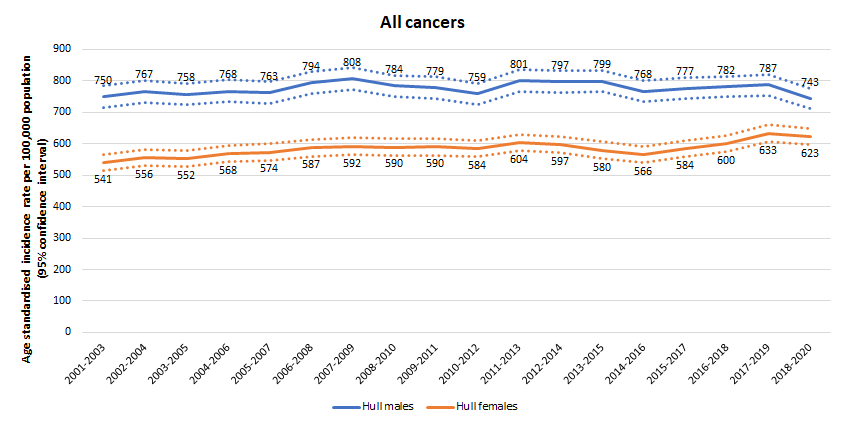
In 2018-20, the standardised incidence rate for all cancers was 12% higher in Hull compared to England for men and 17% higher for women. For men, the cancer incidence rate in Hull has followed a reasonably similar pattern to that for England. For women, the incidence rate increased gradually in both Hull and England to the period 2011-13 to 2013-15, but the latest rate for 2018-20 is higher than 2011-13 for Hull whereas for England has decreased in the last five years.
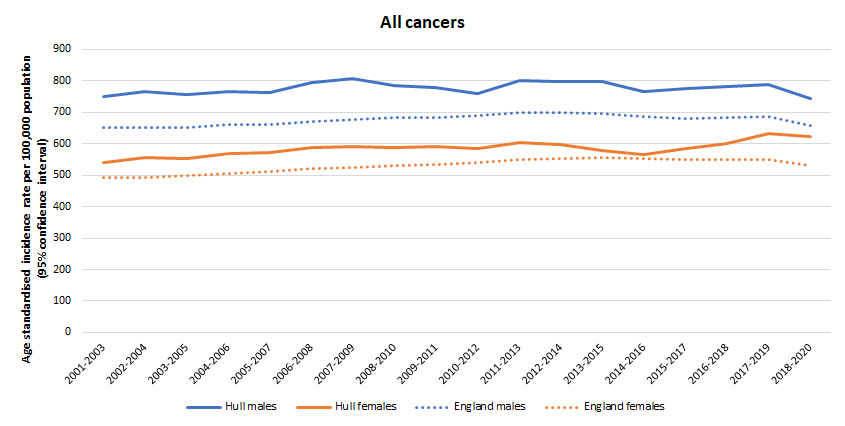
Lung Cancer
For lung cancer among Hull men, the incidence rate has fallen by 16% over the last 18 years between 2001-03 and 2018-20.
Among Hull women, over the 17 years between 2001-03 and 2017-19, the lung cancer incidence rate increased by more than one-third (34%). However, the rate decreased by 9% in the latest year which could be associated with the COVID-19 pandemic and fewer new cancers being diagnosed. Therefore, over the entire 18 year period between 2001-3 and 2018-20, the lung cancer incidence rate had increased by more than one-fifth for Hull women (21%).
The lung cancer incidence rate was 83% higher among Hull men compared to Hull women in 2001-03, but the rate is only 27% higher in 2018-20.
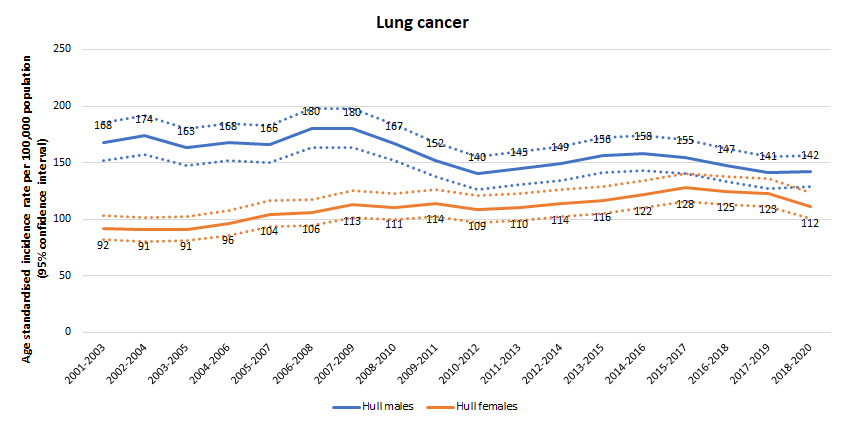
The age standardised incidence rate per 100,000 population for lung cancer is statistically significantly higher than England with the rate being very much higher in Hull. The latest incidence rate is 71% higher in Hull compared to England (71% higher for men and 69% higher for women).
There is more variability in the lung cancer incidence rate in Hull, but there has been a reasonably similar rate of change with England for both men (-16% versus -20%) and women (+21% versus +24%).
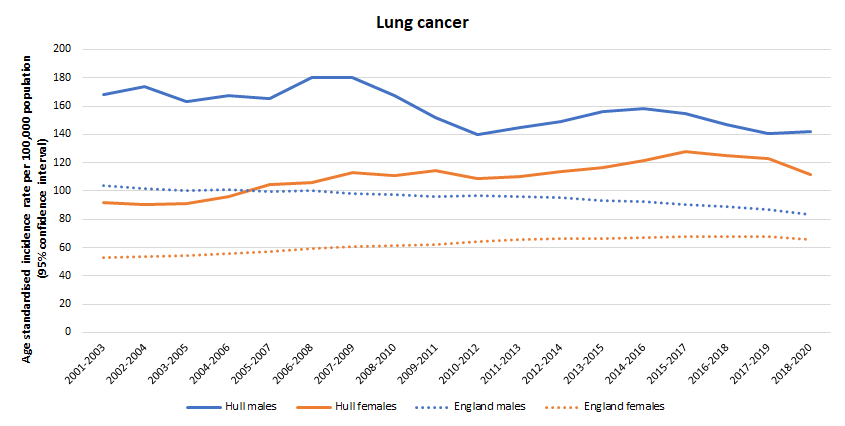
Colorectal Cancer
For colorectal cancer, the age standardised incidence rates among Hull men have been consistently and statistically significantly higher than the rates among Hull women. Over the 18 year period, there has been a reduction of 21% in the incidence rate for colorectal cancer for men, but for women the incidence of colorectal cancer has increased by 24%.
In Hull, the rate of new cases of colorectal diagnosed among men within 2001-03 was more than double the rate in women, but for cancers diagnosed within 2018-20, the rate was only 30% higher among men compared to women.
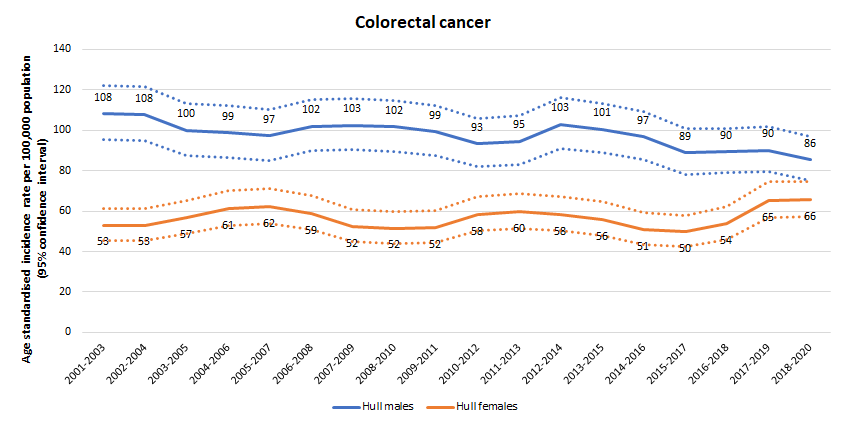
There has been no statistically significant difference in the incidence rate for colorectal cancer between Hull and England over the last 18 years with the exception of men for 2001-03 and 2002-04.
The rate of decrease in the incidence rate has been much greater in Hull compared to England among men (-21% versus -3%) and among women the increase in the incidence rate in Hull has been much greater than England (+24% versus +2%).
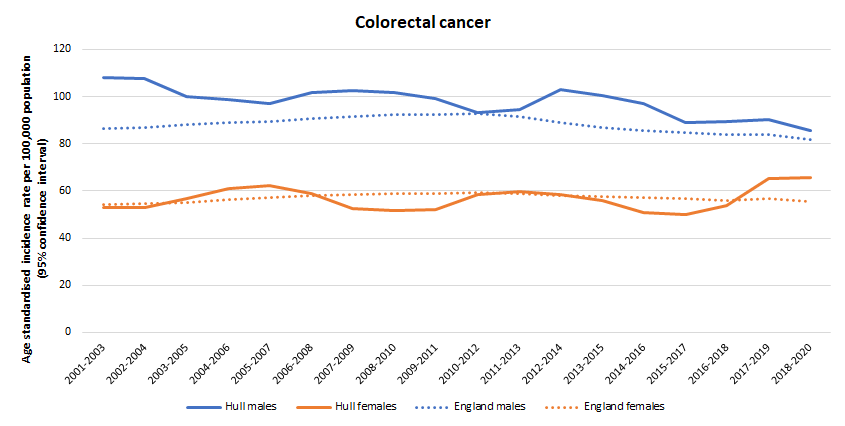
Breast Cancer
The incidence rate for breast cancer among women has varied between 140 and 160 per 100,000 population over the last 18 years, but the rate in 2017-19 reached a new high of 166 per 100,000 population, although decreased to 158 per 100,000 population for 2018-20.
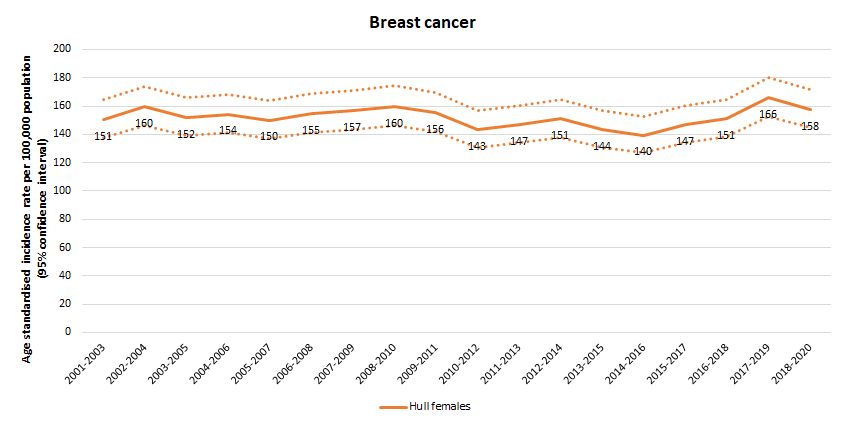
The incidence of breast cancer has generally been lower than England over the 18 year period. The latest rate for Hull for 2018-20 is similar to England (158 versus 161 per 100,000 population). The rate of change over the last 17 years has also been similar for Hull (+5%) and England (+4%).
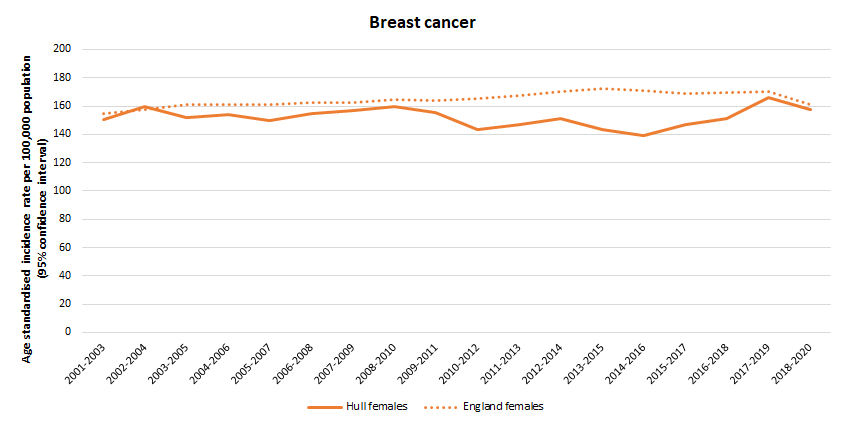
Prostate Cancer
Over the last 17 years between 2001-03 and 2018-20, the incidence of prostate cancer has increased in Hull by 33%, although there was a fall of 10% in the last year, so the overall change over the entire period is 20%.
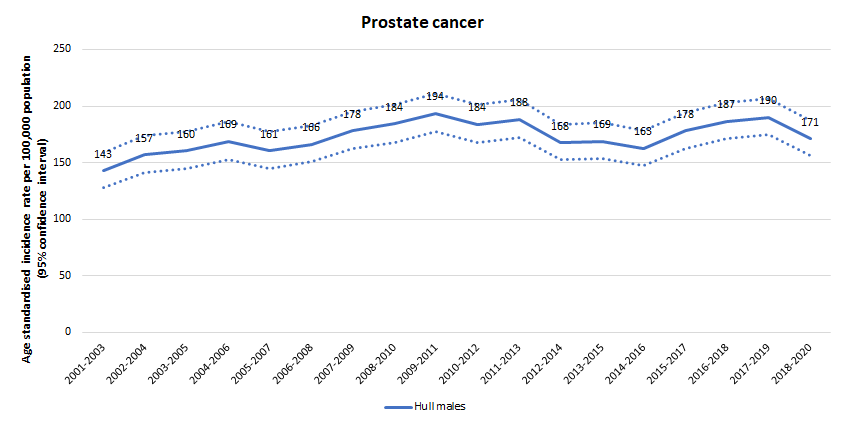
The incidence rate for prostate cancer has been reasonably similar in Hull to the rate in England over the entire 18 year period, and the rate in Hull is currently slightly lower than England (171 versus 181 per 100,000 population respectively).
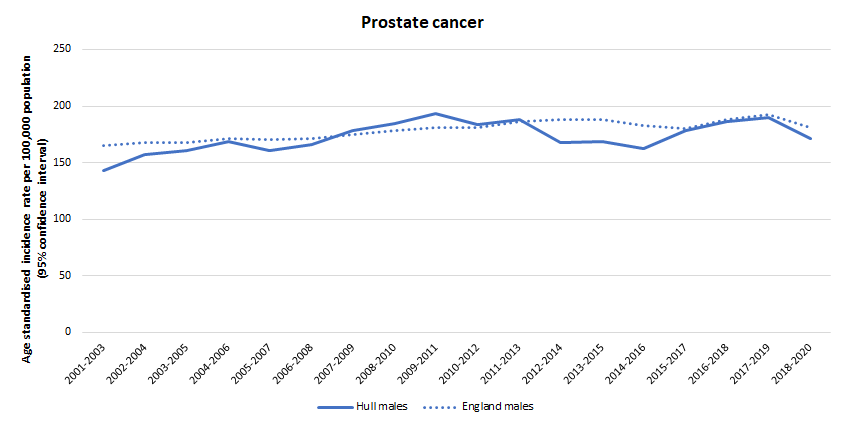
Rates Across Hull’s Wards
Within the Office for Health Improvement & Disparities’ Local Health, the standardised incidence ratios are given for each electoral ward for all cancers, colorectal cancer, lung cancer, breast cancer and prostate cancer. The incidence ratio gives the rate of new cases of cancers that have been diagnosed within the time period for Hull compared to England. The data presented below relates to the five year period 2015-19 and the standardised incidence ratios are given together with 95% confidence intervals (which gives a range of values where the true value is likely to fall taking into account random variation). The standardised incidence ratios are standardised to England with the ratio for England being 100 for the period 2015-19. So that any ratio above 100 denotes that the ward has a higher incidence rate for the specific cancer compared to England for the period 2015-19, and a ratio below 100 denotes a lower incidence rate.
If the 95% confidence interval does not contain the value of 100, this means that the incidence rate for the ward is statistically significantly different from England after allowing for differences in the age structure between Hull and England.
All Cancers
The lower 95% confidence limit for Central, North Carr, Orchard Park, West Carr, Ings, Longhill & Bilton Grange, Sutton, Marfleet, St Andrew’s & Docklands and Pickering wards were all higher than 100 so the cancer incidence rate – after adjusting for the age distribution of the ward – was statistically significantly higher than England.
Marfleet and Central had the highest new rate of cancers diagnosed in 2015-19 in Hull which were more than 20% higher than the incidence rate in England.
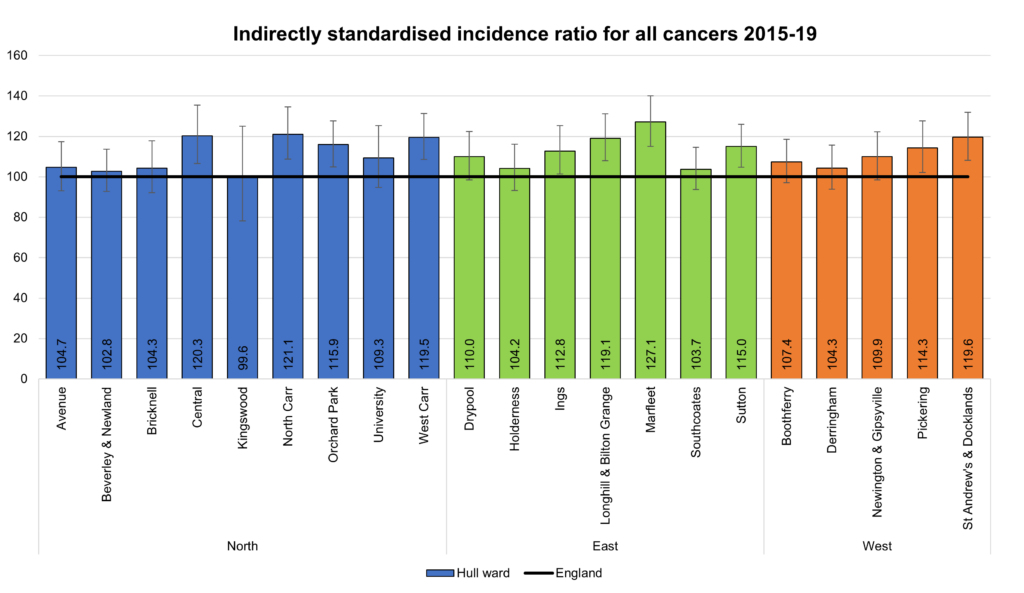
Lung Cancer
The cancer incidence rate for lung cancer was statistically significantly higher than England after adjusting for the age structure of the local population for 16 of Hull’s 21 electoral wards. The 95% confidence interval contains the value of 100 for only Avenue, Beverley & Newland, Bricknell, Kingswood and Holderness wards.
The rate of new lung cancer cases was more than twice as high as England for Central, North Carr, Orchard Park, Marfleet and St Andrew’s & Docklands wards.
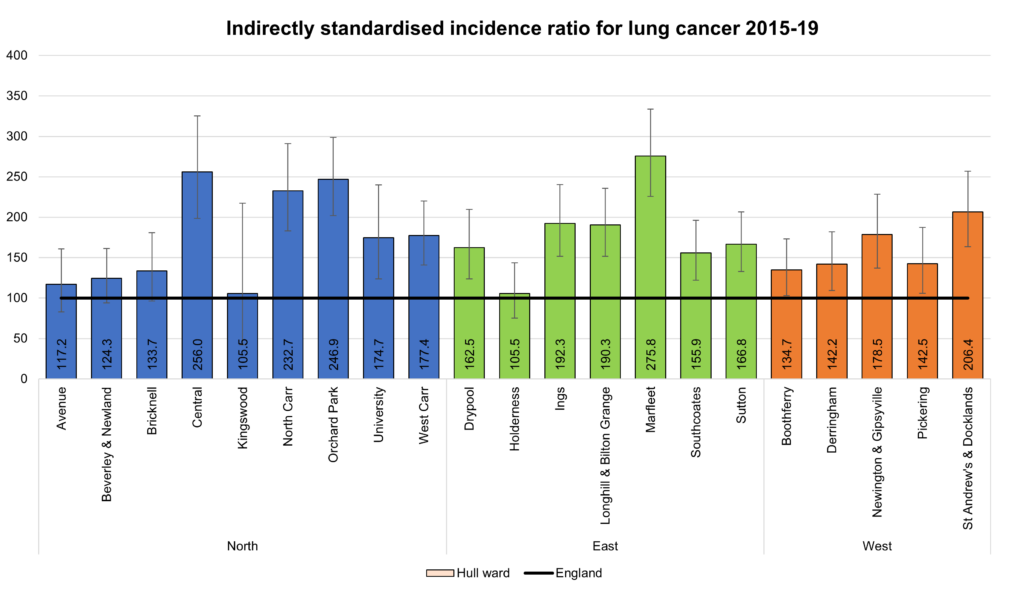
Colorectal Cancer
For the majority of wards in Hull, the number of new cases of colorectal cancer was not statistically significantly different than England with the only exception being Holderness ward, where the rate was 44% higher than England.

Breast Cancer
The rate of new cases of breast cancer was lower than England for the majority of wards in Hull with Ings and Southcoates wards also having statistically significantly lower incidence rates of breast cancer compared to England. None of Hull’s wards have a statistically significantly higher rate of new breast cancer cases compared to England.

Prostate Cancer
The incidence rate for prostate cancer was also lower than England for the majority of Hull’s wards and was statistically significantly lower for St Andrew’s & Docklands ward. In contrast, Marfleet ward had a statistically significantly higher rate of new prostate cancers compared to England. There were too few cases of new prostate cancer for Kingswood and University wards over the five year period 2015-19 so the standardised incidence ratio is not presented for these two wards.
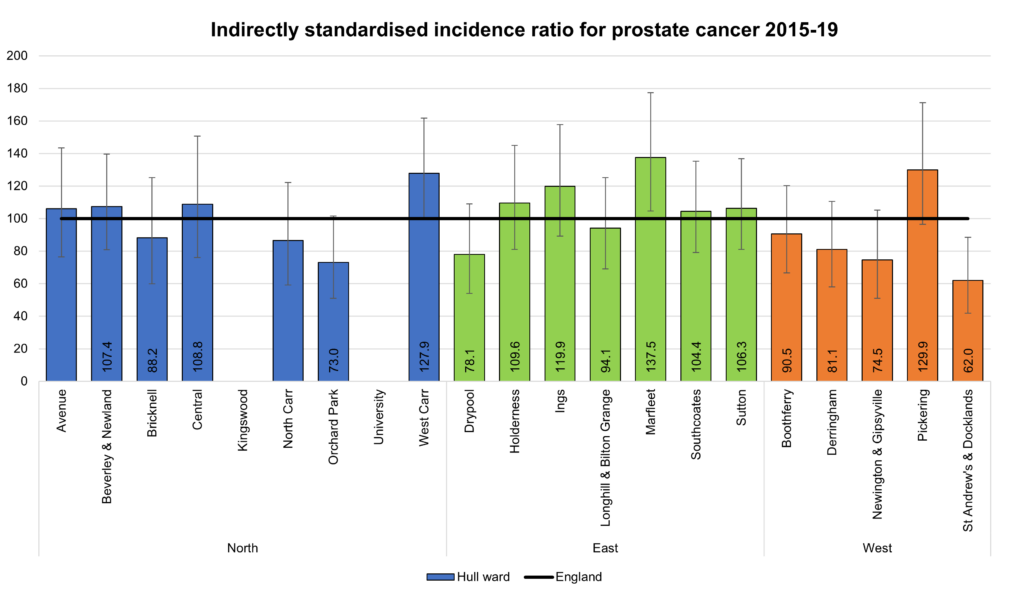
Prevalence
The Office for Health Improvement & Disparities’ Fingertips gives the percentage of patients registered with Hull GPs who are have been diagnosed with cancer since the 1 April 2004. For 2024/25, 3.3% of Hull’s (03F) registered population had had a cancer diagnosis since 1 April 2004 which was considerably lower than the Humber and North Yorkshire Integrated Care Board average and England.
Whilst the incidence of cancer is much higher in Hull, survival rates are generally lower, so this would account for the discrepancy between incidence and prevalence in Hull. Furthermore, incidence and survival rates differ by cancer site. Hull has a much higher incidence of lung cancer, and survival rates from lung cancer are lower than for many other cancer sites which further impacts on the prevalence.
Compared with benchmark
| Indicator | Period | England | NHS Humber and North Yorkshire Integrated Care Board - QOQ | Humber and North Yorkshire ICB - 02Y | Humber and North Yorkshire ICB - 03F | Humber and North Yorkshire ICB - 03H | Humber and North Yorkshire ICB - 03K | Humber and North Yorkshire ICB - 03Q | Humber and North Yorkshire ICB - 42D |
|---|---|---|---|---|---|---|---|---|---|
Cancer: QOF prevalence (Persons All ages) | 2024/25 | 3.8 | 4.5 | 5.6 | 3.3 | 4.0 | 4.1 | 3.9 | 5.1 |
| Indicator | Period | England | NHS Humber and North Yorkshire Integrated Care Board - QOQ | Humber and North Yorkshire ICB - 02Y | Humber and North Yorkshire ICB - 03F | Humber and North Yorkshire ICB - 03H | Humber and North Yorkshire ICB - 03K | Humber and North Yorkshire ICB - 03Q | Humber and North Yorkshire ICB - 42D |
|---|---|---|---|---|---|---|---|---|---|
Cancer: QOF prevalence (Persons All ages) | 2024/25 | 3.8 | 4.5 | 5.6 | 3.3 | 4.0 | 4.1 | 3.9 | 5.1 |
The percentage of patients who have had a cancer diagnosis since April 2004 has gradually increased over time which is what would be expected given that the indicator measures cancer diagnoses since a specific point in time. The cumulative total of patients should increase, particularly for cancers with a high survival rate.
The rate of increase in the indicator for Hull has shown a similar pattern to that of England and the Humber and North Yorkshire Integrated Care Board, although the percentage has been consistently lower in Hull. The number of registered patients with a cancer diagnosis since the 1 April 2004 has tripled between 2009/10 from 1,909 (1.1%) to 10,289 (3.3%) in Hull for 2024/25.
Compared with benchmark
Cancer: QOF prevalence (Persons All ages)
|
Period
|
Humber and North Yorkshire ICB - 03F |
NHS Humber and North Yorkshire Integrated Care Board - QOQ
|
England
|
||||
|---|---|---|---|---|---|---|---|
|
Count
|
Value
|
95%
Lower CI |
95%
Upper CI |
||||
| 2009/10 | • | 1909 | 1.1% | 1.1% | 1.2% | - | 1.4% |
| 2010/11 | • | 2341 | 1.4% | 1.3% | 1.4% | - | 1.6% |
| 2011/12 | • | 2667 | 1.5% | 1.5% | 1.6% | - | 1.8% |
| 2012/13 | • | 5081 | 1.7% | 1.7% | 1.8% | 2.3% | 1.9% |
| 2013/14 | • | 5604 | 1.9% | 1.9% | 2.0% | 2.5% | 2.1% |
| 2014/15 | • | 6028 | 2.1% | 2.0% | 2.1% | 2.7% | 2.3% |
| 2015/16 | • | 6463 | 2.2% | 2.1% | 2.2% | 2.9% | 2.4% |
| 2016/17 | • | 6857 | 2.2% | 2.2% | 2.3% | 3.0% | 2.6% |
| 2017/18 | • | 7345 | 2.5% | 2.4% | 2.5% | 3.3% | 2.7% |
| 2018/19 | • | 8013 | 2.7% | 2.6% | 2.7% | 3.6% | 3.0% |
| 2019/20 | • | 8444 | 2.8% | 2.7% | 2.8% | 3.7% | 3.1% |
| 2020/21 | • | 8646 | 2.8% | 2.8% | 2.9% | 3.8% | 3.2% |
| 2021/22 | • | 9032 | 2.9% | 2.9% | 3.0% | 4.0% | 3.3% |
| 2022/23 | • | 9625 | 3.1% | 3.0% | 3.2% | 4.1% | 3.5% |
| 2023/24 | • | 9895 | 3.1% | 3.1% | 3.2% | 4.3% | 3.6% |
| 2024/25 | • | 10289 | 3.3% | 3.2% | 3.3% | 4.5% | 3.8% |
Source: NHS England
From the local analysis of the national Quality and Outcomes Framework datasets, there was a statistically significant association between average age of the practice patients and the percentage of patients who have had a cancer diagnosis since 1 April 2004 across the 28 practices in Hull for 2023/24. If the practices were divided into five approximately equal sized groups based on average age of patients (with each fifth having approximately one-fifth of the total registered patients in Hull) then the prevalence increased from 1.6% for the practices serving the youngest practice patients to 4.0% for the practices serving the oldest practice patients. For every increase in the average age of the patients of 10 years, the percentage of patients who have had a cancer diagnosis since April 2004 increased by 2.3 percentage points. Further analysis of diagnosed disease by the average age of practice patients is within the file above and within Local Analysis of Quality and Outcomes Framework Data.
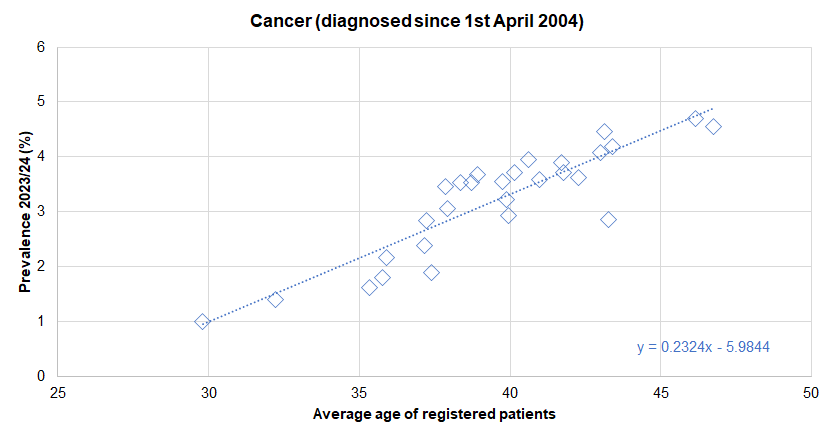
There was no statistically significant association between the percentage of patients who have had a cancer diagnosis since 1 April 2004 and the average deprivation score of registered patients (using the Index of Multiple Deprivation 2019) across the 28 practices.
Two week wait
The two week wait appointment system was introduced so that any patient with symptoms that might indicate cancer could be seen by a specialist as soon as possible. The Office for Health Improvement & Disparities’ Fingertips presents indicators relating to the two week wait for the sub Integrated Care Board areas which include Hull within the Humber and North Yorkshire Integrated Care Board. The sub-ICB area referenced by 03F relates to Hull (see Integrated Care Board for the codes relating to the other local sub-ICB areas).
In 2023/24, Hull had a lower number of two week wait referrals per 100,000 population compared to England (3,909 versus 4,770) and the percentage of cancers diagnosed from the two week wait referrals was also lower in Hull compared to England (5.7% versus 6.0%) as was the percentage of cancers treated out of those two week wait referrals (50.0% versus 55.7%).
Compared with benchmark
| Indicator | Period | England | NHS Humber and North Yorkshire Integrated Care Board - QOQ | Humber and North Yorkshire ICB - 02Y | Humber and North Yorkshire ICB - 03F | Humber and North Yorkshire ICB - 03H | Humber and North Yorkshire ICB - 03K | Humber and North Yorkshire ICB - 03Q | Humber and North Yorkshire ICB - 42D |
|---|---|---|---|---|---|---|---|---|---|
Urgent suspected cancer referrals (Persons All ages) | 2023/24 | 4770 | 4505 | 5419 | 3909 | 3796 | 4389 | 3991 | 5040 |
Urgent suspected cancer referrals resulting in a diagnosis of cancer (Conversion rate: as % of all USC referrals) (Persons All ages) | 2023/24 | 6.0 | 7.4 | 7.3 | 5.7 | 7.6 | 6.0 | 8.6 | 8.2 |
New cancer cases treated resulting from an urgent suspected cancer referral (Detection rate: % of all new cancer cases treated) (Persons All ages) | 2023/24 | 55.7 | 53.2 | 53.2 | 50.0 | 53.8 | 48.9 | 51.7 | 56.8 |
| Indicator | Period | England | NHS Humber and North Yorkshire Integrated Care Board - QOQ | Humber and North Yorkshire ICB - 02Y | Humber and North Yorkshire ICB - 03F | Humber and North Yorkshire ICB - 03H | Humber and North Yorkshire ICB - 03K | Humber and North Yorkshire ICB - 03Q | Humber and North Yorkshire ICB - 42D |
|---|---|---|---|---|---|---|---|---|---|
Urgent suspected cancer referrals (Persons All ages) | 2023/24 | 4770 | 4505 | 5419 | 3909 | 3796 | 4389 | 3991 | 5040 |
Urgent suspected cancer referrals resulting in a diagnosis of cancer (Conversion rate: as % of all USC referrals) (Persons All ages) | 2023/24 | 6.0 | 7.4 | 7.3 | 5.7 | 7.6 | 6.0 | 8.6 | 8.2 |
New cancer cases treated resulting from an urgent suspected cancer referral (Detection rate: % of all new cancer cases treated) (Persons All ages) | 2023/24 | 55.7 | 53.2 | 53.2 | 50.0 | 53.8 | 48.9 | 51.7 | 56.8 |
The number of two week wait referrals per 100,000 population has increased over time for Hull, England and across the region. There has been a relatively consistent increase over time with the exception of a temporary decease in 2019/20 due to the COVID-19 pandemic. However, over the entire period 2009/10 to 2023/24, the rate of two week referrals has been lower in Hull.
Compared with benchmark
Urgent suspected cancer referrals (Persons All ages)
|
Period
|
Humber and North Yorkshire ICB - 03F |
NHS Humber and North Yorkshire Integrated Care Board - QOQ
|
England
|
||||
|---|---|---|---|---|---|---|---|
|
Count
|
Value
|
95%
Lower CI |
95%
Upper CI |
||||
| 2009/10 | • | 3194 | 1110 | 1072 | 1149 | 1468 | 1643 |
| 2010/11 | • | 3598 | 1255 | 1214 | 1297 | 1611 | 1808 |
| 2011/12 | • | 4123 | 1421 | 1378 | 1466 | 1826 | 1978 |
| 2012/13 | • | 4777 | 1645 | 1599 | 1692 | 2117 | 2165 |
| 2013/14 | • | 5836 | 2022 | 1971 | 2075 | 2388 | 2397 |
| 2014/15 | • | 6340 | 2183 | 2130 | 2238 | 2728 | 2708 |
| 2015/16 | • | 6857 | 2317 | 2263 | 2373 | 3021 | 2975 |
| 2016/17 | • | 7545 | 2444 | 2390 | 2500 | 3124 | 3164 |
| 2017/18 | • | 7321 | 2447 | 2392 | 2504 | 3252 | 3263 |
| 2018/19 | • | 8739 | 2902 | 2842 | 2964 | 3636 | 3675 |
| 2019/20 | • | 9603 | 3169 | 3106 | 3233 | 3773 | 3896 |
| 2020/21 | • | 8549 | 2818 | 2758 | 2878 | 3206 | 3389 |
| 2021/22 | • | 10527 | 3427 | 3362 | 3493 | 4014 | 4323 |
| 2022/23 | • | 10956 | 3522 | 3457 | 3589 | 4255 | 4619 |
| 2023/24 | • | 12289 | 3909 | 3840 | 3979 | 4505 | 4770 |
Source: NHS England, National Disease Registration Service
The majority of referrals do not result in a cancer diagnosis, and with the increasing number of referrals, the percentage resulting in a diagnosis of cancer has reduced over time.
If there were many more referrals for a geographical area compared to England, then it might be expected that the percentage resulting in a cancer diagnosis and subsequently requiring treatment could be lower. However, there are fewer referrals in Hull, and with a higher incidence rate of cancer this suggests that people are not visiting their GP when they have symptoms that may signify cancer and/or that GPs when they see such symptoms in their patients are not using the two week wait referral system. It is more common for people living in more deprived areas to delay visiting their GP, so it is perhaps not surprising that the rate of two week wait referrals is lower in Hull.
Compared with benchmark
Urgent suspected cancer referrals resulting in a diagnosis of cancer (Conversion rate: as % of all USC referrals) (Persons All ages)
|
Period
|
Humber and North Yorkshire ICB - 03F |
NHS Humber and North Yorkshire Integrated Care Board - QOQ
|
England
|
||||
|---|---|---|---|---|---|---|---|
|
Count
|
Value
|
95%
Lower CI |
95%
Upper CI |
||||
| 2009/10 | • | 506 | 15.8% | 14.6% | 17.1% | 14.7% | 10.8% |
| 2010/11 | • | 490 | 13.6% | 12.5% | 14.8% | 13.8% | 10.3% |
| 2011/12 | • | 566 | 13.7% | 12.7% | 14.8% | 12.9% | 10.0% |
| 2012/13 | • | 587 | 12.3% | 11.4% | 13.2% | 11.9% | 9.4% |
| 2013/14 | • | 678 | 11.6% | 10.8% | 12.5% | 11.6% | 9.0% |
| 2014/15 | • | 616 | 9.7% | 9.0% | 10.5% | 10.1% | 8.2% |
| 2015/16 | • | 652 | 9.5% | 8.8% | 10.2% | 9.8% | 7.8% |
| 2016/17 | • | 650 | 8.6% | 8.0% | 9.3% | 9.7% | 7.6% |
| 2017/18 | • | 691 | 9.4% | 8.8% | 10.1% | 9.7% | 7.5% |
| 2018/19 | • | 708 | 8.1% | 7.5% | 8.7% | 8.8% | 7.1% |
| 2019/20 | • | 657 | 6.8% | 6.4% | 7.4% | 8.1% | 6.6% |
| 2020/21 | • | 623 | 7.3% | 6.8% | 7.9% | 8.9% | 7.0% |
| 2021/22 | • | 701 | 6.7% | 6.2% | 7.2% | 8.1% | 6.2% |
| 2022/23 | • | 778 | 7.1% | 6.6% | 7.6% | 7.7% | 6.0% |
| 2023/24 | • | 695 | 5.7% | 5.3% | 6.1% | 7.4% | 6.0% |
Source: NHS England, National Disease Registration Service
The percentage of new cases treated resulting from two week wait referral had been increasing in Hull as it has in England and the region, but the percentage has been more variable in Hull, and from 2016/17 onwards has been lower than England, with the percentage not changing very much in Hull between 2019/20 and 2023/24.
Compared with benchmark
New cancer cases treated resulting from an urgent suspected cancer referral (Detection rate: % of all new cancer cases treated) (Persons All ages)
|
Period
|
Humber and North Yorkshire ICB - 03F |
NHS Humber and North Yorkshire Integrated Care Board - QOQ
|
England
|
||||
|---|---|---|---|---|---|---|---|
|
Count
|
Value
|
95%
Lower CI |
95%
Upper CI |
||||
| 2009/10 | • | 513 | 36.7% | 34.2% | 39.3% | 40.3% | 42.4% |
| 2010/11 | • | 499 | 39.1% | 36.5% | 41.8% | 41.2% | 43.7% |
| 2011/12 | • | 587 | 42.0% | 39.4% | 44.6% | 42.1% | 45.0% |
| 2012/13 | • | 585 | 45.2% | 42.5% | 47.9% | 45.7% | 46.3% |
| 2013/14 | • | 685 | 47.7% | 45.2% | 50.3% | 46.5% | 47.4% |
| 2014/15 | • | 646 | 49.0% | 46.3% | 51.7% | 48.7% | 48.4% |
| 2015/16 | • | 638 | 52.4% | 49.6% | 55.2% | 49.9% | 49.7% |
| 2016/17 | • | 693 | 49.6% | 47.0% | 52.3% | 49.9% | 51.0% |
| 2017/18 | • | 677 | 46.2% | 43.7% | 48.8% | 50.7% | 51.3% |
| 2018/19 | • | 703 | 51.9% | 49.2% | 54.5% | 51.2% | 53.2% |
| 2019/20 | • | 711 | 49.7% | 47.1% | 52.2% | 52.2% | 53.7% |
| 2020/21 | • | 615 | 51.1% | 48.3% | 53.9% | 53.7% | 54.8% |
| 2021/22 | • | 703 | 49.0% | 46.4% | 51.6% | 52.2% | 54.4% |
| 2022/23 | • | 825 | 47.8% | 45.5% | 50.2% | 53.0% | 55.6% |
| 2023/24 | • | 743 | 50.0% | 47.4% | 52.5% | 53.2% | 55.7% |
Source: NHS England, National Disease Registration Service
Information is also available on Fingertips for the specific cancer sites of breast, lower gastrointestinal, lung and skin.
For 2023/24 compared to England, the referral rate in Hull (03F) was higher for lower gastrointestinal cancers, but lower for lung and breast cancers, and much lower for skin cancer.
It is possible that the incidence of these cancers differs between Hull and England, but it is also possible that the relatively low two week wait referral rate in Hull means that residents are not accessing cancer treatment as quickly as others do across other geographical areas. The incidence of some cancers such as lung cancer is much higher in Hull, so it suggests that the two week referral route is not been used in Hull as readily as elsewhere.
Compared with benchmark
| Indicator | Period | England | NHS Humber and North Yorkshire Integrated Care Board - QOQ | Humber and North Yorkshire ICB - 02Y | Humber and North Yorkshire ICB - 03F | Humber and North Yorkshire ICB - 03H | Humber and North Yorkshire ICB - 03K | Humber and North Yorkshire ICB - 03Q | Humber and North Yorkshire ICB - 42D |
|---|---|---|---|---|---|---|---|---|---|
Urgent suspected cancer referrals for suspected breast cancer (Persons All ages) | 2023/24 | 822 | 825 | 953 | 779 | 878 | 895 | 752 | 777 |
Urgent suspected cancer referrals for suspected lower GI cancer (Persons All ages) | 2023/24 | 794 | 935 | 1135 | 850 | 819 | 889 | 884 | 961 |
Urgent suspected cancer referrals for suspected lung cancer (Persons All ages) | 2023/24 | 113 | 107 | 114 | 84 | 114 | 134 | 98 | 112 |
Urgent suspected cancer referrals for suspected skin cancer (Persons All ages) | 2023/24 | 1132 | 707 | 757 | 330 | 479 | 694 | 519 | 1190 |
| Indicator | Period | England | NHS Humber and North Yorkshire Integrated Care Board - QOQ | Humber and North Yorkshire ICB - 02Y | Humber and North Yorkshire ICB - 03F | Humber and North Yorkshire ICB - 03H | Humber and North Yorkshire ICB - 03K | Humber and North Yorkshire ICB - 03Q | Humber and North Yorkshire ICB - 42D |
|---|---|---|---|---|---|---|---|---|---|
Urgent suspected cancer referrals for suspected breast cancer (Persons All ages) | 2023/24 | 822 | 825 | 953 | 779 | 878 | 895 | 752 | 777 |
Urgent suspected cancer referrals for suspected lower GI cancer (Persons All ages) | 2023/24 | 794 | 935 | 1135 | 850 | 819 | 889 | 884 | 961 |
Urgent suspected cancer referrals for suspected lung cancer (Persons All ages) | 2023/24 | 113 | 107 | 114 | 84 | 114 | 134 | 98 | 112 |
Urgent suspected cancer referrals for suspected skin cancer (Persons All ages) | 2023/24 | 1132 | 707 | 757 | 330 | 479 | 694 | 519 | 1190 |
The rate of two week wait referrals for breast has been consistently lower in Hull compared to England over the last decade, although the referral rate has been increasing in the last 2-3 years at a faster rate in Hull, and for the first time – since 2012/13 – the rate of two week wait referrals for breast cancer has been similar to or only just below that of England.
The rate of two week wait referrals for breast cancer does not appear to have been adversely affected by the COVID-19 pandemic.
Compared with benchmark
Urgent suspected cancer referrals for suspected breast cancer (Persons All ages)
|
Period
|
Humber and North Yorkshire ICB - 03F |
NHS Humber and North Yorkshire Integrated Care Board - QOQ
|
England
|
||||
|---|---|---|---|---|---|---|---|
|
Count
|
Value
|
95%
Lower CI |
95%
Upper CI |
||||
| 2009/10 | • | 718 | 250 | 232 | 268 | 312 | 338 |
| 2010/11 | • | 745 | 260 | 242 | 279 | 335 | 377 |
| 2011/12 | • | 672 | 232 | 214 | 250 | 329 | 371 |
| 2012/13 | • | 760 | 262 | 243 | 281 | 381 | 390 |
| 2013/14 | • | 966 | 335 | 314 | 357 | 421 | 444 |
| 2014/15 | • | 1009 | 347 | 326 | 370 | 461 | 482 |
| 2015/16 | • | 1097 | 371 | 349 | 393 | 530 | 541 |
| 2016/17 | • | 1149 | 372 | 351 | 394 | 546 | 561 |
| 2017/18 | • | 1241 | 415 | 392 | 439 | 583 | 581 |
| 2018/19 | • | 1650 | 548 | 522 | 575 | 664 | 684 |
| 2019/20 | • | 1750 | 577 | 551 | 605 | 646 | 711 |
| 2020/21 | • | 1948 | 642 | 614 | 671 | 692 | 693 |
| 2021/22 | • | 2518 | 820 | 788 | 852 | 823 | 824 |
| 2022/23 | • | 2245 | 722 | 692 | 752 | 743 | 773 |
| 2023/24 | • | 2448 | 779 | 748 | 810 | 825 | 822 |
Source: NHS England, National Disease Registration Service
The rate of two week wait referrals for lower gastrointestinal cancers has been consistently lower in Hull compared to England between 2013/14 and 2022/23, but is slightly higher for 2023/24. The referral rate decreased in 2020/21 likely associated with the pandemic.
Compared with benchmark
Urgent suspected cancer referrals for suspected lower GI cancer (Persons All ages)
|
Period
|
Humber and North Yorkshire ICB - 03F |
NHS Humber and North Yorkshire Integrated Care Board - QOQ
|
England
|
||||
|---|---|---|---|---|---|---|---|
|
Count
|
Value
|
95%
Lower CI |
95%
Upper CI |
||||
| 2009/10 | • | 468 | 163 | 148 | 178 | 264 | 255 |
| 2010/11 | • | 572 | 200 | 184 | 217 | 291 | 282 |
| 2011/12 | • | 695 | 240 | 222 | 258 | 352 | 334 |
| 2012/13 | • | 1008 | 347 | 326 | 369 | 439 | 379 |
| 2013/14 | • | 1044 | 362 | 340 | 384 | 439 | 368 |
| 2014/15 | • | 1102 | 379 | 357 | 403 | 499 | 421 |
| 2015/16 | • | 1140 | 385 | 363 | 408 | 540 | 453 |
| 2016/17 | • | 1194 | 387 | 365 | 409 | 596 | 511 |
| 2017/18 | • | 1101 | 368 | 347 | 390 | 656 | 557 |
| 2018/19 | • | 1414 | 470 | 445 | 495 | 753 | 650 |
| 2019/20 | • | 1716 | 566 | 540 | 594 | 848 | 725 |
| 2020/21 | • | 1489 | 491 | 466 | 516 | 686 | 615 |
| 2021/22 | • | 1887 | 614 | 587 | 643 | 896 | 799 |
| 2022/23 | • | 2407 | 774 | 743 | 805 | 1031 | 901 |
| 2023/24 | • | 2673 | 850 | 818 | 883 | 935 | 794 |
Source: NHS England, National Disease Registration Service
The rate of two week wait referrals for lung cancer has been consistently higher or similar in Hull compared to England over the last decade, although the rate of referrals has been decreasing in Hull since 2016/17. Furthermore, from 2017/18 onwards, the rate – in general – in Hull has only been comparable to the rate in England. The rate in 2023/24 is 25% lower in Hull compared to England which represents a significant difference given that lung cancer incidence in Hull is very high compared to England.
Given that current and historical patterns of smoking in Hull and the increased prevalence of lung cancer compared to England, it would be expected that two week referrals should be considerably higher in Hull.
Compared with benchmark
Urgent suspected cancer referrals for suspected lung cancer (Persons All ages)
|
Period
|
Humber and North Yorkshire ICB - 03F |
NHS Humber and North Yorkshire Integrated Care Board - QOQ
|
England
|
||||
|---|---|---|---|---|---|---|---|
|
Count
|
Value
|
95%
Lower CI |
95%
Upper CI |
||||
| 2009/10 | • | 348 | 121 | 109 | 134 | 91 | 66 |
| 2010/11 | • | 323 | 113 | 101 | 126 | 99 | 70 |
| 2011/12 | • | 316 | 109 | 97 | 122 | 89 | 77 |
| 2012/13 | • | 358 | 123 | 111 | 137 | 102 | 90 |
| 2013/14 | • | 404 | 140 | 127 | 154 | 104 | 93 |
| 2014/15 | • | 458 | 158 | 144 | 173 | 116 | 101 |
| 2015/16 | • | 448 | 151 | 138 | 166 | 121 | 103 |
| 2016/17 | • | 499 | 162 | 148 | 176 | 132 | 109 |
| 2017/18 | • | 372 | 124 | 112 | 138 | 114 | 107 |
| 2018/19 | • | 339 | 113 | 101 | 125 | 113 | 103 |
| 2019/20 | • | 329 | 109 | 97 | 121 | 116 | 107 |
| 2020/21 | • | 184 | 61 | 52 | 70 | 70 | 69 |
| 2021/22 | • | 341 | 111 | 100 | 123 | 113 | 97 |
| 2022/23 | • | 335 | 108 | 96 | 120 | 115 | 109 |
| 2023/24 | • | 265 | 84 | 74 | 95 | 107 | 113 |
Source: NHS England, National Disease Registration Service
Between 2012/13 and 2020/21, the rate of two week wait referrals for skin cancer in Hull has been consistently lower compared to England although around 5% lower or less so not substantially lower. However, whilst referrals have increased quite sharply in England since 2020/21, there has been a relatively sharp reduction in Hull so that the referral rate is now 71% lower in Hull compared to England.
The referral rate for skin cancer in Hull is one-third that of England for 2023/24.
Compared with benchmark
Urgent suspected cancer referrals for suspected skin cancer (Persons All ages)
|
Period
|
Humber and North Yorkshire ICB - 03F |
NHS Humber and North Yorkshire Integrated Care Board - QOQ
|
England
|
||||
|---|---|---|---|---|---|---|---|
|
Count
|
Value
|
95%
Lower CI |
95%
Upper CI |
||||
| 2009/10 | • | 385 | 134 | 121 | 148 | 200 | 290 |
| 2010/11 | • | 518 | 181 | 165 | 197 | 236 | 322 |
| 2011/12 | • | 588 | 203 | 187 | 220 | 272 | 348 |
| 2012/13 | • | 720 | 248 | 230 | 267 | 324 | 375 |
| 2013/14 | • | 1011 | 350 | 329 | 373 | 410 | 435 |
| 2014/15 | • | 1253 | 431 | 408 | 456 | 506 | 508 |
| 2015/16 | • | 1526 | 516 | 490 | 542 | 597 | 572 |
| 2016/17 | • | 1695 | 549 | 523 | 576 | 606 | 630 |
| 2017/18 | • | 1802 | 602 | 575 | 631 | 644 | 664 |
| 2018/19 | • | 2238 | 743 | 713 | 775 | 738 | 767 |
| 2019/20 | • | 2412 | 796 | 764 | 828 | 751 | 831 |
| 2020/21 | • | 1977 | 652 | 623 | 681 | 563 | 689 |
| 2021/22 | • | 2200 | 716 | 687 | 747 | 667 | 936 |
| 2022/23 | • | 1544 | 496 | 472 | 522 | 685 | 1012 |
| 2023/24 | • | 1036 | 330 | 310 | 350 | 707 | 1132 |
Source: NHS England, National Disease Registration Service
Cancer Stage at Diagnosis
The Office for Health Improvement & Disparities’ Fingertips gives the percentage of cancers diagnosed at an early stage (stages 1 and 2). For 2022, for cancers where staging was possible and recorded, just over half of cancers were diagnosed at stages 1 or 2 in Hull (53.1%) which was lower than England (56.8%).
The percentage is given out of the total number of new cases whose stage is known (1, 2, 3 and 4) for the following cancer sites: invasive malignancies of lung, oesophagus, stomach, colorectal, pancreas, invasive melanomas of the skin, breast, cervix, uterus, ovary, prostate, testis, kidney, bladder, Hodgkin Lymphoma, thyroid, larynx, oropharynx, oral cavity and non-Hodgkin lymphoma.
Compared with benchmark
| Indicator | Period | England | Yorkshire and the Humber region (statistical) | Kingston upon Hull | East Riding of Yorkshire | North East Lincolnshire | North Lincolnshire | York | North Yorkshire UA | Barnsley | Doncaster | Rotherham | Sheffield | Bradford | Calderdale | Kirklees | Leeds | Wakefield |
|---|---|---|---|---|---|---|---|---|---|---|---|---|---|---|---|---|---|---|
Percentage of cancers diagnosed at stages 1 and 2 (Persons All ages) | 2022 | 56.8 | 54.2 | 53.1 | 54.7 | 49.1 | 52.4 | 56.7 | 55.3 | 52.5 | 57.0 | 55.3 | - | 51.2 | 54.2 | 52.9 | 55.1 | 56.3 |
| Indicator | Period | England | Yorkshire and the Humber region (statistical) | Kingston upon Hull | East Riding of Yorkshire | North East Lincolnshire | North Lincolnshire | York | North Yorkshire UA | Barnsley | Doncaster | Rotherham | Sheffield | Bradford | Calderdale | Kirklees | Leeds | Wakefield |
|---|---|---|---|---|---|---|---|---|---|---|---|---|---|---|---|---|---|---|
Percentage of cancers diagnosed at stages 1 and 2 (Persons All ages) | 2022 | 56.8 | 54.2 | 53.1 | 54.7 | 49.1 | 52.4 | 56.7 | 55.3 | 52.5 | 57.0 | 55.3 | - | 51.2 | 54.2 | 52.9 | 55.1 | 56.3 |
The percentage in Hull has been quite variable between 2013 and 2017 at around 50%, although the percentage increased to 53% for 2019. The decrease for 2020 and 2021 could be associated with the COVID-19 pandemic, and reduced access or perceived access to primary and secondary care resulting in later diagnosis for a small percentage of patients. However, the percentage has increased back to 53% for 2022 similar to the figure prior to the pandemic.
Compared with benchmark
Percentage of cancers diagnosed at stages 1 and 2 (Persons All ages)
|
Period
|
Kingston upon Hull |
Yorkshire and the Humber region (statistical)
|
England
|
||||
|---|---|---|---|---|---|---|---|
|
Count
|
Value
|
95%
Lower CI |
95%
Upper CI |
||||
| 2013 | • | 499 | 50.1% | 47.0% | 53.2% | 53.9% | 54.8% |
| 2014 | • | 539 | 52.3% | 49.2% | 55.3% | 53.2% | 55.1% |
| 2015 | • | 450 | 46.5% | 43.4% | 49.7% | 53.0% | 54.8% |
| 2016 | • | 507 | 50.4% | 47.4% | 53.5% | 52.7% | 54.6% |
| 2017 | • | 534 | 48.5% | 45.5% | 51.4% | 51.9% | 54.3% |
| 2018 | • | 546 | 51.3% | 48.3% | 54.3% | 52.4% | 54.6% |
| 2019 | • | 537 | 53.2% | 50.1% | 56.2% | 53.4% | 54.9% |
| 2020 | • | 457 | 48.6% | 45.4% | 51.8% | 50.7% | 52.3% |
| 2021 | • | 519 | 48.1% | 45.1% | 51.1% | 52.6% | 54.4% |
| 2022 | • | 573 | 53.1% | 50.1% | 56.1% | 54.2% | 56.8% |
Source: NHS England, National Disease Registration Service
NHS Digital also provide information on the percentage of cancers diagnosed at stage 1 and 2.
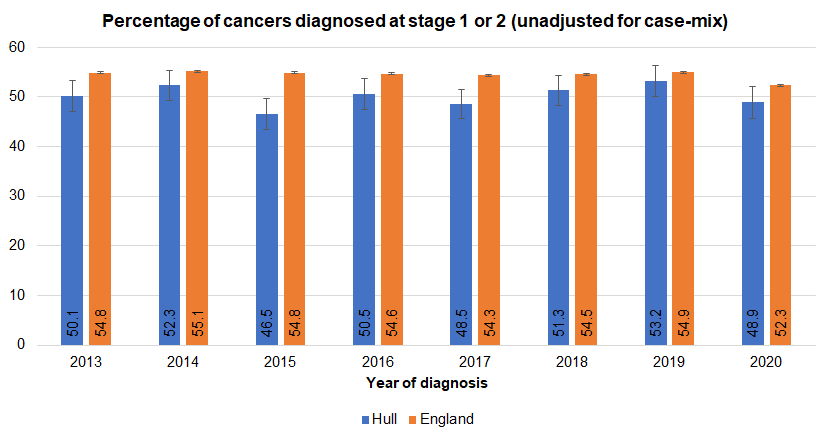
However, some cancers are more likely to be detected at an early stage, so the percentage of cancers diagnosed at a late stage can be depend on the distribution of the types of cancer. NHS Digital provides an estimate of the percentage of cancers diagnosed at an early stage adjusted for the differing case mix of patients with regard to diagnosis, socio-economic factors, and other variables.
NHS Digital include staging information on oropharynx, oral cavity, oesophagus, colorectal, pancreas, lung, melanoma of the skin, breast, uterus, ovary, prostate, testis, kidney, bladder, Hodgkin lymphoma and non-Hodgkin lymphoma.
For all years, the percentage of these cancers diagnosed at an early stage is lower in Hull compared to England. However, once the difference in the case-mix of the patients is taken into consideration, then the percentage of cancers diagnosed at an early stage is generally higher or comparable to England.
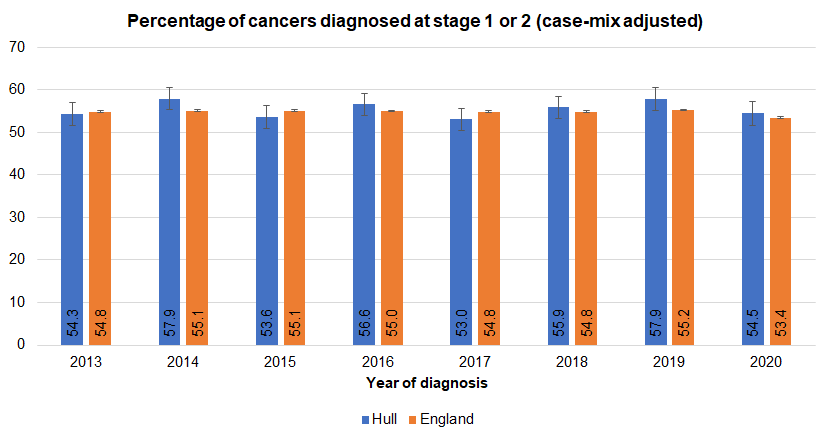
Hospital Activity
Fingertips gives the number of emergency admissions for cancer per 100,000 population as well as the number of people diagnosed with cancer via an emergency route per 100,000 GP practice population (“number of emergency presentations”) and diagnosed via a non-emergency route per 100,000 GP practice population (“number of other presentations”) for the sub Integrated Care Board areas which include Hull within the Humber and North Yorkshire Integrated Care Board. The sub-ICB area referenced by 03F relates to Hull (see Integrated Care Board for the codes relating to the other local sub-ICB areas). Whilst the descriptors of the last two indicators do not mention cancer, the definitions on Fingertips do.
For 2023/24, the rates of emergency admissions relating to cancer is slightly lower in Hull compared to England and the rate of cancers diagnosed through an emergency route is slightly higher in Hull, although neither are statistically significantly different from England. The rate of cancers diagnosed through other (non-emergency) routes is statistically significantly lower than England.
Given the higher incidence of cancer, it would be anticipated that admission rates would be higher. As expected, there is a higher proportion of people in Hull that are diagnosed with cancer through an emergency route which likely means that fewer people are being diagnosed through primary care, which has an impact on stage of diagnosis and the commencement of treatment, with the potential to affect mortality and survival rates.
Compared with benchmark
| Indicator | Period | England | NHS Humber and North Yorkshire Integrated Care Board - QOQ | Humber and North Yorkshire ICB - 02Y | Humber and North Yorkshire ICB - 03F | Humber and North Yorkshire ICB - 03H | Humber and North Yorkshire ICB - 03K | Humber and North Yorkshire ICB - 03Q | Humber and North Yorkshire ICB - 42D |
|---|---|---|---|---|---|---|---|---|---|
Number of emergency admissions with cancer (Persons All ages) | 2023/24 | 529 | 628 | 666 | 518 | 577 | 673 | 538 | 756 |
Number of emergency presentations (Persons All ages) | 2023/24 | 89 | 120 | 142 | 99 | 121 | 123 | 101 | 133 |
Number of other (non-emergency) presentations (Persons All ages) | 2023/24 | 427 | 519 | 636 | 398 | 493 | 451 | 521 | 559 |
| Indicator | Period | England | NHS Humber and North Yorkshire Integrated Care Board - QOQ | Humber and North Yorkshire ICB - 02Y | Humber and North Yorkshire ICB - 03F | Humber and North Yorkshire ICB - 03H | Humber and North Yorkshire ICB - 03K | Humber and North Yorkshire ICB - 03Q | Humber and North Yorkshire ICB - 42D |
|---|---|---|---|---|---|---|---|---|---|
Number of emergency admissions with cancer (Persons All ages) | 2023/24 | 529 | 628 | 666 | 518 | 577 | 673 | 538 | 756 |
Number of emergency presentations (Persons All ages) | 2023/24 | 89 | 120 | 142 | 99 | 121 | 123 | 101 | 133 |
Number of other (non-emergency) presentations (Persons All ages) | 2023/24 | 427 | 519 | 636 | 398 | 493 | 451 | 521 | 559 |
The rate of emergency admissions with cancer had been between 500 and 600 per 100,000 population between 2009/10 and 2017/18, but increased sharply to 691 and to 760 for 2018/19 and 2019/20 respectively. There was since been a sharp fall to 634 per 100,000 population for 2020/21 and it is likely that the COVID-19 pandemic is influential in the change in the rate, and whilst the rate increased for both 2021/22 and 2022/23, there has been a sharp decrease for 2023/24. The current admission rate in Hull is second lowest since 2009/10 with only 2021/21 lower which was impacted by the pandemic.
During 2023/24, there were 1,627 emergency admissions for cancer among Hull residents.
Compared with benchmark
Number of emergency admissions with cancer (Persons All ages)
|
Period
|
Humber and North Yorkshire ICB - 03F |
NHS Humber and North Yorkshire Integrated Care Board - QOQ
|
England
|
||||
|---|---|---|---|---|---|---|---|
|
Count
|
Value
|
95%
Lower CI |
95%
Upper CI |
||||
| 2009/10 | • | 1689 | 587 | 560 | 616 | 569 | 527 |
| 2010/11 | • | 1596 | 557 | 530 | 585 | 563 | 528 |
| 2011/12 | • | 1531 | 528 | 502 | 555 | 559 | 531 |
| 2012/13 | • | 1672 | 576 | 549 | 604 | 598 | 529 |
| 2013/14 | • | 1723 | 597 | 570 | 626 | 600 | 528 |
| 2014/15 | • | 1745 | 601 | 573 | 630 | 596 | 544 |
| 2015/16 | • | 1575 | 532 | 507 | 559 | 580 | 544 |
| 2016/17 | • | 1647 | 534 | 508 | 560 | 609 | 547 |
| 2017/18 | • | 1695 | 567 | 540 | 594 | 599 | 545 |
| 2018/19 | • | 2147 | 691 | 662 | 721 | 693 | 554 |
| 2019/20 | • | 2303 | 760 | 730 | 791 | 737 | 559 |
| 2021/22 | • | 1948 | 634 | 606 | 663 | 675 | 519 |
| 2022/23 | • | 2141 | 688 | 659 | 718 | 680 | 502 |
| 2023/24 | • | 1627 | 518 | 493 | 543 | 628 | 529 |
Source: NHS England, National Disease Registration Service
Whilst the rate of emergency presentations for cancer in Hull has decreased between 2009/10 and 2015/16, the rate remained relatively unchanged between 2015/16 and 2020/21 (despite the pandemic). The rate increased sharply between 2020/21 and 2021/22 which is likely associated with a backlog (despite the relatively unchanged rate between 2019/20 and 2020/21), although the rate decreased sharply between 2021/22 and 2023/24. The rate in 2023/24 is reasonably similar to what it was prior to the pandemic.
Compared with benchmark
Number of emergency presentations (Persons All ages)
|
Period
|
Humber and North Yorkshire ICB - 03F |
NHS Humber and North Yorkshire Integrated Care Board - QOQ
|
England
|
||||
|---|---|---|---|---|---|---|---|
|
Count
|
Value
|
95%
Lower CI |
95%
Upper CI |
||||
| 2009/10 | • | 392 | 136 | 123 | 150 | 113 | 98 |
| 2010/11 | • | 354 | 123 | 111 | 137 | 111 | 95 |
| 2011/12 | • | 360 | 124 | 112 | 138 | 109 | 94 |
| 2012/13 | • | 347 | 119 | 107 | 133 | 106 | 92 |
| 2013/14 | • | 347 | 120 | 108 | 134 | 106 | 90 |
| 2014/15 | • | 325 | 112 | 100 | 125 | 105 | 89 |
| 2015/16 | • | 292 | 99 | 88 | 111 | 97 | 89 |
| 2016/17 | • | 296 | 96 | 85 | 107 | 106 | 88 |
| 2017/18 | • | 301 | 101 | 90 | 113 | 104 | 85 |
| 2018/19 | • | 315 | 101 | 90 | 113 | 104 | 86 |
| 2019/20 | • | 323 | 107 | 95 | 119 | 104 | 85 |
| 2021/22 | • | 417 | 136 | 123 | 149 | 126 | 98 |
| 2022/23 | • | 342 | 110 | 99 | 122 | 116 | 91 |
| 2023/24 | • | 311 | 99 | 88 | 111 | 120 | 89 |
Source: NHS England, National Disease Registration Service
Between 2014/15 and 2019/20, the rate of non-emergency presentations for cancer has been relatively static in Hull at around 320-340 presentations per 100,000 population, and the rate was similar to or below the rate in England. However, the rate in Hull has increased since then although there has been a reduction in the last year.
Compared with benchmark
Number of other (non-emergency) presentations (Persons All ages)
|
Period
|
Humber and North Yorkshire ICB - 03F |
NHS Humber and North Yorkshire Integrated Care Board - QOQ
|
England
|
||||
|---|---|---|---|---|---|---|---|
|
Count
|
Value
|
95%
Lower CI |
95%
Upper CI |
||||
| 2009/10 | • | 833 | 289 | 270 | 310 | 355 | 327 |
| 2010/11 | • | 847 | 295 | 276 | 316 | 373 | 336 |
| 2011/12 | • | 976 | 336 | 316 | 358 | 396 | 349 |
| 2012/13 | • | 889 | 306 | 286 | 327 | 382 | 347 |
| 2013/14 | • | 1021 | 354 | 332 | 376 | 412 | 354 |
| 2014/15 | • | 991 | 341 | 320 | 363 | 399 | 360 |
| 2015/16 | • | 964 | 326 | 306 | 347 | 396 | 362 |
| 2016/17 | • | 1003 | 325 | 305 | 346 | 409 | 364 |
| 2017/18 | • | 1041 | 348 | 327 | 370 | 405 | 362 |
| 2018/19 | • | 989 | 318 | 299 | 339 | 435 | 378 |
| 2019/20 | • | 1058 | 349 | 328 | 371 | 420 | 377 |
| 2021/22 | • | 1190 | 387 | 366 | 410 | 484 | 396 |
| 2022/23 | • | 1371 | 441 | 418 | 465 | 481 | 411 |
| 2023/24 | • | 1252 | 398 | 376 | 421 | 519 | 427 |
Source: NHS England, National Disease Registration Service
The number of inpatient or day-case colonoscopy, sigmoidoscopy and upper gastrointestinal endoscopy procedures per 100,000 GP registered population are given on Fingertips.
For 2022/23, the rate of colonoscopy procedures in Hull (03F) is higher than England (767 versus 746), but the rates of sigmoidoscopy (293 versus 324) and upper gastrointestinal endoscopy (1,064 versus 1,121) procedures are both lower in Hull.
Compared with benchmark
| Indicator | Period | England | NHS Humber and North Yorkshire Integrated Care Board - QOQ | Humber and North Yorkshire ICB - 02Y | Humber and North Yorkshire ICB - 03F | Humber and North Yorkshire ICB - 03H | Humber and North Yorkshire ICB - 03K | Humber and North Yorkshire ICB - 03Q | Humber and North Yorkshire ICB - 42D |
|---|---|---|---|---|---|---|---|---|---|
In-patient or day-case colonoscopy procedures - Retired after 2022/23 (Persons All ages) | 2022/23 | 746 | 962 | 942 | 767 | 1336 | 1132 | 718 | 1102 |
In-patient or day-case sigmoidoscopy procedures - Retired after 2022/23 (Persons All ages) | 2022/23 | 324 | 359 | 342 | 293 | 441 | 448 | 353 | 353 |
In-patient or day-case upper GI endoscopy procedures - Retired after 2022/23 (Persons All ages) | 2022/23 | 1121 | 1376 | 1229 | 1064 | 1656 | 1683 | 1265 | 1556 |
| Indicator | Period | England | NHS Humber and North Yorkshire Integrated Care Board - QOQ | Humber and North Yorkshire ICB - 02Y | Humber and North Yorkshire ICB - 03F | Humber and North Yorkshire ICB - 03H | Humber and North Yorkshire ICB - 03K | Humber and North Yorkshire ICB - 03Q | Humber and North Yorkshire ICB - 42D |
|---|---|---|---|---|---|---|---|---|---|
In-patient or day-case colonoscopy procedures - Retired after 2022/23 (Persons All ages) | 2022/23 | 746 | 962 | 942 | 767 | 1336 | 1132 | 718 | 1102 |
In-patient or day-case sigmoidoscopy procedures - Retired after 2022/23 (Persons All ages) | 2022/23 | 324 | 359 | 342 | 293 | 441 | 448 | 353 | 353 |
In-patient or day-case upper GI endoscopy procedures - Retired after 2022/23 (Persons All ages) | 2022/23 | 1121 | 1376 | 1229 | 1064 | 1656 | 1683 | 1265 | 1556 |
The rate of colonoscopy procedures had been consistently and gradually increasing in Hull prior to the COVID-19 pandemic with a decrease in 2020/21 due to the pandemic, although has increased since then. A similar pattern in the rate of colonoscopies occurred for England and the region, although the rate across the region has been consistently higher than the rate in Hull.
Compared with benchmark
In-patient or day-case colonoscopy procedures - Retired after 2022/23 (Persons All ages)
|
Period
|
Humber and North Yorkshire ICB - 03F |
NHS Humber and North Yorkshire Integrated Care Board - QOQ
|
England
|
||||
|---|---|---|---|---|---|---|---|
|
Count
|
Value
|
95%
Lower CI |
95%
Upper CI |
||||
| 2009/10 | • | 1745 | 606 | 579 | 635 | - | 536 |
| 2010/11 | • | 1871 | 653 | 624 | 683 | - | 556 |
| 2011/12 | • | 1690 | 583 | 556 | 611 | - | 616 |
| 2012/13 | • | 1747 | 602 | 574 | 630 | - | 670 |
| 2013/14 | • | 1835 | 636 | 608 | 666 | - | 669 |
| 2014/15 | • | 1840 | 634 | 605 | 663 | - | 707 |
| 2015/16 | • | 2007 | 678 | 649 | 708 | - | 736 |
| 2016/17 | • | 2367 | 767 | 737 | 798 | - | 764 |
| 2017/18 | • | 2053 | 686 | 657 | 717 | - | 747 |
| 2018/19 | • | 2286 | 735 | 706 | 766 | - | 776 |
| 2019/20 | • | 2298 | 758 | 728 | 790 | - | 798 |
| 2020/21 | • | 1245 | 442 | 418 | 468 | - | 512 |
| 2021/22 | • | 2212 | 720 | 690 | 751 | 954 | 712 |
| 2022/23 | • | 2385 | 767 | 736 | 798 | 962 | 746 |
Source: NHS England, National Disease Registration Service
The rate of sigmoidoscopy procedures had been increasing between 2009/10 and 2014/15 to a high of 824 procedures per 100,00 population but fell quite sharply over the next three years to 450 in 2017/18. The rate then increased slightly to 507 in 2019/20. The rate fell to one-third what is was in 2020/21 due to the pandemic with only a relatively small increase between 2020/21 and 2022/23. The latest rate in 2022/23 is 42% lower than it was prior to the pandemic in 2019/20.
Since 2016/17, the rate in Hull has followed a similar pattern of change to that of England and the region, although the rate in Hull has been consistently lower than England and the region over this time period.
Compared with benchmark
In-patient or day-case sigmoidoscopy procedures - Retired after 2022/23 (Persons All ages)
|
Period
|
Humber and North Yorkshire ICB - 03F |
NHS Humber and North Yorkshire Integrated Care Board - QOQ
|
England
|
||||
|---|---|---|---|---|---|---|---|
|
Count
|
Value
|
95%
Lower CI |
95%
Upper CI |
||||
| 2009/10 | • | 1531 | 532 | 506 | 559 | - | 385 |
| 2010/11 | • | 1645 | 574 | 547 | 602 | - | 397 |
| 2011/12 | • | 1770 | 610 | 583 | 639 | - | 422 |
| 2012/13 | • | 2075 | 715 | 685 | 746 | - | 446 |
| 2013/14 | • | 2241 | 777 | 745 | 809 | - | 432 |
| 2014/15 | • | 2392 | 824 | 791 | 857 | - | 445 |
| 2015/16 | • | 2008 | 679 | 650 | 709 | - | 480 |
| 2016/17 | • | 1429 | 463 | 440 | 488 | - | 508 |
| 2017/18 | • | 1346 | 450 | 427 | 475 | - | 523 |
| 2018/19 | • | 1555 | 500 | 476 | 526 | - | 565 |
| 2019/20 | • | 1536 | 507 | 482 | 533 | - | 559 |
| 2020/21 | • | 478 | 170 | 155 | 186 | - | 247 |
| 2021/22 | • | 935 | 304 | 285 | 325 | 340 | 324 |
| 2022/23 | • | 910 | 293 | 274 | 312 | 359 | 324 |
Source: NHS England, National Disease Registration Service
The number of upper gastrointestinal endoscopy procedures per 100,000 population showed a similar pattern to that observed for sigmoidoscopy procedures with a gradual increase prior to the pandemic, a sharp decrease (of 54%) followed by an increase in the last two years. However, for the case of upper gastrointestinal endoscopy, the rate in 2022/23 is 8% lower than it was in 2019/20 compared to 42% lower for sigmoidoscopy.
The pattern of change for England and the region was reasonably similar to Hull, although the rate in Hull has been consistently lower than the region throughout the entire period 2012/13 to 2022/23 and consistently lower than England between 2015/16 and 2022/23.
Compared with benchmark
In-patient or day-case upper GI endoscopy procedures - Retired after 2022/23 (Persons All ages)
|
Period
|
Humber and North Yorkshire ICB - 03F |
NHS Humber and North Yorkshire Integrated Care Board - QOQ
|
England
|
||||
|---|---|---|---|---|---|---|---|
|
Count
|
Value
|
95%
Lower CI |
95%
Upper CI |
||||
| 2009/10 | • | 3157 | 1097 | 1060 | 1136 | - | 1013 |
| 2010/11 | • | 3256 | 1136 | 1098 | 1175 | - | 1033 |
| 2011/12 | • | 3157 | 1088 | 1051 | 1127 | - | 1063 |
| 2012/13 | • | 2926 | 1008 | 972 | 1045 | - | 1104 |
| 2013/14 | • | 3269 | 1133 | 1095 | 1172 | - | 1159 |
| 2014/15 | • | 3557 | 1225 | 1186 | 1266 | - | 1219 |
| 2015/16 | • | 3758 | 1270 | 1230 | 1311 | - | 1309 |
| 2016/17 | • | 3921 | 1270 | 1231 | 1310 | - | 1283 |
| 2017/18 | • | 3509 | 1173 | 1135 | 1212 | - | 1257 |
| 2018/19 | • | 3678 | 1183 | 1146 | 1222 | - | 1248 |
| 2019/20 | • | 3507 | 1157 | 1120 | 1196 | - | 1234 |
| 2020/21 | • | 1485 | 528 | 501 | 555 | - | 762 |
| 2021/22 | • | 3012 | 981 | 946 | 1016 | 1334 | 1116 |
| 2022/23 | • | 3310 | 1064 | 1028 | 1101 | 1376 | 1121 |
Source: NHS England, National Disease Registration Service
Mortality
Overall Mortality Rates
Fingertips present the standardised mortality ratios for cancer both for deaths for all ages and deaths which occurred prior to the age of 75 years. In 2019-23, cancer mortality rates in Hull were 30% higher than England for all ages and 32% higher for those aged under 75 years.
Compared with benchmark
| Indicator | Period | England | Yorkshire and the Humber region (statistical) | Kingston upon Hull | East Riding of Yorkshire | North East Lincolnshire | North Lincolnshire | York | North Yorkshire UA | Barnsley | Doncaster | Rotherham | Sheffield | Bradford | Calderdale | Kirklees | Leeds | Wakefield |
|---|---|---|---|---|---|---|---|---|---|---|---|---|---|---|---|---|---|---|
Mortality from cancer (Persons All ages) | 2019 - 23 | 100.0 | 105.6 | 130.3 | 99.2 | 114.6 | 105.5 | 101.6 | 93.2 | 114.8 | 113.9 | 112.0 | 107.8 | 101.5 | 104.4 | 102.8 | 106.0 | 111.5 |
Mortality from cancer (aged under 75) (Persons <75 yrs) | 2019 - 23 | 100.0 | 106.9 | 132.2 | 95.6 | 120.4 | 108.5 | 105.1 | 90.8 | 115.5 | 119.4 | 116.0 | 108.0 | 107.4 | 101.9 | 103.2 | 107.1 | 111.5 |
| Indicator | Period | England | Yorkshire and the Humber region (statistical) | Kingston upon Hull | East Riding of Yorkshire | North East Lincolnshire | North Lincolnshire | York | North Yorkshire UA | Barnsley | Doncaster | Rotherham | Sheffield | Bradford | Calderdale | Kirklees | Leeds | Wakefield |
|---|---|---|---|---|---|---|---|---|---|---|---|---|---|---|---|---|---|---|
Mortality from cancer (Persons All ages) | 2019 - 23 | 100.0 | 105.6 | 130.3 | 99.2 | 114.6 | 105.5 | 101.6 | 93.2 | 114.8 | 113.9 | 112.0 | 107.8 | 101.5 | 104.4 | 102.8 | 106.0 | 111.5 |
Mortality from cancer (aged under 75) (Persons <75 yrs) | 2019 - 23 | 100.0 | 106.9 | 132.2 | 95.6 | 120.4 | 108.5 | 105.1 | 90.8 | 115.5 | 119.4 | 116.0 | 108.0 | 107.4 | 101.9 | 103.2 | 107.1 | 111.5 |
For deaths registered during 2022-24, the under 75 directly standardised mortality rate per 100,000 population (standardised to the European Standard Population) for Hull was 34% higher than England and was the highest amongst local authorities in Yorkshire and Humber.
Compared to England, the cancer mortality rates in Hull were around one-third higher for both men (35%) and women (31%).
Compared with benchmark
| Indicator | Period | England | Yorkshire and the Humber region (statistical) | Kingston upon Hull | East Riding of Yorkshire | North East Lincolnshire | North Lincolnshire | York | North Yorkshire UA | Barnsley | Doncaster | Rotherham | Sheffield | Bradford | Calderdale | Kirklees | Leeds | Wakefield |
|---|---|---|---|---|---|---|---|---|---|---|---|---|---|---|---|---|---|---|
Under 75 mortality rate from cancer (Persons <75 yrs) | 2022 - 24 | 120.3 | 128.4 | 161.0 | 114.8 | 145.2 | 133.1 | 117.0 | 106.1 | 144.7 | 148.6 | 139.5 | 132.2 | 132.6 | 124.8 | 120.8 | 126.3 | 133.6 |
Under 75 mortality rate from cancer (Male <75 yrs) | 2022 - 24 | 133.3 | 140.9 | 180.1 | 122.7 | 163.4 | 144.5 | 122.5 | 115.3 | 159.7 | 165.8 | 144.5 | 141.8 | 147.5 | 140.2 | 134.1 | 142.7 | 145.3 |
Under 75 mortality rate from cancer (Female <75 yrs) | 2022 - 24 | 108.3 | 116.6 | 142.3 | 107.3 | 128.0 | 122.1 | 111.9 | 97.3 | 130.2 | 132.3 | 135.0 | 123.2 | 118.3 | 110.4 | 108.2 | 111.3 | 122.8 |
| Indicator | Period | England | Yorkshire and the Humber region (statistical) | Kingston upon Hull | East Riding of Yorkshire | North East Lincolnshire | North Lincolnshire | York | North Yorkshire UA | Barnsley | Doncaster | Rotherham | Sheffield | Bradford | Calderdale | Kirklees | Leeds | Wakefield |
|---|---|---|---|---|---|---|---|---|---|---|---|---|---|---|---|---|---|---|
Under 75 mortality rate from cancer (Persons <75 yrs) | 2022 - 24 | 120.3 | 128.4 | 161.0 | 114.8 | 145.2 | 133.1 | 117.0 | 106.1 | 144.7 | 148.6 | 139.5 | 132.2 | 132.6 | 124.8 | 120.8 | 126.3 | 133.6 |
Under 75 mortality rate from cancer (Male <75 yrs) | 2022 - 24 | 133.3 | 140.9 | 180.1 | 122.7 | 163.4 | 144.5 | 122.5 | 115.3 | 159.7 | 165.8 | 144.5 | 141.8 | 147.5 | 140.2 | 134.1 | 142.7 | 145.3 |
Under 75 mortality rate from cancer (Female <75 yrs) | 2022 - 24 | 108.3 | 116.6 | 142.3 | 107.3 | 128.0 | 122.1 | 111.9 | 97.3 | 130.2 | 132.3 | 135.0 | 123.2 | 118.3 | 110.4 | 108.2 | 111.3 | 122.8 |
There were 1,037 premature deaths from cancer among Hull residents that were registered during the three year period 2022-24.
Compared with benchmark
Under 75 mortality rate from cancer (Persons <75 yrs) 2022 - 24
| Area |
Recent
Trend |
Count
|
Value
|
95%
Lower CI |
95%
Upper CI |
|
|---|---|---|---|---|---|---|
| England | 178083 | 120.3 | 119.7 | 120.9 | ||
| Yorkshire and the Humber region (statistical) | 18935 | 128.4 | 126.5 | 130.2 | ||
| Kingston upon Hull | 1037 | 161.0 | 151.3 | 171.1 | ||
| East Riding of Yorkshire | 1346 | 114.8 | 108.7 | 121.1 | ||
| North East Lincolnshire | 659 | 145.2 | 134.3 | 156.8 | ||
| North Lincolnshire | 681 | 133.1 | 123.2 | 143.5 | ||
| York | 598 | 117.0 | 107.8 | 126.7 | ||
| North Yorkshire UA | 2162 | 106.1 | 101.6 | 110.7 | ||
| Barnsley | 1004 | 144.7 | 135.8 | 153.9 | ||
| Doncaster | 1284 | 148.6 | 140.6 | 157.0 | ||
| Rotherham | 1022 | 139.5 | 131.0 | 148.3 | ||
| Sheffield | 1744 | 132.2 | 126.0 | 138.5 | ||
| Bradford | 1686 | 132.6 | 126.3 | 139.1 | ||
| Calderdale | 721 | 124.8 | 115.9 | 134.3 | ||
| Kirklees | 1362 | 120.8 | 114.5 | 127.4 | ||
| Leeds | 2327 | 126.3 | 121.2 | 131.5 | ||
| Wakefield | 1302 | 133.6 | 126.5 | 141.1 |
Source: OHID, based on Office for National Statistics data
For men, there were 574 premature deaths from cancer among Hull residents that were registered during the three year period 2022-24.
The mortality rate was considerably higher than all other local authorities in the region for 2022-24.
Compared with benchmark
Under 75 mortality rate from cancer (Male <75 yrs) 2022 - 24
| Area |
Recent
Trend |
Count
|
Value
|
95%
Lower CI |
95%
Upper CI |
|
|---|---|---|---|---|---|---|
| England | 95314 | 133.3 | 132.4 | 134.1 | ||
| Yorkshire and the Humber region (statistical) | 10133 | 140.9 | 138.1 | 143.6 | ||
| Kingston upon Hull | 574 | 180.1 | 165.6 | 195.5 | ||
| East Riding of Yorkshire | 707 | 122.7 | 113.8 | 132.2 | ||
| North East Lincolnshire | 364 | 163.4 | 147.0 | 181.1 | ||
| North Lincolnshire | 365 | 144.5 | 130.0 | 160.2 | ||
| York | 302 | 122.5 | 109.1 | 137.2 | ||
| North Yorkshire UA | 1154 | 115.3 | 108.7 | 122.2 | ||
| Barnsley | 545 | 159.7 | 146.5 | 173.7 | ||
| Doncaster | 700 | 165.8 | 153.7 | 178.5 | ||
| Rotherham | 516 | 144.5 | 132.2 | 157.5 | ||
| Sheffield | 911 | 141.8 | 132.8 | 151.4 | ||
| Bradford | 916 | 147.5 | 138.0 | 157.4 | ||
| Calderdale | 393 | 140.2 | 126.7 | 154.8 | ||
| Kirklees | 736 | 134.1 | 124.6 | 144.2 | ||
| Leeds | 1261 | 142.7 | 134.9 | 150.8 | ||
| Wakefield | 689 | 145.3 | 134.6 | 156.6 |
Source: OHID, based on Office for National Statistics data
For women, there were 463 premature deaths from cancer among Hull residents that were registered during the three year period 2022-24, with Hull having the highest mortality rate among Yorkshire and Humber local authorities.
Compared with benchmark
Under 75 mortality rate from cancer (Female <75 yrs) 2022 - 24
| Area |
Recent
Trend |
Count
|
Value
|
95%
Lower CI |
95%
Upper CI |
|
|---|---|---|---|---|---|---|
| England | 82769 | 108.3 | 107.6 | 109.0 | ||
| Yorkshire and the Humber region (statistical) | 8802 | 116.6 | 114.2 | 119.1 | ||
| Kingston upon Hull | 463 | 142.3 | 129.6 | 156.0 | ||
| East Riding of Yorkshire | 639 | 107.3 | 99.0 | 116.0 | ||
| North East Lincolnshire | 295 | 128.0 | 113.7 | 143.5 | ||
| North Lincolnshire | 316 | 122.1 | 108.9 | 136.4 | ||
| York | 296 | 111.9 | 99.5 | 125.4 | ||
| North Yorkshire UA | 1008 | 97.3 | 91.4 | 103.6 | ||
| Barnsley | 459 | 130.2 | 118.6 | 142.8 | ||
| Doncaster | 584 | 132.3 | 121.8 | 143.5 | ||
| Rotherham | 506 | 135.0 | 123.5 | 147.3 | ||
| Sheffield | 833 | 123.2 | 115.0 | 131.9 | ||
| Bradford | 770 | 118.3 | 110.1 | 127.0 | ||
| Calderdale | 328 | 110.4 | 98.8 | 123.1 | ||
| Kirklees | 626 | 108.2 | 99.9 | 117.1 | ||
| Leeds | 1066 | 111.3 | 104.7 | 118.3 | ||
| Wakefield | 613 | 122.8 | 113.2 | 132.9 |
Source: OHID, based on Office for National Statistics data
The premature mortality rate from cancer in Hull has been consistently decreasing between 2001-03 and 2017-19 with a relatively sharp decrease between 2015-17 and 2016-18. Whilst the mortality rate decreased between 2017-19 and 2018-20 and increased between 2018-20 and 2019-21 in Hull, no such pattern was observed for either England or across the region. There were differences in the total number of deaths where cancer was the underlying cause of death or a secondary cause (see Causes of Deaths within Population for more information), although the number was higher in Hull in 2020-21 compared to 2018-19 which does not particularly explain the pattern in the mortality rate in Hull. It is possible that some cancers were diagnosed later during the pandemic which could influence the mortality rate. Hull also has higher rates of lung cancer compared to England which has a lower survival rate compare to cancers of other sites so the cancer site will influence the overall morality rate comparison. Since 2019-21 the trend in Hull appears relatively consistent with the trend until 2015-17.
Compared with benchmark
Under 75 mortality rate from cancer (Persons <75 yrs)
|
Period
|
Kingston upon Hull |
Yorkshire and the Humber region (statistical)
|
England
|
||||
|---|---|---|---|---|---|---|---|
|
Count
|
Value
|
95%
Lower CI |
95%
Upper CI |
||||
| 2001 - 03 | • | 1095 | 206.2 | 194.1 | 218.8 | 178.7 | 169.4 |
| 2002 - 04 | • | 1107 | 207.7 | 195.6 | 220.4 | 176.3 | 166.2 |
| 2003 - 05 | • | 1071 | 200.4 | 188.5 | 212.9 | 170.6 | 162.7 |
| 2004 - 06 | • | 1088 | 203.6 | 191.6 | 216.2 | 167.0 | 160.0 |
| 2005 - 07 | • | 1065 | 199.5 | 187.7 | 212.0 | 165.2 | 157.8 |
| 2006 - 08 | • | 1089 | 204.7 | 192.6 | 217.3 | 164.2 | 155.7 |
| 2007 - 09 | • | 1081 | 202.9 | 190.9 | 215.5 | 161.6 | 153.2 |
| 2008 - 10 | • | 1064 | 198.5 | 186.7 | 210.9 | 159.1 | 150.6 |
| 2009 - 11 | • | 1062 | 197.2 | 185.4 | 209.6 | 158.3 | 148.5 |
| 2010 - 12 | • | 1046 | 192.6 | 181.0 | 204.8 | 157.4 | 146.5 |
| 2011 - 13 | • | 1058 | 191.7 | 180.2 | 203.8 | 155.0 | 144.4 |
| 2012 - 14 | • | 1043 | 186.2 | 175.0 | 198.0 | 151.7 | 141.6 |
| 2013 - 15 | • | 1063 | 187.9 | 176.6 | 199.6 | 148.5 | 138.9 |
| 2014 - 16 | • | 1031 | 179.4 | 168.5 | 190.8 | 146.4 | 137.1 |
| 2015 - 17 | • | 1053 | 179.5 | 168.7 | 190.8 | 143.7 | 134.9 |
| 2016 - 18 | • | 963 | 159.9 | 149.9 | 170.4 | 141.4 | 132.7 |
| 2017 - 19 | • | 988 | 160.8 | 150.9 | 171.2 | 137.9 | 129.7 |
| 2018 - 20 | • | 979 | 156.2 | 146.5 | 166.3 | 136.0 | 127.6 |
| 2019 - 21 | • | 1062 | 166.7 | 156.8 | 177.0 | 133.5 | 124.8 |
| 2020 - 22 | • | 1062 | 165.4 | 155.5 | 175.6 | 132.4 | 123.2 |
| 2021 - 23 | • | 1037 | 161.3 | 151.6 | 171.5 | 130.1 | 121.5 |
| 2022 - 24 | • | 1037 | 161.0 | 151.3 | 171.1 | 128.4 | 120.3 |
Source: OHID, based on Office for National Statistics data
For men, there has been a decreasing trend in the premature cancer mortality rate between 2001-03 and 2022-24 although some year-on-year variability so the rate has not decreased every year.
The inequalities gap between Hull and England has remained relatively constant over time.
Compared with benchmark
Under 75 mortality rate from cancer (Male <75 yrs)
|
Period
|
Kingston upon Hull |
Yorkshire and the Humber region (statistical)
|
England
|
||||
|---|---|---|---|---|---|---|---|
|
Count
|
Value
|
95%
Lower CI |
95%
Upper CI |
||||
| 2001 - 03 | • | 645 | 253.7 | 234.4 | 274.1 | 206.0 | 193.6 |
| 2002 - 04 | • | 644 | 252.7 | 233.5 | 273.2 | 203.7 | 189.7 |
| 2003 - 05 | • | 615 | 239.4 | 220.7 | 259.2 | 195.2 | 184.7 |
| 2004 - 06 | • | 610 | 236.9 | 218.4 | 256.7 | 190.1 | 181.0 |
| 2005 - 07 | • | 587 | 227.6 | 209.4 | 247.0 | 185.2 | 177.7 |
| 2006 - 08 | • | 591 | 229.5 | 211.2 | 248.9 | 183.6 | 174.9 |
| 2007 - 09 | • | 597 | 230.4 | 212.1 | 249.8 | 180.3 | 171.8 |
| 2008 - 10 | • | 583 | 223.1 | 205.2 | 242.2 | 178.5 | 168.9 |
| 2009 - 11 | • | 572 | 219.3 | 201.4 | 238.2 | 178.1 | 166.3 |
| 2010 - 12 | • | 541 | 205.8 | 188.6 | 224.1 | 176.8 | 163.6 |
| 2011 - 13 | • | 564 | 210.3 | 193.1 | 228.7 | 173.7 | 160.9 |
| 2012 - 14 | • | 565 | 207.5 | 190.5 | 225.7 | 169.8 | 157.7 |
| 2013 - 15 | • | 573 | 209.3 | 192.3 | 227.5 | 166.8 | 155.0 |
| 2014 - 16 | • | 554 | 198.9 | 182.4 | 216.5 | 163.8 | 152.4 |
| 2015 - 17 | • | 578 | 201.0 | 184.8 | 218.3 | 160.8 | 150.0 |
| 2016 - 18 | • | 547 | 184.0 | 168.8 | 200.2 | 156.5 | 147.1 |
| 2017 - 19 | • | 570 | 186.9 | 171.8 | 203.0 | 154.0 | 143.9 |
| 2018 - 20 | • | 552 | 177.6 | 163.1 | 193.1 | 150.9 | 141.0 |
| 2019 - 21 | • | 593 | 187.3 | 172.5 | 203.1 | 147.8 | 137.7 |
| 2020 - 22 | • | 582 | 182.4 | 167.8 | 197.8 | 144.8 | 136.0 |
| 2021 - 23 | • | 569 | 178.4 | 164.0 | 193.8 | 142.0 | 134.2 |
| 2022 - 24 | • | 574 | 180.1 | 165.6 | 195.5 | 140.9 | 133.3 |
Source: OHID, based on Office for National Statistics data
For women, the premature cancer mortality rate was 10% higher in Hull compared to England in 2001-03 but increased gradually to a difference of 32% in 2006-08. This relatively large inequalities gap was maintained until 2015-17, but there was a relatively sharp decrease in the mortality rate between 2015-17 and 2016-18. This narrowed the inequalities gap, and in 2016-18, the premature cancer mortality rate was 15% higher in Hull compared to England for women. However, the mortality rate subsequently increased to 34% higher than England in 2020-22, and has remained reasonably similar in 2021-23 and 2022-24 (currently 31% higher among Hull women compare to women in England).
Compared with benchmark
Under 75 mortality rate from cancer (Female <75 yrs)
|
Period
|
Kingston upon Hull |
Yorkshire and the Humber region (statistical)
|
England
|
||||
|---|---|---|---|---|---|---|---|
|
Count
|
Value
|
95%
Lower CI |
95%
Upper CI |
||||
| 2001 - 03 | • | 450 | 162.7 | 148.0 | 178.5 | 154.8 | 147.9 |
| 2002 - 04 | • | 463 | 166.4 | 151.6 | 182.4 | 152.1 | 145.4 |
| 2003 - 05 | • | 456 | 164.3 | 149.5 | 180.1 | 148.7 | 143.0 |
| 2004 - 06 | • | 478 | 173.0 | 157.8 | 189.3 | 146.5 | 141.2 |
| 2005 - 07 | • | 478 | 174.0 | 158.6 | 190.3 | 147.3 | 139.7 |
| 2006 - 08 | • | 498 | 182.0 | 166.3 | 198.8 | 147.0 | 138.2 |
| 2007 - 09 | • | 484 | 177.2 | 161.7 | 193.8 | 144.8 | 136.3 |
| 2008 - 10 | • | 481 | 175.4 | 160.0 | 191.9 | 141.6 | 133.8 |
| 2009 - 11 | • | 490 | 177.1 | 161.6 | 193.6 | 140.4 | 132.1 |
| 2010 - 12 | • | 505 | 181.1 | 165.5 | 197.7 | 139.8 | 130.8 |
| 2011 - 13 | • | 494 | 174.8 | 159.6 | 191.0 | 138.0 | 129.2 |
| 2012 - 14 | • | 478 | 166.7 | 152.0 | 182.4 | 135.1 | 126.7 |
| 2013 - 15 | • | 490 | 168.5 | 153.8 | 184.2 | 131.5 | 124.1 |
| 2014 - 16 | • | 477 | 161.7 | 147.4 | 177.1 | 130.1 | 122.9 |
| 2015 - 17 | • | 475 | 159.3 | 145.2 | 174.3 | 127.7 | 121.0 |
| 2016 - 18 | • | 416 | 136.6 | 123.8 | 150.5 | 127.4 | 119.3 |
| 2017 - 19 | • | 418 | 135.2 | 122.5 | 148.8 | 122.7 | 116.5 |
| 2018 - 20 | • | 427 | 135.2 | 122.7 | 148.7 | 122.1 | 115.0 |
| 2019 - 21 | • | 469 | 146.5 | 133.6 | 160.4 | 120.0 | 112.7 |
| 2020 - 22 | • | 480 | 148.8 | 135.8 | 162.8 | 120.8 | 111.4 |
| 2021 - 23 | • | 468 | 144.6 | 131.8 | 158.4 | 118.9 | 109.7 |
| 2022 - 24 | • | 463 | 142.3 | 129.6 | 156.0 | 116.6 | 108.3 |
Source: OHID, based on Office for National Statistics data
Mortality Rates Across Hull’s Wards
Using the local the number of deaths from the local Primary Care Mortality Database and resident population estimates from the Office for National Statistics, it is possible to calculate the directly standardised mortality rate for all cancer deaths across Hull’s 21 electoral wards and across geographical areas within Hull based on deprivation (Index of Multiple Deprivation). Due the small number of deaths, eight years of data have been combined, and 95% confidence intervals are also given to illustrate the degree of uncertainty associated with the directly standardised mortality rate. The directly standardised mortality rates are given as the number of deaths per 100,000 population standardised to the European Standard Population so are comparable to the mortality rates on Fingertips albeit for a different period of time.
The directly standardised mortality rates for cancers which occurred under the age of 75 years registered during 2020-23 were highest in Newington & Gipsyville (302 deaths per 100,000 population), Marfleet (284), Orchard Park (269), North Carr (266), St Andrew’s & Docklands (253) and Central (253), with the first four of these statistically significantly higher than the Hull average (217 per 100,00 population). Under 75 mortality rates were statistically significantly lower than the Hull average for Bricknell, Kingswood, Holderness and Boothferry wards.
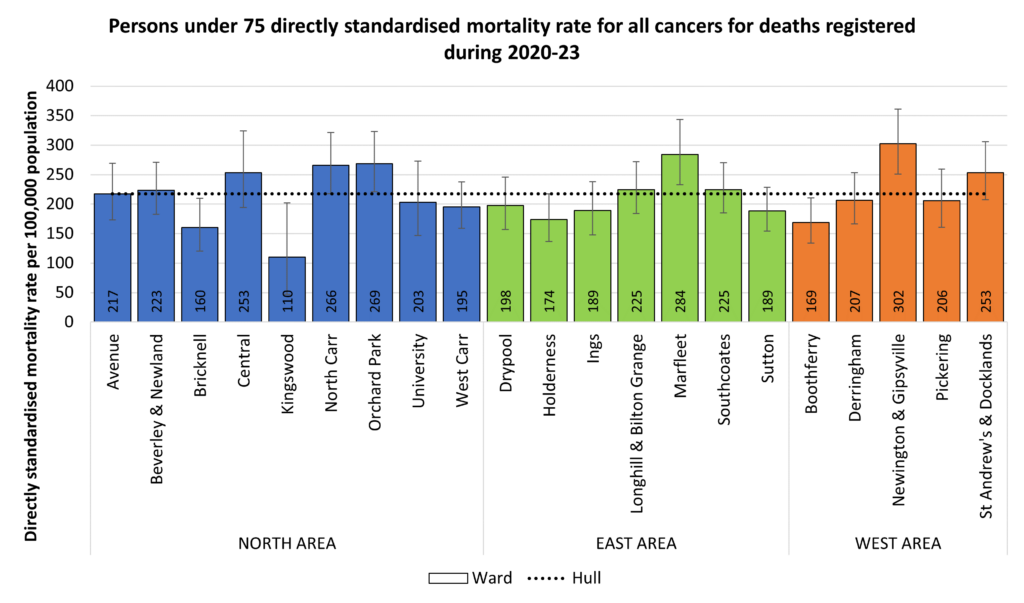
Among men aged under 75 years, the mortality rates for cancer were highest in Newington & Gipsyville (357 per 100,000 population), Orchard Park (312), Marfleet (307) and University (300).
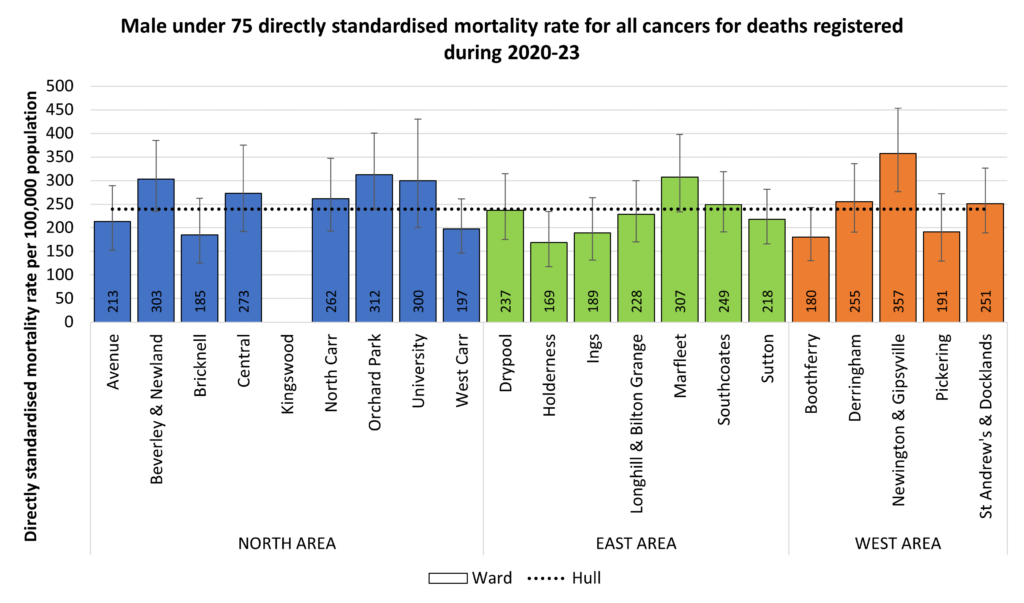
Premature mortality rates from cancer were highest in North Carr ward for women (270 per 100,000 population) with the next highest rates for Marfleet (260), St Andrews & Docklands (258) and Newington & Gipsyville(253).
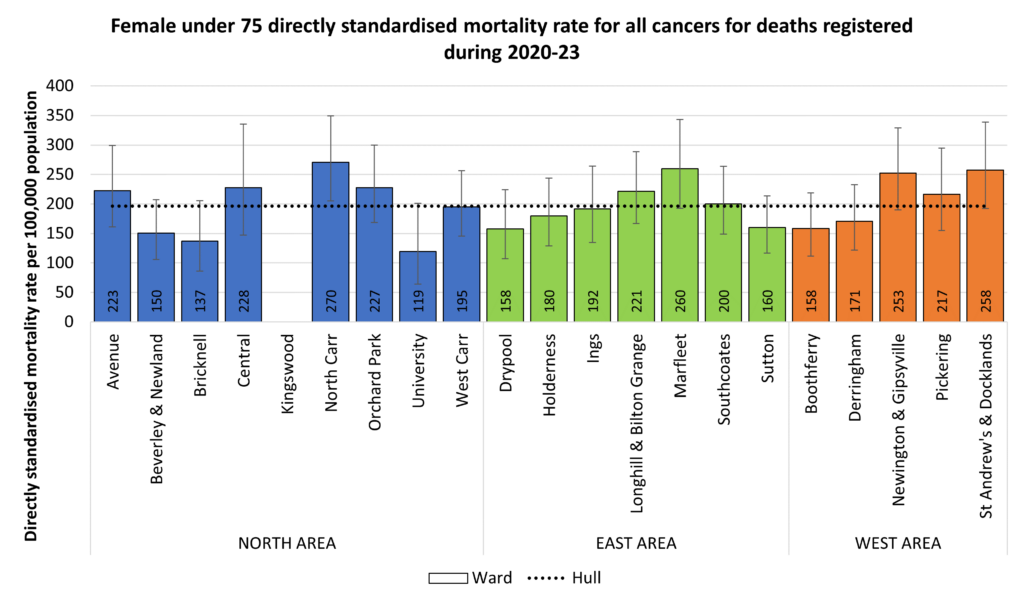
Within the Office for Health Improvement & Disparities’ Local Health, the cancer standardised mortality ratios (SMRs) are given for each electoral ward for all ages and for deaths under the age of 75 years. The data presented below relates to the five year period 2016-20 (so slightly different to the period above) and the SMRs are given together with 95% confidence intervals. The SMRs are standardised to England for the period 2016-20 so that any ratio above 100 denotes that the ward has a higher mortality rate for the specific age group compared to England for the period 2016-20, and a ratio below 100 denotes a lower mortality rate.
If the 95% confidence interval does not contain the value of 100, this means that the mortality rate for the ward is statistically significantly different from England after allowing for differences in the age structure between Hull and England.
Mortality rates from cancer for all ages are significantly higher in Hull compared to England for the majority of wards in Hull with only Avenue, Beverley & Newland, Kingswood, Holderness, Boothferry and Pickering wards not statistically significantly higher than England
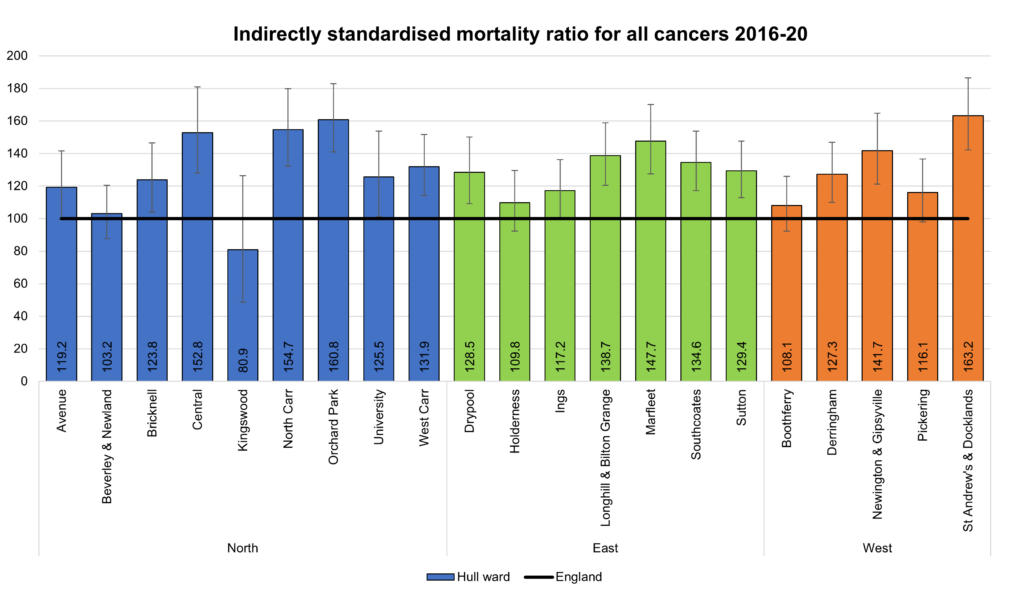
For deaths before the age of 75 years, the SMRs are significantly higher in Hull for the majority of Hull’s 21 wards. Central, North Carr, Orchard Park, University, West Carr, Drypool, Longhill & Bilton Grange, Marfleet, Derringham, Newington & Gipsyville, Pickering and St Andrew’s & Docklands wards all have premature mortality rates from cancer which are statistically significantly higher than England.
The differences are quite marked too. West Carr is statistically significantly higher than England with a premature cancer mortality rate 29% higher than England which is considerable, but among the wards that are statistically significantly higher than England it is the lowest standardised mortality ratio. Most of the wards that are higher than England have mortality rates in excess of 40% higher than England, and Marfleet has a mortality rate 58% higher than England and St Andrew’s & Docklands has a premature cancer mortality rate 86% higher than England.
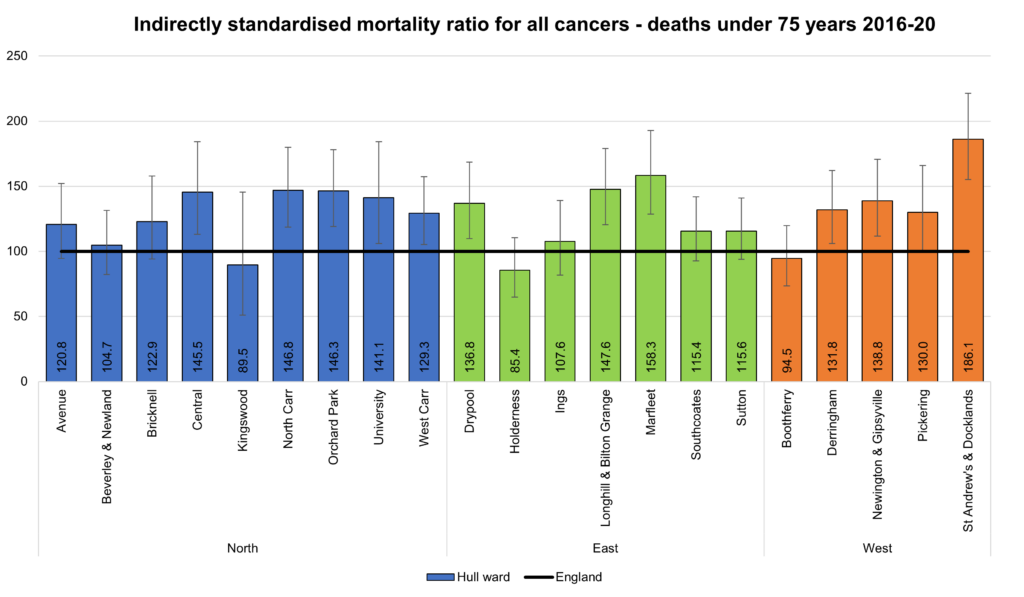
Mortality Rates By Local Deprivation Fifth
There was a large difference in the directly standardised mortality rates for cancer deaths occurring under the age of 75 years among people living in the most deprived fifth of areas compared to the least deprived fifth of areas of Hull with mortality rates 1.7 times higher in the most deprived fifth of areas of Hull (285 versus 172 deaths per 100,000 population).
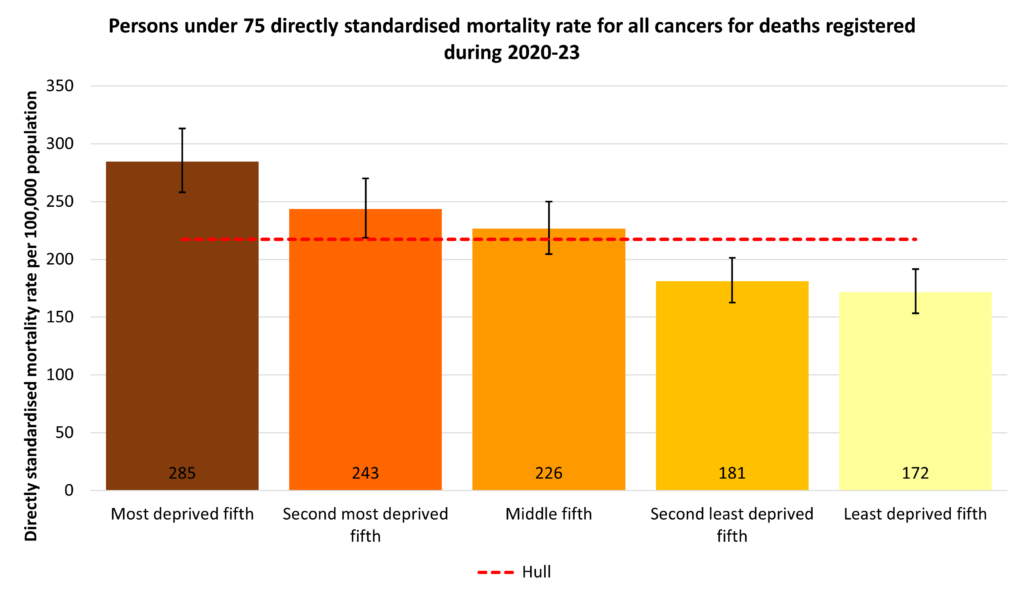
The difference in the under 75 year cancer mortality rate was also a similar magnitude between the most and least deprived fifths for men being 1.7 times higher among men living in the most deprived fifth of areas of Hull (317 versus 191 per 100,000 population).
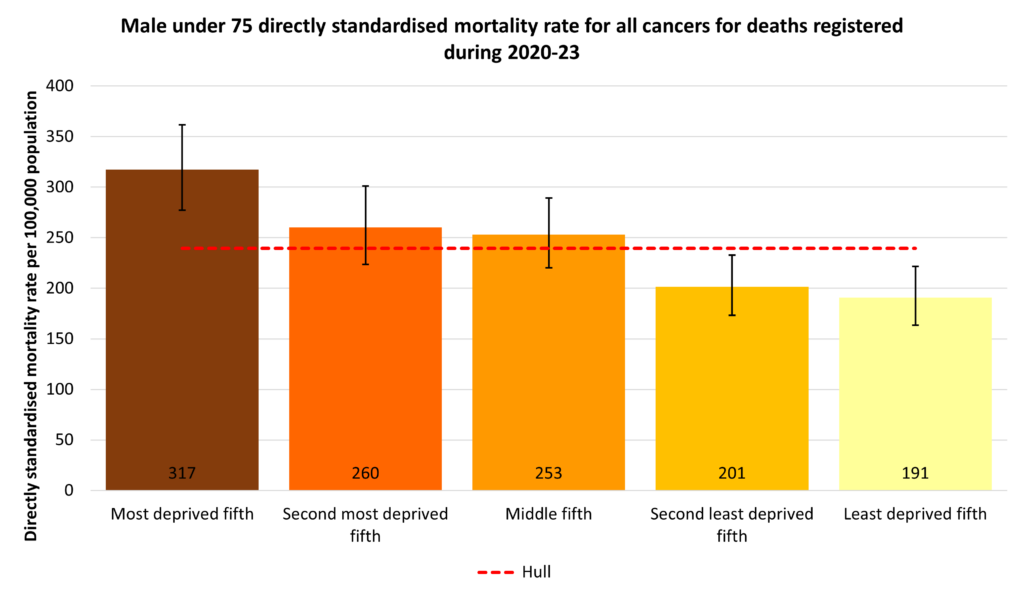
The same difference was evident for females too with the mortality rate 1.7 times higher in the most deprived fifth of areas compared to the least deprived fifth of areas of Hull (255 versus 153 per 100,000 population).
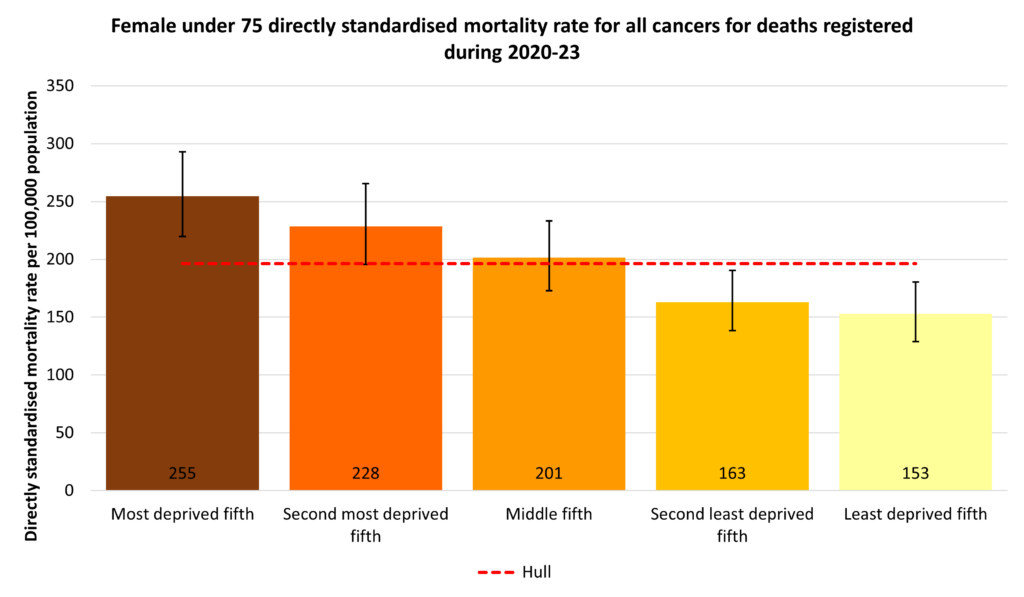
Cancers Considered Preventable
The Office for Health Improvement & Disparities’ Fingertips also gives the mortality rates for cancers that occur prior to the age of 75 years that are considered to be preventable.
For 2022-24, the under 75 standardised mortality rate is 34% higher in Hull than England, but the under 75 mortality rate from causes considered preventable is 51% higher in Hull. Thus, more of the premature cancer deaths in Hull are considered to be preventable.
Compared with benchmark
| Indicator | Period | England | Yorkshire and the Humber region (statistical) | Kingston upon Hull | East Riding of Yorkshire | North East Lincolnshire | North Lincolnshire | York | North Yorkshire UA | Barnsley | Doncaster | Rotherham | Sheffield | Bradford | Calderdale | Kirklees | Leeds | Wakefield |
|---|---|---|---|---|---|---|---|---|---|---|---|---|---|---|---|---|---|---|
Under 75 mortality rate from cancer (Persons <75 yrs) | 2022 - 24 | 120.3 | 128.4 | 161.0 | 114.8 | 145.2 | 133.1 | 117.0 | 106.1 | 144.7 | 148.6 | 139.5 | 132.2 | 132.6 | 124.8 | 120.8 | 126.3 | 133.6 |
Under 75 mortality rate from cancer (Male <75 yrs) | 2022 - 24 | 133.3 | 140.9 | 180.1 | 122.7 | 163.4 | 144.5 | 122.5 | 115.3 | 159.7 | 165.8 | 144.5 | 141.8 | 147.5 | 140.2 | 134.1 | 142.7 | 145.3 |
Under 75 mortality rate from cancer (Female <75 yrs) | 2022 - 24 | 108.3 | 116.6 | 142.3 | 107.3 | 128.0 | 122.1 | 111.9 | 97.3 | 130.2 | 132.3 | 135.0 | 123.2 | 118.3 | 110.4 | 108.2 | 111.3 | 122.8 |
Under 75 mortality rate from cancer considered preventable (Persons <75 yrs) | 2022 - 24 | 48.6 | 54.3 | 73.4 | 43.7 | 61.3 | 59.8 | 46.1 | 41.4 | 63.1 | 68.7 | 59.4 | 53.3 | 60.0 | 56.1 | 53.9 | 51.2 | 57.2 |
Under 75 mortality rate from cancer considered preventable (Male <75 yrs) | 2022 - 24 | 61.1 | 66.6 | 87.9 | 53.6 | 73.9 | 74.1 | 54.5 | 52.0 | 79.3 | 82.2 | 72.9 | 65.5 | 73.3 | 65.5 | 66.9 | 65.0 | 66.5 |
Under 75 mortality rate from cancer considered preventable (Female <75 yrs) | 2022 - 24 | 36.9 | 42.7 | 59.2 | 34.3 | 49.5 | 46.1 | 38.3 | 31.4 | 47.5 | 55.7 | 46.7 | 41.7 | 47.3 | 47.2 | 41.5 | 38.3 | 48.4 |
| Indicator | Period | England | Yorkshire and the Humber region (statistical) | Kingston upon Hull | East Riding of Yorkshire | North East Lincolnshire | North Lincolnshire | York | North Yorkshire UA | Barnsley | Doncaster | Rotherham | Sheffield | Bradford | Calderdale | Kirklees | Leeds | Wakefield |
|---|---|---|---|---|---|---|---|---|---|---|---|---|---|---|---|---|---|---|
Under 75 mortality rate from cancer (Persons <75 yrs) | 2022 - 24 | 120.3 | 128.4 | 161.0 | 114.8 | 145.2 | 133.1 | 117.0 | 106.1 | 144.7 | 148.6 | 139.5 | 132.2 | 132.6 | 124.8 | 120.8 | 126.3 | 133.6 |
Under 75 mortality rate from cancer (Male <75 yrs) | 2022 - 24 | 133.3 | 140.9 | 180.1 | 122.7 | 163.4 | 144.5 | 122.5 | 115.3 | 159.7 | 165.8 | 144.5 | 141.8 | 147.5 | 140.2 | 134.1 | 142.7 | 145.3 |
Under 75 mortality rate from cancer (Female <75 yrs) | 2022 - 24 | 108.3 | 116.6 | 142.3 | 107.3 | 128.0 | 122.1 | 111.9 | 97.3 | 130.2 | 132.3 | 135.0 | 123.2 | 118.3 | 110.4 | 108.2 | 111.3 | 122.8 |
Under 75 mortality rate from cancer considered preventable (Persons <75 yrs) | 2022 - 24 | 48.6 | 54.3 | 73.4 | 43.7 | 61.3 | 59.8 | 46.1 | 41.4 | 63.1 | 68.7 | 59.4 | 53.3 | 60.0 | 56.1 | 53.9 | 51.2 | 57.2 |
Under 75 mortality rate from cancer considered preventable (Male <75 yrs) | 2022 - 24 | 61.1 | 66.6 | 87.9 | 53.6 | 73.9 | 74.1 | 54.5 | 52.0 | 79.3 | 82.2 | 72.9 | 65.5 | 73.3 | 65.5 | 66.9 | 65.0 | 66.5 |
Under 75 mortality rate from cancer considered preventable (Female <75 yrs) | 2022 - 24 | 36.9 | 42.7 | 59.2 | 34.3 | 49.5 | 46.1 | 38.3 | 31.4 | 47.5 | 55.7 | 46.7 | 41.7 | 47.3 | 47.2 | 41.5 | 38.3 | 48.4 |
Of the 1,037 cancer deaths under the age of 75 years which were registered during 2022-24, 468 (45%) of them were considered to be preventable.
Compared with benchmark
Under 75 mortality rate from cancer considered preventable (Persons <75 yrs) 2022 - 24
| Area |
Recent
Trend |
Count
|
Value
|
95%
Lower CI |
95%
Upper CI |
|
|---|---|---|---|---|---|---|
| England | 71743 | 48.6 | 48.2 | 49.0 | ||
| Yorkshire and the Humber region (statistical) | 8015 | 54.3 | 53.2 | 55.5 | ||
| Kingston upon Hull | 468 | 73.4 | 66.9 | 80.4 | ||
| East Riding of Yorkshire | 521 | 43.7 | 40.0 | 47.7 | ||
| North East Lincolnshire | 278 | 61.3 | 54.3 | 69.0 | ||
| North Lincolnshire | 311 | 59.8 | 53.3 | 66.8 | ||
| York | 236 | 46.1 | 40.4 | 52.4 | ||
| North Yorkshire UA | 857 | 41.4 | 38.6 | 44.3 | ||
| Barnsley | 439 | 63.1 | 57.3 | 69.3 | ||
| Doncaster | 594 | 68.7 | 63.2 | 74.4 | ||
| Rotherham | 435 | 59.4 | 54.0 | 65.3 | ||
| Sheffield | 698 | 53.3 | 49.4 | 57.4 | ||
| Bradford | 755 | 60.0 | 55.8 | 64.4 | ||
| Calderdale | 325 | 56.1 | 50.1 | 62.5 | ||
| Kirklees | 606 | 53.9 | 49.7 | 58.4 | ||
| Leeds | 931 | 51.2 | 47.9 | 54.6 | ||
| Wakefield | 558 | 57.2 | 52.6 | 62.2 |
Source: OHID, based on Office for National Statistics data
For men, of the 574 cancer deaths under the age of 75 years which were registered during 2022-24, 278 (48%) of them were considered to be preventable.
Compared with benchmark
Under 75 mortality rate from cancer considered preventable (Male <75 yrs) 2022 - 24
| Area |
Recent
Trend |
Count
|
Value
|
95%
Lower CI |
95%
Upper CI |
|
|---|---|---|---|---|---|---|
| England | 43621 | 61.1 | 60.5 | 61.7 | ||
| Yorkshire and the Humber region (statistical) | 4789 | 66.6 | 64.7 | 68.5 | ||
| Kingston upon Hull | 278 | 87.9 | 77.8 | 98.9 | ||
| East Riding of Yorkshire | 312 | 53.6 | 47.8 | 60.0 | ||
| North East Lincolnshire | 164 | 73.9 | 63.0 | 86.1 | ||
| North Lincolnshire | 189 | 74.1 | 63.9 | 85.5 | ||
| York | 134 | 54.5 | 45.7 | 64.6 | ||
| North Yorkshire UA | 526 | 52.0 | 47.6 | 56.7 | ||
| Barnsley | 271 | 79.3 | 70.1 | 89.3 | ||
| Doncaster | 348 | 82.2 | 73.8 | 91.4 | ||
| Rotherham | 260 | 72.9 | 64.3 | 82.3 | ||
| Sheffield | 418 | 65.5 | 59.4 | 72.1 | ||
| Bradford | 452 | 73.3 | 66.6 | 80.4 | ||
| Calderdale | 184 | 65.5 | 56.3 | 75.6 | ||
| Kirklees | 367 | 66.9 | 60.3 | 74.2 | ||
| Leeds | 570 | 65.0 | 59.8 | 70.6 | ||
| Wakefield | 316 | 66.5 | 59.4 | 74.3 |
Source: OHID, based on Office for National Statistics data
For women, of the 463 cancer deaths under the age of 75 years which were registered during 2022-24, 190 (41%) of them were considered to be preventable.
Compared with benchmark
Under 75 mortality rate from cancer considered preventable (Female <75 yrs) 2022 - 24
| Area |
Recent
Trend |
Count
|
Value
|
95%
Lower CI |
95%
Upper CI |
|
|---|---|---|---|---|---|---|
| England | 28122 | 36.9 | 36.5 | 37.3 | ||
| Yorkshire and the Humber region (statistical) | 3226 | 42.7 | 41.2 | 44.2 | ||
| Kingston upon Hull | 190 | 59.2 | 51.1 | 68.3 | ||
| East Riding of Yorkshire | 209 | 34.3 | 29.8 | 39.3 | ||
| North East Lincolnshire | 114 | 49.5 | 40.8 | 59.5 | ||
| North Lincolnshire | 122 | 46.1 | 38.3 | 55.1 | ||
| York | 102 | 38.3 | 31.2 | 46.5 | ||
| North Yorkshire UA | 331 | 31.4 | 28.1 | 35.0 | ||
| Barnsley | 168 | 47.5 | 40.6 | 55.3 | ||
| Doncaster | 246 | 55.7 | 49.0 | 63.1 | ||
| Rotherham | 175 | 46.7 | 40.1 | 54.2 | ||
| Sheffield | 280 | 41.7 | 36.9 | 46.9 | ||
| Bradford | 303 | 47.3 | 42.1 | 52.9 | ||
| Calderdale | 141 | 47.2 | 39.7 | 55.7 | ||
| Kirklees | 239 | 41.5 | 36.4 | 47.1 | ||
| Leeds | 361 | 38.3 | 34.5 | 42.5 | ||
| Wakefield | 242 | 48.4 | 42.5 | 55.0 |
Source: OHID, based on Office for National Statistics data
The premature mortality from cancer considered to be preventable has gradually decreased in Hull between 2001-03 and 2022-24 albeit with some year-on-year variability.
Compared with benchmark
Under 75 mortality rate from cancer considered preventable (Persons <75 yrs)
|
Period
|
Kingston upon Hull |
Yorkshire and the Humber region (statistical)
|
England
|
||||
|---|---|---|---|---|---|---|---|
|
Count
|
Value
|
95%
Lower CI |
95%
Upper CI |
||||
| 2001 - 03 | • | 562 | 106.9 | 98.2 | 116.1 | 78.1 | 69.6 |
| 2002 - 04 | • | 560 | 106.4 | 97.8 | 115.6 | 77.4 | 68.3 |
| 2003 - 05 | • | 554 | 104.9 | 96.3 | 114.0 | 74.7 | 67.0 |
| 2004 - 06 | • | 565 | 106.8 | 98.2 | 116.1 | 74.0 | 66.3 |
| 2005 - 07 | • | 535 | 101.5 | 93.1 | 110.6 | 73.7 | 65.9 |
| 2006 - 08 | • | 541 | 103.4 | 94.8 | 112.5 | 73.1 | 65.6 |
| 2007 - 09 | • | 540 | 103.3 | 94.7 | 112.4 | 72.4 | 65.2 |
| 2008 - 10 | • | 554 | 104.7 | 96.1 | 113.9 | 71.2 | 64.5 |
| 2009 - 11 | • | 560 | 105.2 | 96.6 | 114.4 | 71.6 | 64.0 |
| 2010 - 12 | • | 529 | 98.6 | 90.3 | 107.5 | 70.9 | 63.2 |
| 2011 - 13 | • | 528 | 97.0 | 88.8 | 105.7 | 70.1 | 62.6 |
| 2012 - 14 | • | 510 | 92.0 | 84.1 | 100.4 | 68.2 | 61.4 |
| 2013 - 15 | • | 530 | 94.9 | 86.9 | 103.4 | 66.9 | 60.2 |
| 2014 - 16 | • | 513 | 90.4 | 82.6 | 98.6 | 65.0 | 58.9 |
| 2015 - 17 | • | 520 | 89.9 | 82.3 | 98.0 | 63.3 | 57.5 |
| 2016 - 18 | • | 474 | 79.6 | 72.5 | 87.1 | 61.4 | 56.0 |
| 2017 - 19 | • | 477 | 78.5 | 71.6 | 85.8 | 60.0 | 54.3 |
| 2018 - 20 | • | 451 | 72.6 | 66.1 | 79.7 | 58.9 | 52.9 |
| 2019 - 21 | • | 483 | 76.4 | 69.7 | 83.5 | 58.1 | 51.5 |
| 2020 - 22 | • | 475 | 74.4 | 67.9 | 81.4 | 57.1 | 50.5 |
| 2021 - 23 | • | 481 | 75.3 | 68.7 | 82.4 | 56.2 | 49.5 |
| 2022 - 24 | • | 468 | 73.4 | 66.9 | 80.4 | 54.3 | 48.6 |
Source: OHID, based on Office for National Statistics data
This gradual decrease with some year-on-year variability has occurred for men.
Compared with benchmark
Under 75 mortality rate from cancer considered preventable (Male <75 yrs)
|
Period
|
Kingston upon Hull |
Yorkshire and the Humber region (statistical)
|
England
|
||||
|---|---|---|---|---|---|---|---|
|
Count
|
Value
|
95%
Lower CI |
95%
Upper CI |
||||
| 2001 - 03 | • | 367 | 145.9 | 131.3 | 161.7 | 104.7 | 95.5 |
| 2002 - 04 | • | 358 | 143.0 | 128.5 | 158.6 | 102.8 | 93.1 |
| 2003 - 05 | • | 348 | 137.0 | 122.9 | 152.2 | 97.8 | 90.6 |
| 2004 - 06 | • | 354 | 138.0 | 123.9 | 153.2 | 96.0 | 88.8 |
| 2005 - 07 | • | 337 | 131.1 | 117.4 | 146.0 | 94.9 | 87.6 |
| 2006 - 08 | • | 342 | 135.0 | 121.0 | 150.2 | 93.6 | 86.4 |
| 2007 - 09 | • | 335 | 131.8 | 118.0 | 146.9 | 92.2 | 85.6 |
| 2008 - 10 | • | 331 | 129.4 | 115.8 | 144.3 | 89.8 | 84.3 |
| 2009 - 11 | • | 321 | 124.6 | 111.2 | 139.2 | 90.6 | 83.2 |
| 2010 - 12 | • | 292 | 112.4 | 99.7 | 126.2 | 89.4 | 81.7 |
| 2011 - 13 | • | 303 | 113.9 | 101.3 | 127.7 | 88.5 | 80.7 |
| 2012 - 14 | • | 299 | 110.7 | 98.4 | 124.2 | 86.0 | 79.1 |
| 2013 - 15 | • | 316 | 116.4 | 103.7 | 130.2 | 84.3 | 77.3 |
| 2014 - 16 | • | 309 | 111.8 | 99.5 | 125.2 | 81.5 | 75.1 |
| 2015 - 17 | • | 315 | 110.8 | 98.8 | 123.9 | 79.3 | 73.2 |
| 2016 - 18 | • | 299 | 101.6 | 90.3 | 113.8 | 76.7 | 71.1 |
| 2017 - 19 | • | 289 | 95.6 | 84.8 | 107.3 | 75.4 | 69.0 |
| 2018 - 20 | • | 275 | 89.2 | 79.0 | 100.5 | 73.7 | 66.9 |
| 2019 - 21 | • | 301 | 95.7 | 85.2 | 107.2 | 72.4 | 65.0 |
| 2020 - 22 | • | 296 | 93.2 | 82.8 | 104.4 | 70.0 | 63.6 |
| 2021 - 23 | • | 296 | 93.3 | 82.9 | 104.6 | 68.7 | 62.2 |
| 2022 - 24 | • | 278 | 87.9 | 77.8 | 98.9 | 66.6 | 61.1 |
Source: OHID, based on Office for National Statistics data
Among women, the premature mortality from cancer considered to be preventable increased quite sharply between 2001-03 and 2009-11, before gradually decreasing between 2009-11 and 2016-18 with no substantial changes between 2016-18 and 2020-22. However, there has been an increase in the last couple of years.
Compared with benchmark
Under 75 mortality rate from cancer considered preventable (Female <75 yrs)
|
Period
|
Kingston upon Hull |
Yorkshire and the Humber region (statistical)
|
England
|
||||
|---|---|---|---|---|---|---|---|
|
Count
|
Value
|
95%
Lower CI |
95%
Upper CI |
||||
| 2001 - 03 | • | 194 | 70.3 | 60.7 | 80.9 | 54.1 | 46.1 |
| 2002 - 04 | • | 201 | 72.4 | 62.7 | 83.1 | 54.5 | 45.6 |
| 2003 - 05 | • | 205 | 74.6 | 64.7 | 85.6 | 53.7 | 45.2 |
| 2004 - 06 | • | 210 | 77.2 | 67.1 | 88.4 | 54.0 | 45.5 |
| 2005 - 07 | • | 198 | 73.5 | 63.6 | 84.5 | 54.2 | 45.8 |
| 2006 - 08 | • | 198 | 73.7 | 63.8 | 84.7 | 54.4 | 46.2 |
| 2007 - 09 | • | 205 | 76.3 | 66.2 | 87.5 | 54.0 | 46.1 |
| 2008 - 10 | • | 222 | 81.6 | 71.2 | 93.1 | 54.1 | 46.1 |
| 2009 - 11 | • | 238 | 87.1 | 76.3 | 98.9 | 54.0 | 46.1 |
| 2010 - 12 | • | 237 | 86.0 | 75.3 | 97.7 | 53.7 | 45.9 |
| 2011 - 13 | • | 224 | 81.0 | 70.7 | 92.3 | 52.9 | 45.6 |
| 2012 - 14 | • | 210 | 74.2 | 64.4 | 85.0 | 51.6 | 44.9 |
| 2013 - 15 | • | 213 | 74.5 | 64.8 | 85.3 | 50.5 | 44.2 |
| 2014 - 16 | • | 204 | 70.0 | 60.7 | 80.4 | 49.4 | 43.6 |
| 2015 - 17 | • | 205 | 69.8 | 60.5 | 80.0 | 48.1 | 42.8 |
| 2016 - 18 | • | 175 | 58.1 | 49.8 | 67.4 | 46.9 | 41.8 |
| 2017 - 19 | • | 188 | 61.6 | 53.1 | 71.0 | 45.3 | 40.4 |
| 2018 - 20 | • | 176 | 56.2 | 48.2 | 65.2 | 44.8 | 39.6 |
| 2019 - 21 | • | 182 | 57.3 | 49.2 | 66.2 | 44.6 | 38.9 |
| 2020 - 22 | • | 179 | 56.0 | 48.1 | 64.8 | 44.9 | 38.3 |
| 2021 - 23 | • | 185 | 57.7 | 49.7 | 66.7 | 44.4 | 37.6 |
| 2022 - 24 | • | 190 | 59.2 | 51.1 | 68.3 | 42.7 | 36.9 |
Source: OHID, based on Office for National Statistics data
Deaths Considered Preventable Differences Across Hull’s Wards
There was a two-fold difference in the directly standardised mortality rate for cancers considered to be preventable that occurred under the age of 75 years in Hull for deaths which were registered during 2020-23.
The highest rates occurred in Marfleet (111 deaths per 100,000 population), St Andrew’s & Docklands (98), Newington & Gipsyville (95), Orchard Park (92) and Central (90), although only for Marfleet was the rate statistically significantly higher than the Hull average (71 deaths per 100,000 population). There were fewer than 10 deaths from cancer that were considered to be preventable for Kingswood registered within the four year period and it is not possible to calculate a reliable estimate of the directly standardised mortality rate with fewer than ten deaths.
The mortality rates were statistically significantly lower than the Hull average for Bricknell and Holderness wards.
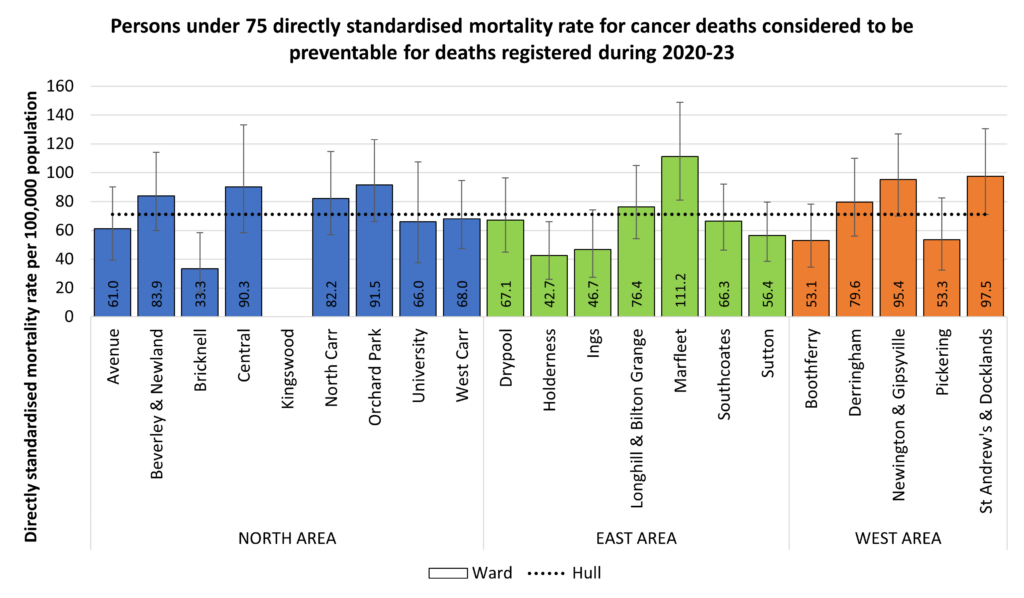
Among men, the highest mortality rates were found in Marfleet (139 per 100,000 population), Beverley & Newland (130), Orchard Park (122), Newington & Gipsyville (109), St Andrew’s & Docklands (108) and University (104), with only the rate in Marfleet ward being statistically significantly higher than the Hull average (88 deaths per 100,000 population). There were fewer than 10 male deaths in Kingswood ward from cancer that was considered preventable, so no rate could be produced for this ward.
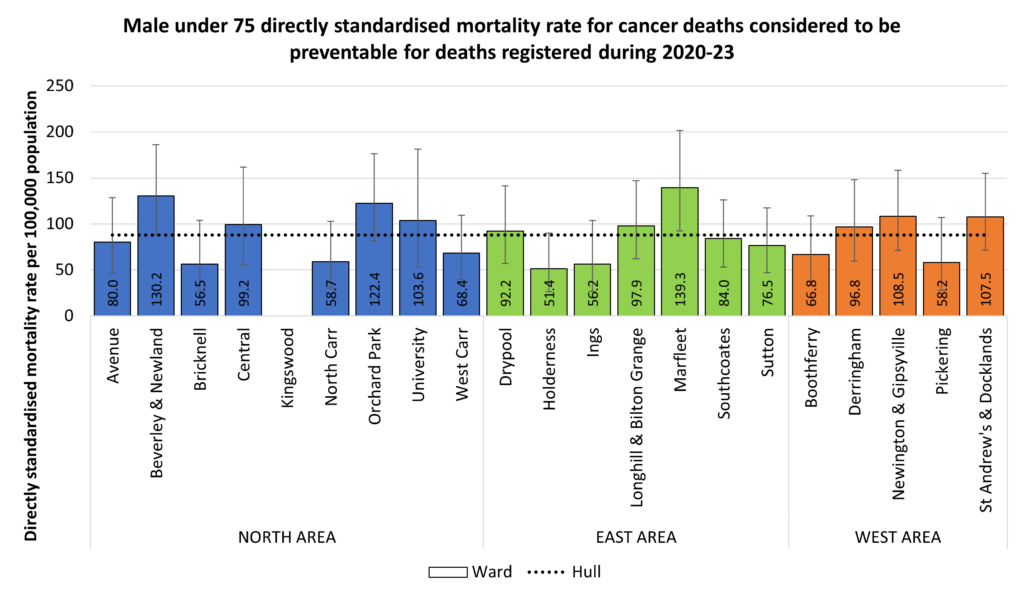
Among women, the highest mortality rates from cancer considered to be preventable occurred within North Carr (102 per 100,000 population), Marfleet (85), St Andrew’s & Docklands (84) and Newington & Gipsyville (81), with only the rate for North Carr statistically significantly higher than the Hull average (54 per 100,000 population). North Carr, West Carr and Orchard Park also had high mortality rates among women for deaths registered during 2014-21.
There were fewer than 10 female deaths from cancer that were considered to be preventable for Avenue, Bricknell, Central, Kingswood, University, Drypool, Holderness, Ings and Boothferry wards registered within the four-year period and it was not possible to calculate a reliable estimate of the directly standardised mortality rates for these wards.
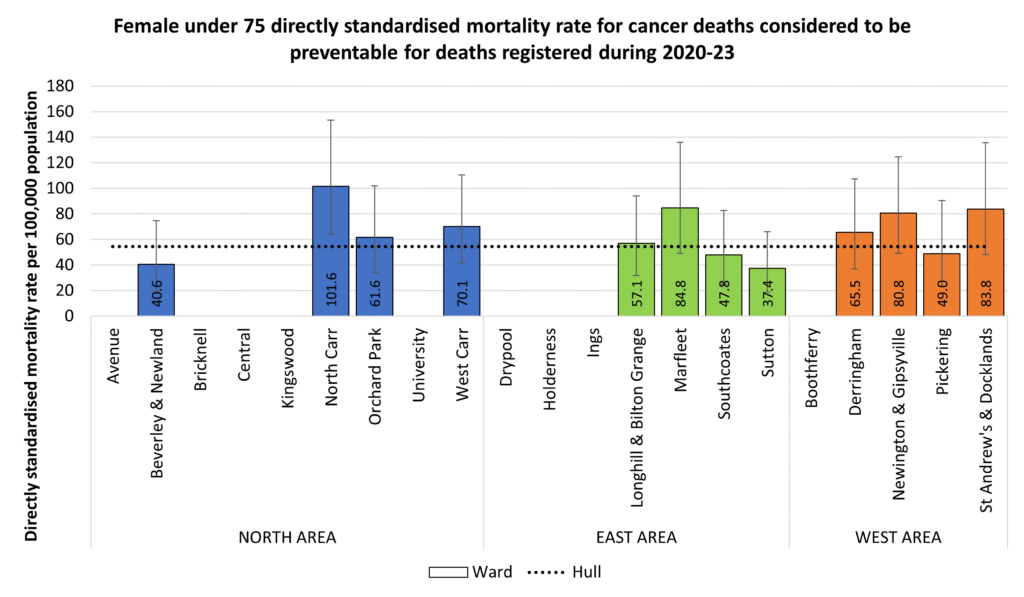
Deaths Considered Preventable Differences By Local Deprivation Fifth
Across the different areas of Hull based on deprivation, there was a huge difference in the directly standardised mortality rate for cancer deaths considered preventable that occurred under the age of 75 years that were registered during 2020-23. The mortality rate was 99 deaths per 100,000 population among people who lived in the most deprived fifth of areas of Hull compared to 49 deaths per 100,000 population among people who lived in the least deprived fifth of areas of Hull. The differences were very stark, and were statistically significant. The mortality rate was two times higher among people living in the most deprived fifth of areas of Hull.
The relative difference between the most and least deprived areas of Hull was greater for cancer deaths considered to be preventable compared to cancer deaths under the age of 75 years.
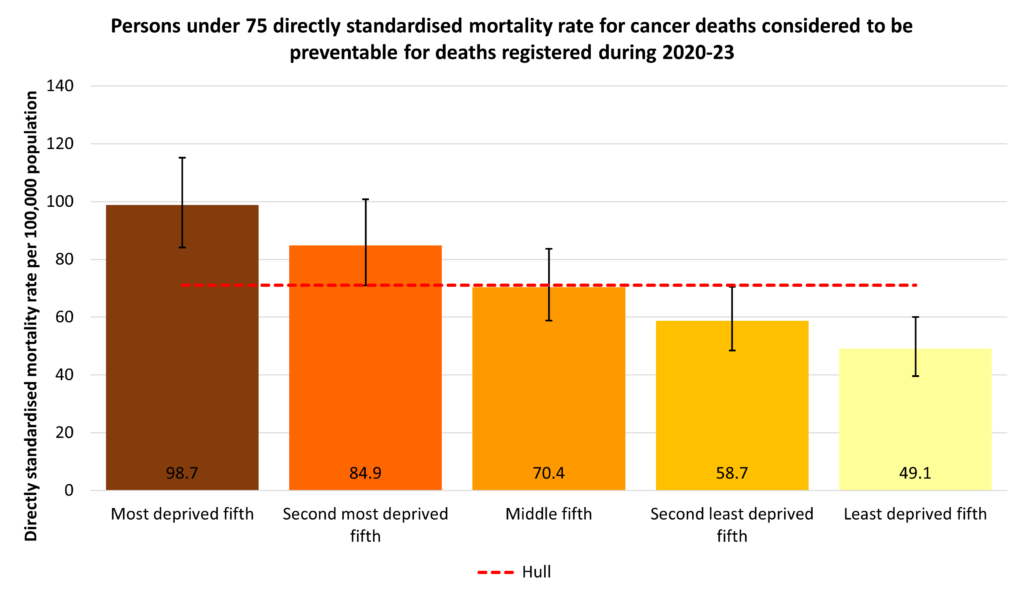
A similar pattern of mortality across the local deprivation fifths occurred for men with a wide difference in the mortality rates between the most and least deprived fifth of areas of Hull (111 versus 72 per 100,000 population). The mortality rate was 1.5 times higher among men living in the most deprived fifth of areas of Hull.

For women, the differences were even more marked with the mortality rate being 3.2 times higher among women living in the most deprived fifth of areas of Hull. The directly standardised mortality rate was 86 per 100,000 population among women living in the most deprived areas of Hull compared to 27 per 100,000 population among women living in the least deprived areas of Hull.
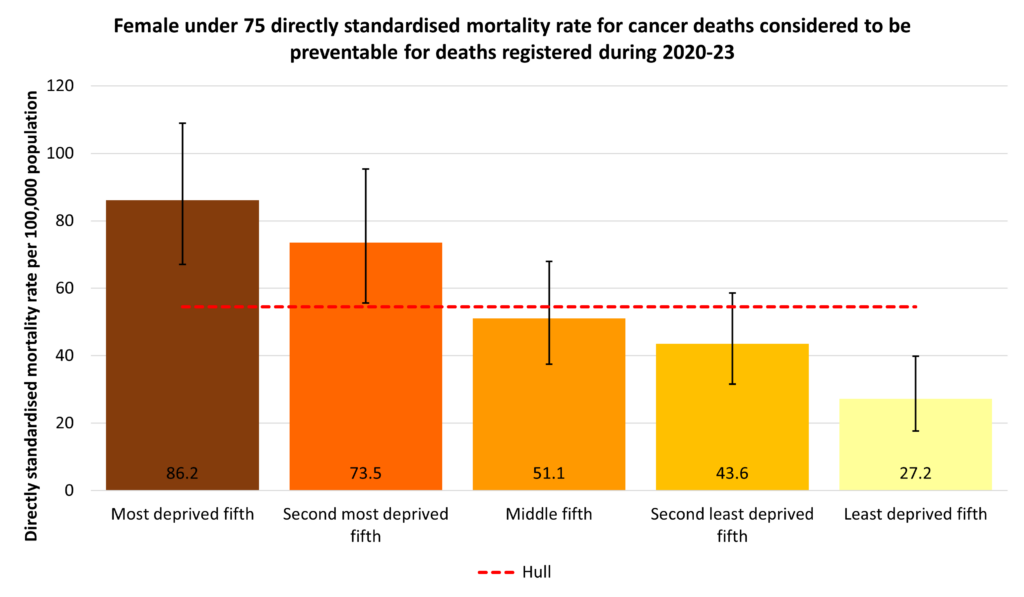
Deaths by Cancer Site
From the National Cancer Registration and Analysis Service, the number of deaths from different cancer sites for males and females separately are given for the three year period 2018-20.
Over the three year period, there were 1,064 cancer deaths among men and 953 cancer deaths among women. The highest proportion were lung cancer deaths for both men (28%) and women (27%) followed by breast cancer deaths for women (15%), prostate cancer deaths for men (13%), and colorectal deaths for men (10%) and women (9%).
| Cancer site | ICD 10 code | Males | Females | Persons |
| Oesophagus | C15 | 62 | 31 | 93 |
| Stomach | C16 | 44 | 19 | 63 |
| Colorectal | C18-C20 | 108 | 85 | 193 |
| Liver and intrahepatic bile ducts | C22 | 28 | 20 | 48 |
| Pancreas | C25 | 50 | 44 | 94 |
| Trachea, bronchus and lung | C33-C34 | 295 | 253 | 548 |
| Malignant melanoma of skin | C43 | 12 | 5 | 17 |
| Breast | C50 | 145 | ||
| Cervix uteri | C53 | 9 | 9 | |
| Uterus | C54-C55 | 25 | 25 | |
| Ovary | C56-C57 | 30 | 30 | |
| Prostate | C61 | 139 | 139 | |
| Kidney, except renal pelvis | C64 | 24 | 23 | 47 |
| Bladder | C67 | 37 | 24 | 61 |
| Multiple myeloma and plasma cell neoplasms | C90 | 18 | 15 | 33 |
| Leukaemia | C91-C95 | 23 | 19 | 42 |
| All cancers | C00-C97 excl C44 | 1,064 | 953 | 2,017 |
The table below gives the standardised mortality rate so compares the number of deaths in Hull with England after adjusting for the age structure of Hull’s population. The rates are given as the number of cancers deaths occurring over the three year period 2018-20 per 100,000 person-years . For most cancers, the numbers are relatively small so it is not possible to examine mortality rate for males and females separately.
The all-age mortality rates in Hull are more than 20% higher than those of England for cancer of the lung (72%), stomach (66%), breast (29%) and oesophagus (22%). The mortality rate from liver cancer, skin cancer and ovarian cancer were lower in Hull as were rates of leukaemia.
Overall, the directly standardised mortality rate from cancer was 27% higher in Hull compared to England (22% for men and 30% for women).
| Cancer site | ICD 10 code | Gender | Hull | England |
| Oesophagus | C15 | Persons | 15.8 | 13.0 |
| Stomach | C16 | Persons | 10.8 | 6.5 |
| Colorectal | C18-C20 | Males | 40.0 | 33.7 |
| Colorectal | C18-C20 | Females | 26.0 | 22.0 |
| Colorectal | C18-C20 | Persons | 32.6 | 27.2 |
| Liver and intrahepatic bile ducts | C22 | Persons | 8.1 | 9.7 |
| Pancreas | C25 | Persons | 15.9 | 16.1 |
| Trachea, bronchus and lung | C33-C34 | Males | 109.1 | 64.7 |
| Trachea, bronchus and lung | C33-C34 | Females | 80.2 | 46.1 |
| Trachea, bronchus and lung | C33-C34 | Persons | 93.2 | 54.3 |
| Malignant melanoma of skin | C43 | Persons | 2.8 | 3.9 |
| Breast | C50 | Females | 44.3 | 34.4 |
| Uterus | C54-C55 | Females | 7.9 | 7.4 |
| Ovary | C56-C57 | Females | 9.3 | 13.0 |
| Prostate | C61 | Males | 56.1 | 48.1 |
| Kidney, except renal pelvis | C64 | Persons | 7.9 | 6.6 |
| Bladder | C67 | Persons | 10.6 | 9.1 |
| Multiple myeloma and plasma cell neoplasms | C90 | Persons | 5.7 | 5.2 |
| Leukaemia | C91-C95 | Persons | 7.2 | 7.9 |
| All cancers | C00-C97 excl C44 | Males | 398.4 | 325.5 |
| All cancers | C00-C97 excl C44 | Females | 296.5 | 228.5 |
| All cancers | C00-C97 excl C44 | Persons | 342.0 | 269.7 |
Lung Cancer
For deaths registered during 2021-23, compared to England, mortality rates from lung cancer (all deaths at any age) were 83% higher in Hull.
Compared with benchmark
| Indicator | Period | England | Yorkshire and the Humber region (statistical) | Kingston upon Hull | East Riding of Yorkshire | North East Lincolnshire | North Lincolnshire | York | North Yorkshire UA | Barnsley | Doncaster | Rotherham | Sheffield | Bradford | Calderdale | Kirklees | Leeds | Wakefield |
|---|---|---|---|---|---|---|---|---|---|---|---|---|---|---|---|---|---|---|
Mortality rate from lung cancer, all ages (Persons All ages) | 2022 - 24 | 46.4 | 54.9 | 83.0 | 45.6 | 63.9 | 53.8 | 43.4 | 39.2 | 64.9 | 67.6 | 57.4 | 58.4 | 57.5 | 57.3 | 56.1 | 53.3 | 59.8 |
Mortality rate from lung cancer, all ages (Male All ages) | 2022 - 24 | 53.2 | 61.5 | 93.3 | 51.4 | 75.5 | 67.5 | 43.8 | 43.2 | 74.6 | 76.9 | 61.6 | 66.9 | 63.7 | 63.8 | 63.3 | 59.7 | 63.3 |
Mortality rate from lung cancer, all ages (Female All ages) | 2022 - 24 | 41.2 | 49.8 | 75.5 | 41.1 | 54.3 | 42.2 | 44.0 | 36.3 | 56.4 | 60.9 | 53.8 | 51.7 | 52.6 | 52.5 | 50.6 | 48.4 | 57.8 |
| Indicator | Period | England | Yorkshire and the Humber region (statistical) | Kingston upon Hull | East Riding of Yorkshire | North East Lincolnshire | North Lincolnshire | York | North Yorkshire UA | Barnsley | Doncaster | Rotherham | Sheffield | Bradford | Calderdale | Kirklees | Leeds | Wakefield |
|---|---|---|---|---|---|---|---|---|---|---|---|---|---|---|---|---|---|---|
Mortality rate from lung cancer, all ages (Persons All ages) | 2022 - 24 | 46.4 | 54.9 | 83.0 | 45.6 | 63.9 | 53.8 | 43.4 | 39.2 | 64.9 | 67.6 | 57.4 | 58.4 | 57.5 | 57.3 | 56.1 | 53.3 | 59.8 |
Mortality rate from lung cancer, all ages (Male All ages) | 2022 - 24 | 53.2 | 61.5 | 93.3 | 51.4 | 75.5 | 67.5 | 43.8 | 43.2 | 74.6 | 76.9 | 61.6 | 66.9 | 63.7 | 63.8 | 63.3 | 59.7 | 63.3 |
Mortality rate from lung cancer, all ages (Female All ages) | 2022 - 24 | 41.2 | 49.8 | 75.5 | 41.1 | 54.3 | 42.2 | 44.0 | 36.3 | 56.4 | 60.9 | 53.8 | 51.7 | 52.6 | 52.5 | 50.6 | 48.4 | 57.8 |
There were 565 deaths from lung cancer among Hull residents that were registered during 2021-23 (290 men and 275 women).
It can be seen that the mortality rate from lung cancer is statistically significantly higher than all the other local authorities in the region. The mortality rate is second highest among upper-tier local authorities in England (out of 151), and is highest for men and fourth highest among women.
Compared with benchmark
Mortality rate from lung cancer, all ages (Persons All ages) 2022 - 24
| Area |
Recent
Trend |
Count
|
Value
|
95%
Lower CI |
95%
Upper CI |
|
|---|---|---|---|---|---|---|
| England | 78794 | 46.4 | 46.1 | 46.8 | ||
| Yorkshire and the Humber region (statistical) | 9226 | 54.9 | 53.8 | 56.0 | ||
| Kingston upon Hull | 546 | 83.0 | 76.1 | 90.2 | ||
| East Riding of Yorkshire | 663 | 45.6 | 42.2 | 49.2 | ||
| North East Lincolnshire | 336 | 63.9 | 57.2 | 71.1 | ||
| North Lincolnshire | 322 | 53.8 | 48.1 | 60.1 | ||
| York | 272 | 43.4 | 38.3 | 48.9 | ||
| North Yorkshire UA | 980 | 39.2 | 36.8 | 41.8 | ||
| Barnsley | 499 | 64.9 | 59.3 | 70.9 | ||
| Doncaster | 649 | 67.6 | 62.5 | 73.0 | ||
| Rotherham | 476 | 57.4 | 52.3 | 62.8 | ||
| Sheffield | 897 | 58.4 | 54.6 | 62.4 | ||
| Bradford | 778 | 57.5 | 53.5 | 61.6 | ||
| Calderdale | 361 | 57.3 | 51.5 | 63.5 | ||
| Kirklees | 700 | 56.1 | 52.0 | 60.4 | ||
| Leeds | 1095 | 53.3 | 50.2 | 56.5 | ||
| Wakefield | 652 | 59.8 | 55.3 | 64.6 |
Source: OHID, based on Office for National Statistics data
Mortality rate from lung cancer, all ages (Male All ages) 2022 - 24
| Area |
Recent
Trend |
Count
|
Value
|
95%
Lower CI |
95%
Upper CI |
|
|---|---|---|---|---|---|---|
| England | 40905 | 53.2 | 52.7 | 53.7 | ||
| Yorkshire and the Humber region (statistical) | 4699 | 61.5 | 59.7 | 63.3 | ||
| Kingston upon Hull | 281 | 93.3 | 82.4 | 105.2 | ||
| East Riding of Yorkshire | 341 | 51.4 | 46.0 | 57.2 | ||
| North East Lincolnshire | 184 | 75.5 | 64.9 | 87.2 | ||
| North Lincolnshire | 188 | 67.5 | 58.1 | 77.9 | ||
| York | 121 | 43.8 | 36.3 | 52.4 | ||
| North Yorkshire UA | 496 | 43.2 | 39.5 | 47.3 | ||
| Barnsley | 266 | 74.6 | 65.7 | 84.3 | ||
| Doncaster | 337 | 76.9 | 68.8 | 85.7 | ||
| Rotherham | 236 | 61.6 | 53.9 | 70.1 | ||
| Sheffield | 458 | 66.9 | 60.9 | 73.4 | ||
| Bradford | 394 | 63.7 | 57.5 | 70.3 | ||
| Calderdale | 180 | 63.8 | 54.6 | 74.1 | ||
| Kirklees | 357 | 63.3 | 56.8 | 70.3 | ||
| Leeds | 546 | 59.7 | 54.7 | 65.0 | ||
| Wakefield | 314 | 63.3 | 56.3 | 70.8 |
Source: OHID, based on Office for National Statistics data
Mortality rate from lung cancer, all ages (Female All ages) 2022 - 24
| Area |
Recent
Trend |
Count
|
Value
|
95%
Lower CI |
95%
Upper CI |
|
|---|---|---|---|---|---|---|
| England | 37889 | 41.2 | 40.8 | 41.6 | ||
| Yorkshire and the Humber region (statistical) | 4527 | 49.8 | 48.4 | 51.3 | ||
| Kingston upon Hull | 265 | 75.5 | 66.6 | 85.1 | ||
| East Riding of Yorkshire | 322 | 41.1 | 36.7 | 45.8 | ||
| North East Lincolnshire | 152 | 54.3 | 45.9 | 63.7 | ||
| North Lincolnshire | 134 | 42.2 | 35.3 | 50.0 | ||
| York | 151 | 44.0 | 37.2 | 51.7 | ||
| North Yorkshire UA | 484 | 36.3 | 33.1 | 39.7 | ||
| Barnsley | 233 | 56.4 | 49.4 | 64.2 | ||
| Doncaster | 312 | 60.9 | 54.3 | 68.0 | ||
| Rotherham | 240 | 53.8 | 47.2 | 61.1 | ||
| Sheffield | 439 | 51.7 | 47.0 | 56.9 | ||
| Bradford | 384 | 52.6 | 47.4 | 58.1 | ||
| Calderdale | 181 | 52.5 | 45.1 | 60.7 | ||
| Kirklees | 343 | 50.6 | 45.4 | 56.3 | ||
| Leeds | 549 | 48.4 | 44.4 | 52.7 | ||
| Wakefield | 338 | 57.8 | 51.8 | 64.3 |
Source: OHID, based on Office for National Statistics data
There has been a gradual decrease in the mortality rate from lung cancer in Hull although small changes in the last two years.
Compared with benchmark
Mortality rate from lung cancer, all ages (Persons All ages)
|
Period
|
Kingston upon Hull |
Yorkshire and the Humber region (statistical)
|
England
|
||||
|---|---|---|---|---|---|---|---|
|
Count
|
Value
|
95%
Lower CI |
95%
Upper CI |
||||
| 2001 - 03 | • | 638 | 110.3 | 101.9 | 119.2 | 76.8 | 65.1 |
| 2002 - 04 | • | 627 | 108.7 | 100.3 | 117.6 | 75.5 | 64.1 |
| 2003 - 05 | • | 626 | 108.5 | 100.2 | 117.4 | 73.9 | 63.4 |
| 2004 - 06 | • | 640 | 110.8 | 102.3 | 119.8 | 73.2 | 63.1 |
| 2005 - 07 | • | 633 | 109.9 | 101.4 | 118.8 | 74.3 | 63.4 |
| 2006 - 08 | • | 652 | 113.2 | 104.6 | 122.3 | 75.5 | 63.6 |
| 2007 - 09 | • | 660 | 114.6 | 106.0 | 123.7 | 75.4 | 63.3 |
| 2008 - 10 | • | 645 | 111.4 | 102.9 | 120.4 | 74.2 | 62.6 |
| 2009 - 11 | • | 634 | 109.2 | 100.9 | 118.2 | 73.4 | 61.7 |
| 2010 - 12 | • | 585 | 100.0 | 92.0 | 108.5 | 71.9 | 60.9 |
| 2011 - 13 | • | 579 | 97.9 | 90.0 | 106.2 | 71.3 | 60.3 |
| 2012 - 14 | • | 588 | 98.1 | 90.3 | 106.4 | 70.2 | 59.7 |
| 2013 - 15 | • | 622 | 103.0 | 95.0 | 111.5 | 69.0 | 58.9 |
| 2014 - 16 | • | 626 | 102.9 | 94.9 | 111.3 | 67.8 | 57.9 |
| 2015 - 17 | • | 641 | 105.2 | 97.1 | 113.7 | 66.0 | 56.6 |
| 2016 - 18 | • | 588 | 95.8 | 88.1 | 103.9 | 65.0 | 55.1 |
| 2017 - 19 | • | 592 | 95.0 | 87.4 | 103.0 | 62.9 | 53.4 |
| 2018 - 20 | • | 548 | 86.9 | 79.8 | 94.6 | 61.2 | 51.8 |
| 2019 - 21 | • | 579 | 90.7 | 83.4 | 98.5 | 59.0 | 50.2 |
| 2020 - 22 | • | 567 | 88.2 | 81.1 | 95.9 | 58.1 | 48.9 |
| 2021 - 23 | • | 565 | 87.1 | 80.0 | 94.6 | 56.3 | 47.5 |
| 2022 - 24 | • | 546 | 83.0 | 76.1 | 90.2 | 54.9 | 46.4 |
Source: OHID, based on Office for National Statistics data
Among Hull men, there has been a reduction in the lung cancer mortality rate, but the rate of decrease has slowed in recent years.
The inequalities gap between Hull and England has decreased between 2001-03 and 2021-23.
Compared with benchmark
Mortality rate from lung cancer, all ages (Male All ages)
|
Period
|
Kingston upon Hull |
Yorkshire and the Humber region (statistical)
|
England
|
||||
|---|---|---|---|---|---|---|---|
|
Count
|
Value
|
95%
Lower CI |
95%
Upper CI |
||||
| 2001 - 03 | • | 379 | 155.3 | 139.4 | 172.5 | 109.0 | 93.4 |
| 2002 - 04 | • | 373 | 152.0 | 136.3 | 168.9 | 105.4 | 90.6 |
| 2003 - 05 | • | 376 | 153.7 | 137.9 | 170.7 | 100.3 | 88.3 |
| 2004 - 06 | • | 378 | 154.8 | 138.8 | 171.9 | 97.4 | 86.6 |
| 2005 - 07 | • | 363 | 149.0 | 133.4 | 165.8 | 97.4 | 85.4 |
| 2006 - 08 | • | 372 | 151.6 | 136.0 | 168.4 | 97.9 | 84.6 |
| 2007 - 09 | • | 372 | 151.1 | 135.5 | 167.8 | 97.1 | 83.3 |
| 2008 - 10 | • | 358 | 142.7 | 127.9 | 158.8 | 94.3 | 81.6 |
| 2009 - 11 | • | 333 | 131.8 | 117.7 | 147.2 | 93.2 | 79.4 |
| 2010 - 12 | • | 299 | 115.7 | 102.7 | 129.8 | 90.2 | 77.3 |
| 2011 - 13 | • | 297 | 113.2 | 100.4 | 127.0 | 88.4 | 75.8 |
| 2012 - 14 | • | 311 | 116.5 | 103.6 | 130.4 | 86.1 | 74.4 |
| 2013 - 15 | • | 321 | 119.3 | 106.3 | 133.4 | 83.6 | 72.7 |
| 2014 - 16 | • | 326 | 119.2 | 106.3 | 133.2 | 81.5 | 71.0 |
| 2015 - 17 | • | 326 | 118.1 | 105.3 | 132.0 | 77.7 | 68.7 |
| 2016 - 18 | • | 314 | 112.3 | 99.9 | 125.8 | 76.6 | 66.6 |
| 2017 - 19 | • | 308 | 108.0 | 96.0 | 121.1 | 74.1 | 64.2 |
| 2018 - 20 | • | 295 | 102.2 | 90.6 | 114.9 | 72.4 | 61.9 |
| 2019 - 21 | • | 311 | 105.9 | 94.2 | 118.7 | 67.9 | 59.2 |
| 2020 - 22 | • | 308 | 104.9 | 93.2 | 117.6 | 65.2 | 56.9 |
| 2021 - 23 | • | 290 | 97.5 | 86.4 | 109.7 | 62.1 | 54.7 |
| 2022 - 24 | • | 281 | 93.3 | 82.4 | 105.2 | 61.5 | 53.2 |
Source: OHID, based on Office for National Statistics data
Among Hull women, the lung cancer mortality rate increased from 2001-03 to a peak in 2015-17, and whilst the mortality rate decreased between 2015-17 and 2018-20, there has been relatively little change in the mortality rate since then, and even a slight increase between 2018-20 and 2021-23.
Whilst the inequalities gap in the female lung cancer mortality rate has reduced from 2015-17 when the mortality rate peaked for Hull, the inequalities gap in 2021-23 is similar to what it was in 2001-03.
Compared with benchmark
Mortality rate from lung cancer, all ages (Female All ages)
|
Period
|
Kingston upon Hull |
Yorkshire and the Humber region (statistical)
|
England
|
||||
|---|---|---|---|---|---|---|---|
|
Count
|
Value
|
95%
Lower CI |
95%
Upper CI |
||||
| 2001 - 03 | • | 259 | 77.7 | 68.4 | 87.8 | 54.8 | 45.4 |
| 2002 - 04 | • | 254 | 76.9 | 67.7 | 87.0 | 54.8 | 45.5 |
| 2003 - 05 | • | 250 | 76.7 | 67.4 | 86.9 | 55.5 | 45.9 |
| 2004 - 06 | • | 262 | 81.2 | 71.6 | 91.7 | 56.4 | 46.5 |
| 2005 - 07 | • | 270 | 84.3 | 74.5 | 95.0 | 58.4 | 47.7 |
| 2006 - 08 | • | 280 | 87.2 | 77.2 | 98.1 | 60.0 | 48.7 |
| 2007 - 09 | • | 288 | 89.8 | 79.6 | 100.9 | 60.5 | 48.9 |
| 2008 - 10 | • | 287 | 89.3 | 79.2 | 100.4 | 60.2 | 48.9 |
| 2009 - 11 | • | 301 | 93.9 | 83.5 | 105.3 | 59.5 | 48.7 |
| 2010 - 12 | • | 286 | 88.8 | 78.7 | 99.8 | 59.0 | 48.8 |
| 2011 - 13 | • | 282 | 86.6 | 76.7 | 97.4 | 59.0 | 48.6 |
| 2012 - 14 | • | 277 | 83.8 | 74.1 | 94.4 | 58.8 | 48.6 |
| 2013 - 15 | • | 301 | 90.6 | 80.6 | 101.5 | 58.3 | 48.4 |
| 2014 - 16 | • | 300 | 89.8 | 79.8 | 100.7 | 57.7 | 48.0 |
| 2015 - 17 | • | 315 | 95.2 | 84.9 | 106.4 | 57.5 | 47.3 |
| 2016 - 18 | • | 274 | 82.8 | 73.2 | 93.3 | 56.5 | 46.2 |
| 2017 - 19 | • | 284 | 84.8 | 75.1 | 95.3 | 54.6 | 45.0 |
| 2018 - 20 | • | 253 | 74.8 | 65.8 | 84.6 | 52.5 | 43.9 |
| 2019 - 21 | • | 268 | 78.3 | 69.1 | 88.3 | 52.3 | 43.1 |
| 2020 - 22 | • | 259 | 75.5 | 66.6 | 85.4 | 52.8 | 42.7 |
| 2021 - 23 | • | 275 | 79.3 | 70.2 | 89.3 | 52.0 | 41.9 |
| 2022 - 24 | • | 265 | 75.5 | 66.6 | 85.1 | 49.8 | 41.2 |
Source: OHID, based on Office for National Statistics data
Colorectal Cancer
For deaths registered during 2021-23, the premature mortality rate from colorectal cancer (deaths under the age of 75 years) was 14% higher in Hull compared to England (18% for men and 4% for women).
Compared with benchmark
| Indicator | Period | England | Yorkshire and the Humber region (statistical) | Kingston upon Hull | East Riding of Yorkshire | North East Lincolnshire | North Lincolnshire | York | North Yorkshire UA | Barnsley | Doncaster | Rotherham | Sheffield | Bradford | Calderdale | Kirklees | Leeds | Wakefield |
|---|---|---|---|---|---|---|---|---|---|---|---|---|---|---|---|---|---|---|
Under 75 mortality rate from colorectal cancer (Persons <75 yrs) | 2022 - 24 | 11.8 | 12.0 | 14.5 | 12.2 | 13.5 | 11.1 | 12.9 | 10.4 | 11.5 | 12.4 | 10.8 | 13.0 | 11.3 | 11.9 | 10.6 | 13.5 | 13.1 |
Under 75 mortality rate from colorectal cancer (Male <75 yrs) | 2022 - 24 | 14.4 | 14.5 | 19.4 | 13.6 | 17.9 | 13.9 | 14.2 | 12.9 | 14.2 | 14.3 | 11.6 | 15.9 | 15.1 | 13.4 | 12.0 | 16.2 | 15.9 |
Under 75 mortality rate from colorectal cancer (Female <75 yrs) | 2022 - 24 | 9.4 | 9.7 | 9.7 | 10.8 | 9.3 | 8.4 | 11.7 | 8.1 | 9.0 | 10.7 | 10.0 | 10.2 | 7.6 | 10.5 | 9.3 | 11.1 | 10.4 |
| Indicator | Period | England | Yorkshire and the Humber region (statistical) | Kingston upon Hull | East Riding of Yorkshire | North East Lincolnshire | North Lincolnshire | York | North Yorkshire UA | Barnsley | Doncaster | Rotherham | Sheffield | Bradford | Calderdale | Kirklees | Leeds | Wakefield |
|---|---|---|---|---|---|---|---|---|---|---|---|---|---|---|---|---|---|---|
Under 75 mortality rate from colorectal cancer (Persons <75 yrs) | 2022 - 24 | 11.8 | 12.0 | 14.5 | 12.2 | 13.5 | 11.1 | 12.9 | 10.4 | 11.5 | 12.4 | 10.8 | 13.0 | 11.3 | 11.9 | 10.6 | 13.5 | 13.1 |
Under 75 mortality rate from colorectal cancer (Male <75 yrs) | 2022 - 24 | 14.4 | 14.5 | 19.4 | 13.6 | 17.9 | 13.9 | 14.2 | 12.9 | 14.2 | 14.3 | 11.6 | 15.9 | 15.1 | 13.4 | 12.0 | 16.2 | 15.9 |
Under 75 mortality rate from colorectal cancer (Female <75 yrs) | 2022 - 24 | 9.4 | 9.7 | 9.7 | 10.8 | 9.3 | 8.4 | 11.7 | 8.1 | 9.0 | 10.7 | 10.0 | 10.2 | 7.6 | 10.5 | 9.3 | 11.1 | 10.4 |
There were 86 deaths prior to the age of 75 years from colorectal cancer that were registered during 2021-23 (54 men and 32 women).
Compared with benchmark
Under 75 mortality rate from colorectal cancer (Persons <75 yrs) 2022 - 24
| Area |
Recent
Trend |
Count
|
Value
|
95%
Lower CI |
95%
Upper CI |
|
|---|---|---|---|---|---|---|
| England | 17551 | 11.8 | 11.7 | 12.0 | ||
| Yorkshire and the Humber region (statistical) | 1771 | 12.0 | 11.5 | 12.6 | ||
| Kingston upon Hull | 93 | 14.5 | 11.7 | 17.8 | ||
| East Riding of Yorkshire | 141 | 12.2 | 10.2 | 14.4 | ||
| North East Lincolnshire | 62 | 13.5 | 10.3 | 17.3 | ||
| North Lincolnshire | 55 | 11.1 | 8.3 | 14.5 | ||
| York | 66 | 12.9 | 10.0 | 16.5 | ||
| North Yorkshire UA | 207 | 10.4 | 9.0 | 11.9 | ||
| Barnsley | 81 | 11.5 | 9.2 | 14.4 | ||
| Doncaster | 106 | 12.4 | 10.2 | 15.1 | ||
| Rotherham | 79 | 10.8 | 8.5 | 13.4 | ||
| Sheffield | 171 | 13.0 | 11.1 | 15.1 | ||
| Bradford | 145 | 11.3 | 9.5 | 13.3 | ||
| Calderdale | 68 | 11.9 | 9.2 | 15.1 | ||
| Kirklees | 120 | 10.6 | 8.8 | 12.7 | ||
| Leeds | 249 | 13.5 | 11.9 | 15.3 | ||
| Wakefield | 128 | 13.1 | 10.9 | 15.5 |
Source: OHID, based on Office for National Statistics data
Under 75 mortality rate from colorectal cancer (Male <75 yrs) 2022 - 24
| Area |
Recent
Trend |
Count
|
Value
|
95%
Lower CI |
95%
Upper CI |
|
|---|---|---|---|---|---|---|
| England | 10331 | 14.4 | 14.1 | 14.7 | ||
| Yorkshire and the Humber region (statistical) | 1041 | 14.5 | 13.6 | 15.4 | ||
| Kingston upon Hull | 61 | 19.4 | 14.8 | 24.9 | ||
| East Riding of Yorkshire | 78 | 13.6 | 10.7 | 17.0 | ||
| North East Lincolnshire | 40 | 17.9 | 12.8 | 24.4 | ||
| North Lincolnshire | 34 | 13.9 | 9.6 | 19.4 | ||
| York | 35 | 14.2 | 9.9 | 19.7 | ||
| North Yorkshire UA | 124 | 12.9 | 10.7 | 15.4 | ||
| Barnsley | 49 | 14.2 | 10.5 | 18.8 | ||
| Doncaster | 60 | 14.3 | 10.9 | 18.4 | ||
| Rotherham | 42 | 11.6 | 8.4 | 15.7 | ||
| Sheffield | 102 | 15.9 | 13.0 | 19.3 | ||
| Bradford | 95 | 15.1 | 12.2 | 18.5 | ||
| Calderdale | 37 | 13.4 | 9.4 | 18.5 | ||
| Kirklees | 66 | 12.0 | 9.3 | 15.3 | ||
| Leeds | 142 | 16.2 | 13.6 | 19.1 | ||
| Wakefield | 76 | 15.9 | 12.5 | 19.9 |
Source: OHID, based on Office for National Statistics data
Under 75 mortality rate from colorectal cancer (Female <75 yrs) 2022 - 24
| Area |
Recent
Trend |
Count
|
Value
|
95%
Lower CI |
95%
Upper CI |
|
|---|---|---|---|---|---|---|
| England | 7220 | 9.4 | 9.2 | 9.7 | ||
| Yorkshire and the Humber region (statistical) | 730 | 9.7 | 9.0 | 10.4 | ||
| Kingston upon Hull | 32 | 9.7 | 6.6 | 13.8 | ||
| East Riding of Yorkshire | 63 | 10.8 | 8.3 | 13.9 | ||
| North East Lincolnshire | 22 | 9.3 | 5.8 | 14.2 | ||
| North Lincolnshire | 21 | 8.4 | 5.2 | 12.9 | ||
| York | 31 | 11.7 | 8.0 | 16.7 | ||
| North Yorkshire UA | 83 | 8.1 | 6.4 | 10.0 | ||
| Barnsley | 32 | 9.0 | 6.1 | 12.7 | ||
| Doncaster | 46 | 10.7 | 7.8 | 14.3 | ||
| Rotherham | 37 | 10.0 | 7.0 | 13.8 | ||
| Sheffield | 69 | 10.2 | 7.9 | 12.9 | ||
| Bradford | 50 | 7.6 | 5.6 | 10.0 | ||
| Calderdale | 31 | 10.5 | 7.1 | 14.8 | ||
| Kirklees | 54 | 9.3 | 7.0 | 12.2 | ||
| Leeds | 107 | 11.1 | 9.1 | 13.4 | ||
| Wakefield | 52 | 10.4 | 7.7 | 13.6 |
Source: OHID, based on Office for National Statistics data
There has been a gradual decrease in the premature mortality rate from colorectal cancer in Hull between 2001-03 and 2021-23.
Compared with benchmark
Under 75 mortality rate from colorectal cancer (Persons <75 yrs)
|
Period
|
Kingston upon Hull |
Yorkshire and the Humber region (statistical)
|
England
|
||||
|---|---|---|---|---|---|---|---|
|
Count
|
Value
|
95%
Lower CI |
95%
Upper CI |
||||
| 2001 - 03 | • | 99 | 18.8 | 15.3 | 22.9 | 16.4 | 15.9 |
| 2002 - 04 | • | 101 | 19.2 | 15.6 | 23.3 | 16.2 | 15.7 |
| 2003 - 05 | • | 95 | 18.2 | 14.7 | 22.2 | 15.5 | 15.4 |
| 2004 - 06 | • | 84 | 16.4 | 13.1 | 20.3 | 14.7 | 15.0 |
| 2005 - 07 | • | 73 | 14.1 | 11.1 | 17.7 | 14.5 | 14.6 |
| 2006 - 08 | • | 87 | 16.7 | 13.3 | 20.6 | 14.4 | 14.3 |
| 2007 - 09 | • | 90 | 17.0 | 13.6 | 20.9 | 14.0 | 14.0 |
| 2008 - 10 | • | 87 | 16.3 | 13.1 | 20.2 | 13.9 | 13.7 |
| 2009 - 11 | • | 85 | 15.8 | 12.6 | 19.6 | 13.5 | 13.2 |
| 2010 - 12 | • | 88 | 16.4 | 13.1 | 20.2 | 13.6 | 13.0 |
| 2011 - 13 | • | 92 | 17.0 | 13.7 | 20.9 | 13.3 | 12.7 |
| 2012 - 14 | • | 86 | 15.8 | 12.6 | 19.6 | 12.8 | 12.3 |
| 2013 - 15 | • | 82 | 14.7 | 11.7 | 18.3 | 12.7 | 12.1 |
| 2014 - 16 | • | 88 | 15.4 | 12.4 | 19.1 | 12.4 | 12.0 |
| 2015 - 17 | • | 92 | 15.6 | 12.6 | 19.2 | 12.6 | 12.0 |
| 2016 - 18 | • | 82 | 13.5 | 10.7 | 16.8 | 12.2 | 11.9 |
| 2017 - 19 | • | 85 | 13.6 | 10.8 | 16.8 | 12.1 | 11.8 |
| 2018 - 20 | • | 90 | 14.0 | 11.2 | 17.2 | 12.2 | 11.9 |
| 2019 - 21 | • | 95 | 14.7 | 11.9 | 17.9 | 11.9 | 11.8 |
| 2020 - 22 | • | 89 | 13.7 | 11.0 | 16.9 | 11.9 | 11.9 |
| 2021 - 23 | • | 86 | 13.4 | 10.7 | 16.5 | 11.5 | 11.8 |
| 2022 - 24 | • | 93 | 14.5 | 11.7 | 17.8 | 12.0 | 11.8 |
Source: OHID, based on Office for National Statistics data
The gradual decrease has occurred for Hull men.
Compared with benchmark
Under 75 mortality rate from colorectal cancer (Male <75 yrs)
|
Period
|
Kingston upon Hull |
Yorkshire and the Humber region (statistical)
|
England
|
||||
|---|---|---|---|---|---|---|---|
|
Count
|
Value
|
95%
Lower CI |
95%
Upper CI |
||||
| 2001 - 03 | • | 65 | 25.3 | 19.5 | 32.2 | 21.4 | 20.4 |
| 2002 - 04 | • | 69 | 26.7 | 20.8 | 33.9 | 21.1 | 20.0 |
| 2003 - 05 | • | 68 | 26.6 | 20.6 | 33.7 | 20.1 | 19.5 |
| 2004 - 06 | • | 57 | 22.9 | 17.3 | 29.6 | 19.0 | 18.8 |
| 2005 - 07 | • | 44 | 17.5 | 12.7 | 23.5 | 18.6 | 18.3 |
| 2006 - 08 | • | 52 | 20.1 | 15.0 | 26.4 | 18.2 | 18.0 |
| 2007 - 09 | • | 57 | 21.7 | 16.4 | 28.2 | 17.7 | 17.6 |
| 2008 - 10 | • | 59 | 22.5 | 17.1 | 29.1 | 17.8 | 17.4 |
| 2009 - 11 | • | 56 | 21.4 | 16.1 | 27.8 | 17.4 | 16.8 |
| 2010 - 12 | • | 56 | 21.1 | 15.9 | 27.5 | 17.5 | 16.5 |
| 2011 - 13 | • | 56 | 20.8 | 15.7 | 27.1 | 16.8 | 15.8 |
| 2012 - 14 | • | 53 | 19.8 | 14.7 | 25.9 | 16.3 | 15.3 |
| 2013 - 15 | • | 49 | 17.8 | 13.1 | 23.6 | 16.4 | 14.9 |
| 2014 - 16 | • | 54 | 19.3 | 14.4 | 25.3 | 15.8 | 14.7 |
| 2015 - 17 | • | 55 | 18.8 | 14.1 | 24.5 | 16.0 | 14.8 |
| 2016 - 18 | • | 50 | 16.7 | 12.4 | 22.1 | 14.7 | 14.7 |
| 2017 - 19 | • | 55 | 17.7 | 13.3 | 23.1 | 14.7 | 14.6 |
| 2018 - 20 | • | 60 | 18.9 | 14.4 | 24.4 | 14.6 | 14.5 |
| 2019 - 21 | • | 63 | 19.6 | 15.0 | 25.1 | 14.6 | 14.4 |
| 2020 - 22 | • | 58 | 18.1 | 13.7 | 23.4 | 14.7 | 14.4 |
| 2021 - 23 | • | 54 | 17.1 | 12.8 | 22.3 | 14.1 | 14.4 |
| 2022 - 24 | • | 61 | 19.4 | 14.8 | 24.9 | 14.5 | 14.4 |
Source: OHID, based on Office for National Statistics data
The change among Hull women is less noticeable over time. The mortality rate in 2021-23 is relatively high in relation to last five years, but is lower than all the mortality rates between 2001-03 and 2016-18.
Compared with benchmark
Under 75 mortality rate from colorectal cancer (Female <75 yrs)
|
Period
|
Kingston upon Hull |
Yorkshire and the Humber region (statistical)
|
England
|
||||
|---|---|---|---|---|---|---|---|
|
Count
|
Value
|
95%
Lower CI |
95%
Upper CI |
||||
| 2001 - 03 | • | 34 | 12.7 | 8.8 | 17.7 | 11.9 | 11.8 |
| 2002 - 04 | • | 32 | 11.8 | 8.1 | 16.7 | 11.7 | 11.7 |
| 2003 - 05 | • | 27 | 10.1 | 6.6 | 14.6 | 11.4 | 11.6 |
| 2004 - 06 | • | 27 | 10.3 | 6.8 | 14.9 | 10.9 | 11.4 |
| 2005 - 07 | • | 29 | 11.0 | 7.3 | 15.7 | 10.8 | 11.2 |
| 2006 - 08 | • | 35 | 13.3 | 9.3 | 18.5 | 10.9 | 11.0 |
| 2007 - 09 | • | 33 | 12.3 | 8.5 | 17.3 | 10.5 | 10.7 |
| 2008 - 10 | • | 28 | 10.4 | 6.9 | 15.0 | 10.2 | 10.4 |
| 2009 - 11 | • | 29 | 10.5 | 7.0 | 15.1 | 9.8 | 9.9 |
| 2010 - 12 | • | 32 | 11.8 | 8.1 | 16.7 | 9.9 | 9.8 |
| 2011 - 13 | • | 36 | 13.3 | 9.3 | 18.4 | 10.0 | 9.7 |
| 2012 - 14 | • | 33 | 12.0 | 8.3 | 17.0 | 9.6 | 9.5 |
| 2013 - 15 | • | 33 | 11.8 | 8.1 | 16.5 | 9.3 | 9.4 |
| 2014 - 16 | • | 34 | 11.8 | 8.1 | 16.5 | 9.2 | 9.3 |
| 2015 - 17 | • | 37 | 12.6 | 8.8 | 17.4 | 9.4 | 9.4 |
| 2016 - 18 | • | 32 | 10.4 | 7.1 | 14.6 | 9.7 | 9.3 |
| 2017 - 19 | • | 30 | 9.4 | 6.3 | 13.5 | 9.6 | 9.3 |
| 2018 - 20 | • | 30 | 9.1 | 6.1 | 13.1 | 9.8 | 9.4 |
| 2019 - 21 | • | 32 | 9.8 | 6.7 | 13.9 | 9.3 | 9.4 |
| 2020 - 22 | • | 31 | 9.4 | 6.4 | 13.4 | 9.2 | 9.4 |
| 2021 - 23 | • | 32 | 9.8 | 6.7 | 13.8 | 9.0 | 9.4 |
| 2022 - 24 | • | 32 | 9.7 | 6.6 | 13.8 | 9.7 | 9.4 |
Source: OHID, based on Office for National Statistics data
In Hull, the all age mortality rate from colorectal cancer is also statistically significantly higher among men compared to women with rates 79% higher among men for the latest
Breast Cancer
For deaths registered during 2021-23, the mortality rate from breast cancer is 7% higher in Hull compared to England among women aged under 75 years.
Compared with benchmark
| Indicator | Period | England | Yorkshire and the Humber region (statistical) | Kingston upon Hull | East Riding of Yorkshire | North East Lincolnshire | North Lincolnshire | York | North Yorkshire UA | Barnsley | Doncaster | Rotherham | Sheffield | Bradford | Calderdale | Kirklees | Leeds | Wakefield |
|---|---|---|---|---|---|---|---|---|---|---|---|---|---|---|---|---|---|---|
Under 75 mortality rate from breast cancer (Female) (Female <75 yrs) | 2022 - 24 | 17.8 | 18.2 | 21.3 | 18.7 | 14.6 | 20.1 | 19.3 | 19.1 | 21.1 | 14.9 | 20.4 | 20.2 | 16.2 | 15.0 | 16.1 | 17.1 | 19.1 |
| Indicator | Period | England | Yorkshire and the Humber region (statistical) | Kingston upon Hull | East Riding of Yorkshire | North East Lincolnshire | North Lincolnshire | York | North Yorkshire UA | Barnsley | Doncaster | Rotherham | Sheffield | Bradford | Calderdale | Kirklees | Leeds | Wakefield |
|---|---|---|---|---|---|---|---|---|---|---|---|---|---|---|---|---|---|---|
Under 75 mortality rate from breast cancer (Female) (Female <75 yrs) | 2022 - 24 | 17.8 | 18.2 | 21.3 | 18.7 | 14.6 | 20.1 | 19.3 | 19.1 | 21.1 | 14.9 | 20.4 | 20.2 | 16.2 | 15.0 | 16.1 | 17.1 | 19.1 |
There were 64 deaths from breast cancer that were registered among Hull women aged under 75 years during 2021-23.
Compared with benchmark
Under 75 mortality rate from breast cancer (Female) (Female <75 yrs) 2022 - 24
| Area |
Recent
Trend |
Count
|
Value
|
95%
Lower CI |
95%
Upper CI |
|
|---|---|---|---|---|---|---|
| England | 13652 | 17.8 | 17.5 | 18.1 | ||
| Yorkshire and the Humber region (statistical) | 1365 | 18.2 | 17.2 | 19.2 | ||
| Kingston upon Hull | 71 | 21.3 | 16.6 | 26.9 | ||
| East Riding of Yorkshire | 108 | 18.7 | 15.3 | 22.7 | ||
| North East Lincolnshire | 33 | 14.6 | 10.1 | 20.6 | ||
| North Lincolnshire | 50 | 20.1 | 14.9 | 26.5 | ||
| York | 51 | 19.3 | 14.4 | 25.4 | ||
| North Yorkshire UA | 189 | 19.1 | 16.4 | 22.0 | ||
| Barnsley | 74 | 21.1 | 16.5 | 26.5 | ||
| Doncaster | 65 | 14.9 | 11.5 | 19.0 | ||
| Rotherham | 76 | 20.4 | 16.1 | 25.5 | ||
| Sheffield | 139 | 20.2 | 17.0 | 23.8 | ||
| Bradford | 108 | 16.2 | 13.3 | 19.6 | ||
| Calderdale | 44 | 15.0 | 10.9 | 20.1 | ||
| Kirklees | 94 | 16.1 | 13.0 | 19.7 | ||
| Leeds | 168 | 17.1 | 14.6 | 19.9 | ||
| Wakefield | 95 | 19.1 | 15.4 | 23.3 |
Source: OHID, based on Office for National Statistics data
The premature mortality rate for breast cancer increased among Hull women between 2001-03 to a peak in 2006-08. Whilst there has been some significant year-on-year variability, the overall mortality rate has tended to reduce since then.
Compared with benchmark
Under 75 mortality rate from breast cancer (Female) (Female <75 yrs)
|
Period
|
Kingston upon Hull |
Yorkshire and the Humber region (statistical)
|
England
|
||||
|---|---|---|---|---|---|---|---|
|
Count
|
Value
|
95%
Lower CI |
95%
Upper CI |
||||
| 2001 - 03 | • | 63 | 23.0 | 17.7 | 29.4 | 28.5 | 29.8 |
| 2002 - 04 | • | 66 | 23.7 | 18.3 | 30.2 | 28.2 | 29.1 |
| 2003 - 05 | • | 71 | 25.1 | 19.6 | 31.7 | 27.6 | 28.4 |
| 2004 - 06 | • | 84 | 29.1 | 23.2 | 36.1 | 27.4 | 27.8 |
| 2005 - 07 | • | 93 | 32.9 | 26.5 | 40.3 | 26.7 | 27.3 |
| 2006 - 08 | • | 96 | 34.6 | 28.0 | 42.3 | 26.6 | 26.6 |
| 2007 - 09 | • | 85 | 30.7 | 24.5 | 38.0 | 25.7 | 25.9 |
| 2008 - 10 | • | 77 | 27.8 | 21.9 | 34.8 | 24.1 | 24.9 |
| 2009 - 11 | • | 78 | 27.5 | 21.7 | 34.3 | 23.9 | 24.1 |
| 2010 - 12 | • | 70 | 24.8 | 19.3 | 31.3 | 22.9 | 23.5 |
| 2011 - 13 | • | 74 | 25.1 | 19.7 | 31.6 | 22.3 | 22.9 |
| 2012 - 14 | • | 64 | 21.6 | 16.6 | 27.6 | 21.6 | 22.3 |
| 2013 - 15 | • | 85 | 28.4 | 22.7 | 35.2 | 21.4 | 21.5 |
| 2014 - 16 | • | 78 | 25.7 | 20.3 | 32.1 | 21.6 | 21.2 |
| 2015 - 17 | • | 75 | 24.4 | 19.1 | 30.6 | 21.3 | 20.9 |
| 2016 - 18 | • | 61 | 19.9 | 15.2 | 25.5 | 20.7 | 20.7 |
| 2017 - 19 | • | 63 | 20.2 | 15.6 | 25.8 | 19.3 | 20.3 |
| 2018 - 20 | • | 74 | 23.2 | 18.2 | 29.1 | 18.8 | 19.7 |
| 2019 - 21 | • | 76 | 23.4 | 18.4 | 29.3 | 18.5 | 19.0 |
| 2020 - 22 | • | 76 | 23.0 | 18.1 | 28.8 | 18.4 | 18.3 |
| 2021 - 23 | • | 64 | 19.3 | 14.9 | 24.7 | 17.9 | 18.0 |
| 2022 - 24 | • | 71 | 21.3 | 16.6 | 26.9 | 18.2 | 17.8 |
Source: OHID, based on Office for National Statistics data
Prostate Cancer
For deaths registered during 2021-23, the mortality rate from prostate cancer is 22% higher in Hull compared to England among men of all ages. The mortality rate in Hull for 2021-23 is the highest in the region.
Compared with benchmark
| Indicator | Period | England | Yorkshire and the Humber region (statistical) | Kingston upon Hull | East Riding of Yorkshire | North East Lincolnshire | North Lincolnshire | York | North Yorkshire UA | Barnsley | Doncaster | Rotherham | Sheffield | Bradford | Calderdale | Kirklees | Leeds | Wakefield |
|---|---|---|---|---|---|---|---|---|---|---|---|---|---|---|---|---|---|---|
Mortality rate from prostate cancer, all ages (Male) (Male All ages) | 2022 - 24 | 43.0 | 45.0 | 48.0 | 46.2 | 50.9 | 48.5 | 42.2 | 44.5 | 45.1 | 48.1 | 47.5 | 42.2 | 38.4 | 50.9 | 45.9 | 43.7 | 45.4 |
| Indicator | Period | England | Yorkshire and the Humber region (statistical) | Kingston upon Hull | East Riding of Yorkshire | North East Lincolnshire | North Lincolnshire | York | North Yorkshire UA | Barnsley | Doncaster | Rotherham | Sheffield | Bradford | Calderdale | Kirklees | Leeds | Wakefield |
|---|---|---|---|---|---|---|---|---|---|---|---|---|---|---|---|---|---|---|
Mortality rate from prostate cancer, all ages (Male) (Male All ages) | 2022 - 24 | 43.0 | 45.0 | 48.0 | 46.2 | 50.9 | 48.5 | 42.2 | 44.5 | 45.1 | 48.1 | 47.5 | 42.2 | 38.4 | 50.9 | 45.9 | 43.7 | 45.4 |
There were 136 deaths from prostate cancer that were registered during 2021-23.
Compared with benchmark
Mortality rate from prostate cancer, all ages (Male) (Male All ages) 2022 - 24
| Area |
Recent
Trend |
Count
|
Value
|
95%
Lower CI |
95%
Upper CI |
|
|---|---|---|---|---|---|---|
| England | 30774 | 43.0 | 42.5 | 43.4 | ||
| Yorkshire and the Humber region (statistical) | 3151 | 45.0 | 43.4 | 46.7 | ||
| Kingston upon Hull | 126 | 48.0 | 39.7 | 57.5 | ||
| East Riding of Yorkshire | 292 | 46.2 | 41.0 | 52.0 | ||
| North East Lincolnshire | 114 | 50.9 | 41.8 | 61.3 | ||
| North Lincolnshire | 124 | 48.5 | 40.2 | 58.1 | ||
| York | 113 | 42.2 | 34.7 | 50.8 | ||
| North Yorkshire UA | 477 | 44.5 | 40.6 | 48.8 | ||
| Barnsley | 139 | 45.1 | 37.6 | 53.7 | ||
| Doncaster | 188 | 48.1 | 41.3 | 55.7 | ||
| Rotherham | 172 | 47.5 | 40.5 | 55.4 | ||
| Sheffield | 278 | 42.2 | 37.3 | 47.5 | ||
| Bradford | 211 | 38.4 | 33.3 | 44.1 | ||
| Calderdale | 121 | 50.9 | 41.8 | 61.2 | ||
| Kirklees | 234 | 45.9 | 40.1 | 52.4 | ||
| Leeds | 372 | 43.7 | 39.3 | 48.4 | ||
| Wakefield | 190 | 45.4 | 38.9 | 52.8 |
Source: OHID, based on Office for National Statistics data
Between 2001-03 and 2014-16, the mortality rate for prostate cancer in Hull was similar to or below that of England, but the mortality rate since then has been consistently higher in Hull compared to England.
Compared with benchmark
Mortality rate from prostate cancer, all ages (Male) (Male All ages)
|
Period
|
Kingston upon Hull |
Yorkshire and the Humber region (statistical)
|
England
|
||||
|---|---|---|---|---|---|---|---|
|
Count
|
Value
|
95%
Lower CI |
95%
Upper CI |
||||
| 2001 - 03 | • | 107 | 54.4 | 43.6 | 66.9 | 56.7 | 58.4 |
| 2002 - 04 | • | 111 | 56.4 | 45.5 | 69.0 | 58.3 | 58.1 |
| 2003 - 05 | • | 110 | 56.4 | 45.4 | 69.1 | 57.3 | 57.2 |
| 2004 - 06 | • | 116 | 56.1 | 45.7 | 68.1 | 54.9 | 55.9 |
| 2005 - 07 | • | 119 | 57.7 | 47.2 | 69.8 | 53.1 | 54.9 |
| 2006 - 08 | • | 117 | 53.1 | 43.5 | 64.2 | 52.7 | 54.0 |
| 2007 - 09 | • | 103 | 46.4 | 37.5 | 56.7 | 52.1 | 53.3 |
| 2008 - 10 | • | 98 | 42.7 | 34.4 | 52.3 | 52.3 | 52.9 |
| 2009 - 11 | • | 106 | 46.6 | 37.8 | 56.6 | 51.8 | 52.6 |
| 2010 - 12 | • | 108 | 45.9 | 37.4 | 55.6 | 51.5 | 51.9 |
| 2011 - 13 | • | 113 | 48.2 | 39.5 | 58.2 | 50.4 | 50.9 |
| 2012 - 14 | • | 105 | 44.8 | 36.4 | 54.5 | 50.2 | 49.7 |
| 2013 - 15 | • | 105 | 46.0 | 37.3 | 56.0 | 49.7 | 49.4 |
| 2014 - 16 | • | 112 | 48.9 | 39.9 | 59.2 | 50.3 | 48.8 |
| 2015 - 17 | • | 130 | 56.2 | 46.5 | 67.2 | 50.0 | 48.8 |
| 2016 - 18 | • | 141 | 59.4 | 49.6 | 70.5 | 49.0 | 47.7 |
| 2017 - 19 | • | 150 | 61.9 | 52.0 | 73.0 | 48.6 | 47.2 |
| 2018 - 20 | • | 139 | 56.7 | 47.3 | 67.3 | 47.7 | 46.3 |
| 2019 - 21 | • | 140 | 57.2 | 47.8 | 67.8 | 46.1 | 45.0 |
| 2020 - 22 | • | 126 | 50.4 | 41.7 | 60.4 | 44.6 | 44.4 |
| 2021 - 23 | • | 136 | 53.7 | 44.7 | 63.8 | 44.7 | 43.7 |
| 2022 - 24 | • | 126 | 48.0 | 39.7 | 57.5 | 45.0 | 43.0 |
Source: OHID, based on Office for National Statistics data
Oral Cancer
The mortality rate from oral cancer in Hull is lower than England for deaths registered between 2020 and 2022.
Compared with benchmark
| Indicator | Period | England | Yorkshire and the Humber region (statistical) | Kingston upon Hull | East Riding of Yorkshire | North East Lincolnshire | North Lincolnshire | York | North Yorkshire UA | Barnsley | Doncaster | Rotherham | Sheffield | Bradford | Calderdale | Kirklees | Leeds | Wakefield |
|---|---|---|---|---|---|---|---|---|---|---|---|---|---|---|---|---|---|---|
Mortality rate from oral cancer, all ages (Persons All ages) | 2020 - 22 | 5.2 | 5.2 | 4.4 | 4.2 | 6.7 | 5.5 | 4.0 | 3.8 | 5.0 | 6.5 | 4.7 | 5.9 | 6.4 | 6.3 | 6.0 | 5.4 | 4.9 |
| Indicator | Period | England | Yorkshire and the Humber region (statistical) | Kingston upon Hull | East Riding of Yorkshire | North East Lincolnshire | North Lincolnshire | York | North Yorkshire UA | Barnsley | Doncaster | Rotherham | Sheffield | Bradford | Calderdale | Kirklees | Leeds | Wakefield |
|---|---|---|---|---|---|---|---|---|---|---|---|---|---|---|---|---|---|---|
Mortality rate from oral cancer, all ages (Persons All ages) | 2020 - 22 | 5.2 | 5.2 | 4.4 | 4.2 | 6.7 | 5.5 | 4.0 | 3.8 | 5.0 | 6.5 | 4.7 | 5.9 | 6.4 | 6.3 | 6.0 | 5.4 | 4.9 |
There were 30 deaths from oral cancer among Hull residents registered during the three year period 2020-22. As the numbers are relatively small there has been year-on-year variability, but the numbers for the most recent two years are the lowest they have been in Hull since 2008-10, and lower than England (although not statistically significantly lower).
Compared with benchmark
Mortality rate from oral cancer, all ages (Persons All ages)
|
Period
|
Kingston upon Hull |
Yorkshire and the Humber region (statistical)
|
England
|
||||
|---|---|---|---|---|---|---|---|
|
Count
|
Value
|
95%
Lower CI |
95%
Upper CI |
||||
| 2008 - 10 | • | 29 | 4.7 | 3.1 | 6.7 | 4.1 | 3.9 |
| 2009 - 11 | • | 30 | 4.8 | 3.2 | 6.8 | 4.2 | 4.0 |
| 2010 - 12 | • | 31 | 4.8 | 3.3 | 6.8 | 4.1 | 4.0 |
| 2011 - 13 | • | 42 | 6.6 | 4.8 | 9.0 | 4.2 | 4.1 |
| 2012 - 14 | • | 36 | 5.7 | 4.0 | 7.9 | 4.3 | 4.3 |
| 2013 - 15 | • | 43 | 6.8 | 4.9 | 9.1 | 4.5 | 4.4 |
| 2014 - 16 | • | 36 | 5.7 | 4.0 | 7.9 | 4.8 | 4.6 |
| 2015 - 17 | • | 43 | 6.7 | 4.9 | 9.1 | 5.0 | 4.7 |
| 2016 - 18 | • | 43 | 6.7 | 4.9 | 9.1 | 5.1 | 4.7 |
| 2017 - 19 | • | 37 | 5.7 | 4.0 | 7.9 | 4.9 | 4.7 |
| 2018 - 20 | • | 35 | 5.4 | 3.8 | 7.5 | 4.8 | 4.8 |
| 2019 - 21 | • | 26 | 4.0 | 2.6 | 5.9 | 4.9 | 5.0 |
| 2020 - 22 | • | 30 | 4.4 | 3.0 | 6.3 | 5.2 | 5.2 |
Source: OHID, based on Office for National Statistics data
Survival
All Cancers
NHS Digital produce an index of cancer survival for one year survival for Clinical Commissioning Groups. It represents a single summary measure of the overall pattern of net cancer survival. It combines net survival estimates for breast cancer (women only), colorectal cancer, lung cancer and all other invasive cancers (excluding non-melanoma skin cancer and prostate cancer). Net survival is the survival of cancer patients compared to the expected survival of the general population. The estimates are for adults diagnosed with cancer between 2004 and 2019 who were followed-up for one year to the 31 December 2020. These statistics are used to compare the overall pattern of cancer survival over time for each area. NHS Digital state that it may not be statistically appropriate to compare survival estimates across geographical areas due to the differences in the incidence of different cancers. However, when presenting the information, it is difficult to not do this, although there are clear reasons why this is not recommended.
Cancer survival in Hull has continued to improve. For cancers diagnosed in 2004, 62.9% of patients survived one year following their diagnosis, but this has increased to 71.3% for cancers diagnosed in 2019. The figures for Humber, Coast and Vale, and England are also given.
| Diagnosis year | Hull | HCV | England |
| 2004 | 62.9 | 66.2 | 64.4 |
| 2005 | 63.8 | 66.9 | 65.1 |
| 2006 | 64.4 | 67.4 | 65.8 |
| 2007 | 64.9 | 67.9 | 66.6 |
| 2008 | 65.3 | 68.3 | 67.3 |
| 2009 | 65.9 | 68.9 | 68.0 |
| 2010 | 66.3 | 69.3 | 68.6 |
| 2011 | 66.9 | 69.8 | 68.6 |
| 2012 | 67.7 | 70.5 | 70.1 |
| 2013 | 68.2 | 71.0 | 70.8 |
| 2014 | 68.8 | 71.5 | 71.4 |
| 2015 | 69.2 | 72.0 | 72.1 |
| 2016 | 69.8 | 72.4 | 72.7 |
| 2017 | 70.3 | 72.9 | 73.3 |
| 2018 | 70.9 | 73.4 | 74.0 |
| 2019 | 71.3 | 73.9 | 74.6 |
The trends in one year survival for cancer is also presented below graphically
The one year survival in Hull has increased by 8.4 percentage points or by 13% between 2004 and 2019.
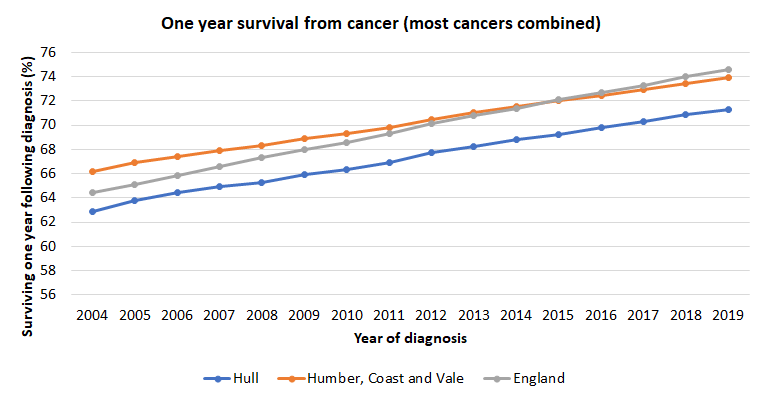
As NHS Digital state, a comparison should not be made is because of the difference in the incidence and survival rates for different cancer sites both between different geographical areas and any changes in incidence and survival over time which affect the value of the survival index. As detailed above, the incidence of lung cancer is much higher in Hull compared to England, and as this cancer has a particularly low survival rate compared to some other cancer sites, the percentage of lung cancer cases in Hull within this ‘index’ survival measure of cancer will be greater, and thus the value of the survival index will be lower. This could be one reason why the inequalities gap between Hull and England has increased over time with one year survival from cancer improving in Hull between 2004 and 2019, but not to the same extent as for England. If the percentage of lung cancers within all cancers considered within the survival index has increased over time in Hull then this may explain the observed pattern in the inequalities gap. If this were the case, it would be difficult to form conclusions as to the relative survival of cancer in Hull compared to England as one would not really be comparing like-with-like.
Lung Cancer
For cancers diagnosed between 2004 and 2013, one year survival from lung cancer has been consistently higher in Hull compared to England, but the percentage surviving one year for cancers diagnosed between 2014 and 2019 has been lower in Hull compared to England.
Over the entire period 2004 to 2019, there has been a substantial increase in the one year survival from lung cancer in Hull with the percentages increasing from 30.4% for cancers diagnosed during 2004 to 45.2% for cancers diagnosed during 2019. One year survival from lung cancer in Hull has increased by 14.8 percentage points or by 49% between 2004 and 2019.
For the latest period, for lung cancers diagn0sed during 2019, 45.2% survived one year in Hull c0mpared to 47.2% for England. So for every 100 people diagnosed with lung cancer in Hull, two more people survive to one year in England compared to Hull.
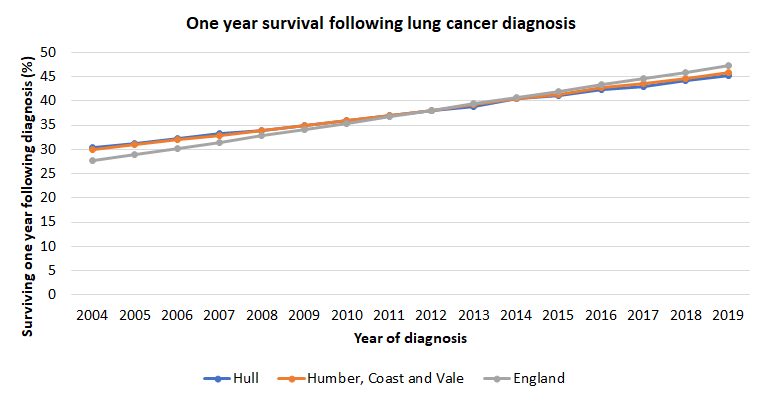
Colorectal Cancer
One year survival from colorectal cancer has increased over time in Hull by 6.5 percentage points or by 9% between 2004 and 2019. However, over the entire period the percentage surviving one year following colorectal cancer diagnosis was considerably lower than England, although the inequalities gap between Hull and England has reduced slightly over time. For colorectal cancers diagnosed during 2004, 70.8% survived one year in Hull compared to 75.4% for England (4.6 percentage points and 6.5% higher in England), but for cancers diagnosed during 2019, 77.3% survived one year in Hull compared to 80.9% for England (3.6 percentage points and 4.7% higher in England).
For the latest period, for colorectal cancers diagn0sed during 2019, 77.3% survived one year in Hull c0mpared to 80.9% for England. So for every 100 people diagnosed with colorectal cancer in Hull, 3-4 more people survive to one year in England compared to Hull.
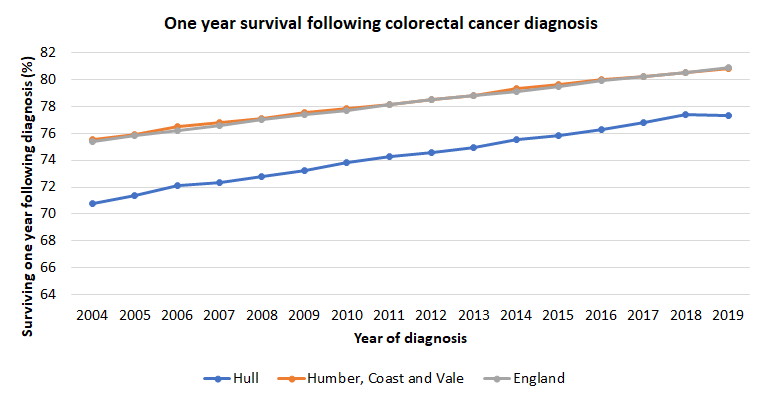
Breast Cancer
There have been relatively small increases in one year survival for breast cancer in Hull over the entire period 2004 to 2019, but one year survival has shown a continual increase across England.
The inequalities gap between Hull and England has increased over time for breast cancer one year survival. For breast cancers diagnosed during 2004, 93.5% survived one year in Hull compared to 94.3% for England (0.8 percentage points and 0.9% higher in England), but for cancers diagnosed during 2019, 94.1% survived one year in Hull compared to 97.3% for England (3.2 percentage points and 3.4% higher in England).
For the latest period, for breast cancers diagn0sed during 2019, 94.1% survived one year in Hull c0mpared to 97.3% for England. So for every 100 women diagnosed with breast cancer in Hull, three more women survive to one year in England compared to Hull.
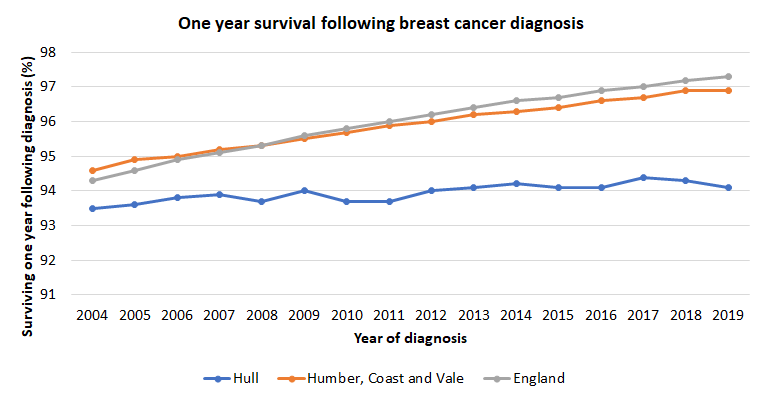
Strategic Need and Service Provision
All Cancers
It is necessary to work together to ensure people understand the benefit of positive life choices and know how to access information and seek early support to change. In order to do this effectively, health care organisations need to work together with different communities to use existing assets to realise the benefit of positive life changes, and treating people as individuals. In relation to poor diet, the family or household environment can have a strong influence, so any approach to improving diet which involves the entire family is more likely to have a better degree of success than dealing with just the individuals. People need to have the knowledge and confidence to cook cheap, healthy meals, and further education or training may be necessary to help with this. People need to be able to access good quality fresh fruit and vegetables. Maintaining a healthy weight and improving diet should be tackled using a life course whole system approach looking at a combination of strategies and settings.
Everybody should know the importance of early diagnosis, and should be encouraged to seek medical help early if they experience symptoms, and undertake screening for cancer when eligible. People need to know that stopping smoking has immediate health effects and substantially reduces the risk of most cancers within 5-10 years. Maintaining a healthy weight is also very important.
It is clear based on the information presented above in relation to the two-week wait, elective investigations, emergency presentations and stage of cancer at diagnosis, that people in Hull are more likely to present with their cancer in an emergency setting and later than people throughout the rest of England. This clearly has an impact on survival and mortality rates from cancer. Premature mortality rates are already high in Hull from preventable cancers, and from the high incidence of lung cancer due to high current and historical smoking levels in Hull.
Lung Cancer
Survival rates from most lung cancers are relatively low so prevention is extremely important. Not smoking should be seen as the norm, with the aim of creating a smoke free generation. It is necessary to work together to ensure people understand the benefit of positive life choices and know how to access information and seek early support to change. Health care providers need to work together within communities to realise the benefit of positive life changes. People need to know that stopping smoking has immediate health effects and substantially reduces the risk of lung cancer within 5-10 years, and that coughing up blood, pain when coughing, and persistent chest infections, breathlessness and a cough can be a sign of lung cancer.
Prostate Cancer
Men who are of African-Caribbean or African descent and men who have first degree male relatives affected by prostate cancer should be aware that they are at a slightly higher risk of developing prostate cancer. Men should also be aware of the symptoms (such as an increased need to urinate, straining while urinating and a feeling that the bladder has not fully emptied) and get promptly investigated, although such symptoms could be a sign of benign prostatic hyperplasia or prostate enlargement rather than cancer. Support should be given to men living with prostate cancer as, whilst they can live for decades without symptoms or needing treatment, it still can have an effect on their lives causing physical problems such as erectile dysfunction and urinary incontinence, as well causing anxiety and worry.
Breast Cancer
As mentioned above, a number of approaches are required to help people improve their diets, undertake physical activity and maintain a healthy weight.
As survival rates are high for most types of breast cancer provided it is detected in its early stages, it is vital that women check their breasts regularly for any changes and always get any changes examined by their GP. They should also attend screening when invited as this is the best available method of detecting an early breast lesion. Healthcare providers and women need to be aware that family history of breast cancer is an important risk factor, and that the National Institute for Health and Clinical Excellence have produced guidelines in relation to breast cancer screening for women with a family history of breast cancer.
Colorectal Cancer
As mentioned above, a number of approaches are required to help people improve their diets, undertake physical activity and maintain a healthy weight. With regard to colorectal cancer specifically, it is important that people are encouraged to participate in the screening programme and be aware of symptoms as early detection of cancer improves survival rates.
Resources
NHS. Cancer information and useful links. www.nhs.uk. 2014, NHS Choices: London.
Cancer Research UK, Why is early diagnosis important? www.cancerresearchuk.org. 2009, Cancer Research UK: London.
World Health Organisation, Early detection of cancer. www.who.int/cancer/detection/en/. 2015, World Health Organisation: Geneva.
Cancer Research UK, Ageing cells could be ticking cancer time bomb. www.cancerresearchuk.org. 2013, Cancer Research UK: London.
Cancer Research UK, Growing ageing population drives global cancer rise. www.cancerresearchuk.org. 2005, Cancer Research UK: London.
Action on Smoking and Health, Factsheet 02: Smoking Statistics: Illness and death. www.ash.org.uk. 2015, Action on Smoking and Health: London.
Newton, J.N., et al., Changes in health in England, with analysis by English regions and areas of deprivation, 1990-2013: a systematic analysis for the Global Burden of Disease Study 2013. The Lancet, 2015. 386(10010): p. 2257-2274.
NHS. Lung cancer – symptoms. www.nhs.uk. 2013, NHS Choices: London.
NHS. Prostate cancer. www.nhs.uk. 2015, NHS Choices: London.
NHS. Bowel cancer. www.nhs.uk. 2014, NHS Choices: London.
NHS. Breast cancer (female). www.nhs.uk. 2015, NHS Choices: London.
Cancer Research UK, Definite breast cancer risks. www.cancerresearchuk.org. 2014, Cancer Research UK: London.
National Institute for Health and Care Excellence, Familial breast cancer: Classification and care of people at risk of familial breast cancer and management of breast cancer and related risks in people with a family history of breast cancer. www.nice.org.uk. 2013, National Institute for Health and Care Excellence: London.
National Cancer Registration and Analysis Service: https://www.cancerdata.nhs.uk/
The Office for Health Improvement & Disparities’ Fingertips: https://fingertips.phe.org.uk/
Updates
This page was last updated / checked on 2 December 2025.
This page is due to be updated / checked in January 2026.